
|
Reformation
and
Civil War
1539-1699
Pre-
1539
|
Please click here to look back at times before the Dissolution of the Monasteries.
|
|

The abbot's final home
Quick links on this page
Kett's Rebellion 1549
Haverhill's two churches 1551
Lady Jane & Queen Mary 1553
England Catholic again 1555
England Protestant again 1559
Suffolk has own Sheriff 1576
Royal Progress to Norwich 1578
Spanish Armada 1588
Suffolk's Puritan clergy 1597
Gunpowder Plot 1605
Bury's first Charter 1606
Bury gets two MP's 1614
Hard times in Bury 1622
Laud attacks Puritans 1633
First Civil War 1642
Second Civil War 1648
King Charles I executed 1649
Restoration of Charles II 1660
Euston Hall society 1671
King now runs Corporation 1684
Glorious Revolution 1688
Celia Fiennes Tour 1698
Foot of Page 1699
|
|
1539
|
Prior to the Dissolution of the Monasteries the Abbot of the Abbey of St Edmund upheld the King's law and imposed, and collected, taxes in the whole of the area later to become West Suffolk. The Abbot also sat as a peer in Parliament. The last abbot, John Reeve, was given a pension, and may have lived his remaining days in this house in Crown Street. He died within a few months of the surrender of the abbey, and may never have received his generous pension of £333.
During the time of the abbey any form of local self determination by the townspeople of Bury existed solely through the Candlemas Guild and later the Guildhall Feoffment Trust.
The property of the Abbey of St Edmund was surrendered to the Crown on 4th November 1539 but much of the wealth had already been confiscated in the previous year. After the dissolution in 1539, the rights of the Abbot returned to the Crown. The government of the town was largely ignored by the new owners of the abbey lands and privileges, and any joint actions continued to be carried out through the Guildhall Feoffees, largely without any formal legal backing. Over the next hundred years local government would replace the Abbots' Rule, but religious differences would cause bitter divisions in the country.
However, the town had now lost the use of the great library of the abbey, the access to the several hospitals which the monks had run, the grammar school was closed, and the various charities and good works of the monks were suddenly gone. The poorest in society would suffer most from many of these changes.
The library of books at the abbey does not seem to have attracted much attention from collectors at the time, and M R James thought that they were mostly acquired by local Bury people. It would probably be 50 years before there was much interest in them from collectors. Many manuscripts may have simply been disposed of as waste materials.
Unlike many other towns in England at this time, Bury was growing and prospering. It did this largely independently of the Abbey's decline and eventual closure. It was getting a steady stream of immigration into its cloth trade, and Gottfried believed that its population had by this time regained its pre-plague levels. In 1340 the population was about 7,150, falling to 3,000 by 1440. It was back at 7,000 by 1540.
Local agriculture was highly productive, depending on Bury for its market, and as a marketing centre for onward distribution. The wool and cloth industry was booming, again using Bury market for distribution nationally and internationally. The Netherlands trade was particularly important. The local gentry were happy to be involved in town affairs.
In Lavenham, Ipswich, Hadleigh and Bergholt, the independent weavers were restless. They had been used to being independent men, negotiating their production rates with clothiers, and controlling their own workrates. Now they were losing money. The clothiers had begun to set up their own weavers with looms, and fixing their pay. The independent weavers raised a petition against these new practices. "For the rich men, the clothiers, be concluded and agreed among themselves to hold and pay one price for weaving, which price is too little to sustain households upon, working day and night, holy day and week day, and many weavers are reduced to the position of servants."
|
|
1540
|
The Liberty of St Edmund, covering the area of West suffolk, had been the barony of the Abbot of St Edmunds up to 1539. The Liberty now came under the control of the Crown. The Sheriff had never had a direct control over the area of the Liberty. Instead, there had been a Steward of the Liberty, at least since the days of William the Conqueror. At first this post was appointed by the crown, and later by the Abbot. The duties included returning writs to the Sheriff, apprehending and holding lawbreakers, and convening the Liberty and hundred courts. After about 1120 it seems to have become an hereditary post. By 1536 the post of Steward of the Liberty had passed into the hands of Thomas Howard, 3rd Duke of Norfolk. The word of the monarch now held sway in the Liberty, but the area continued to hold itself somewhat separate from the rest of Suffolk. This situation continued up until about 1970, and the hereditary Stewardship of the Liberty also continued until that time, although its importance was purely nominal by then.
There was also a post of Steward, or Under Steward, of the Liberty of Bury St Edmunds, covering the area of the town rather than the whole of West suffolk. The Steward of the Liberty appointed his own Under Stewards to carry out his judicial duties. By the 20th century the stewardship of the Liberty of St Edmund and the Bury St Edmunds liberty were both in the hands of the Marquess of Bristol.
King Henry VIII now began to convert the seized properties of the church into cash. The details of each sale were settled by the Court of Augmentations which was responsible for the disposal of former monastic lands for the crown. Nicholas Bacon was Solicitor to the Court of Augmentations from 1537 to 1546, and he had local connections. His father was Robert Bacon, of Drinkstone, Esquire and Sheep-reeve to the Abbey of Bury St. Edmunds.
In 1540, some of the major local transactions carried out by the Court were as follows:
- In 1540 Sir Thomas Kytson was still extending his landholdings, and he bought eight of the previously monastic manors in Suffolk. These were Fornham St Martin, Fornham St Genevieve, and Fornham All Saints, Chevington, Hargrave, Risby, Sextons Manor at Westley, and Monks Hall at Santon Downham. He paid the tremendous sum at the time of £3,710. Unlike many other rich men who became landed gentry by buying up the newly privatised monastic lands, Kytson had first put his wealth into property in Suffolk when he purchased Hengrave in 1521. He also acquired the manor of Great Barton.
Sir Thomas Kytson died at Hengrave Hall shortly after making these transactions. He had been a rich wool merchant, trading in Flanders, and had built Hengrave Hall on the proceeds from 1525 to 1538. The house was left to his wife, Margaret, and his only son, also called Thomas, who was born soon after his death.
-
The manor of West Stow was bought from the crown by Sir John Croftes of that parish. Sir John was a substantial sheep farmer (flockmaster) who had leased the manor and lands in West Stow from the Abbot of Bury St Edmunds in 1526. He had made improvements to the old manor house, including the addition of the magnificant gatehouse in 1530, which still stands today. He must have been pleased to to be able to purchase the manor house and lands for £497.
-
Sir Thomas Jermyn of Rushbrooke bought the manors of Stanton All Saints and Bradfield St George from the crown.
-
Nicholas Bacon bought Ingham for £488 from the Crown.
- Thomas Bacon of Hessett bought the Manor of Hessett for £249.
- According to Sir John Cullum's History of Hawstead, Sir William Drury acquired the manor of Whepsted from the crown at this time. This manor was next to his holdings in Hawstead.
- The Drury family also acquired the manor of Hencote which was near to Hawstead around this time.
- The manor of Hardwick was granted to Sir Thomas Darcy, who was Lord Darcy of Chiche, as part of the monastic disposals, although the exact year is unclear. Hardwick would then pass through several hands before it would be bought by Sir Robert Drury in 1610.
More sales would follow in future years.
One of the disposessed monks of Bury Abbey, Thomas Hall, became Rector of Tuddenham St Mary. Dr Brinckley who had been the Warden of the Babwell Franciscan Friary, became Rector of Great Moulton in Norfolk. Ex-nuns may have found it harder to find work. They could not be ordained. The last Prioress of Thetford St George was Elizabeth Hoth. She had to move to Norwich to find a position.
The Bury born Bishop of Winchester, Stephen Gardiner, was a power in the land. In 1540, following the death of Thomas Cromwell, he was elected chancellor of the University of Cambridge. He was educated at Trinity College, and had been its Master since 1525.
He had achieved much of his early rise due to the patronage of the Duke of Norfolk, who had introduced him to Cardinal Wolsey. The Duke of Norfolk now persuaded Gardiner to support the idea of his niece, Katherine Howard, becoming Henry VIII's fifth wife.
|
|
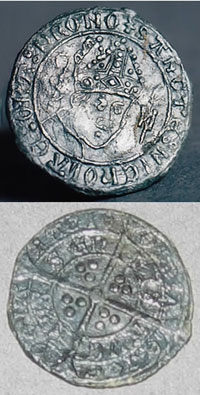
Boy Bishop token
|
|
1541
|
More old church ceremonies were banned, including the Boy Bishop ceremonies widespread in Suffolk each December. During the Middle Ages it had been customary for churches and abbeys to elect a choirboy as Boy Bishop. He held office from St. Nicholas' Day (December 6th), to Childermas, (December 28th) also known as Holy Innocents' Day, when he usually preached a sermon and then "resigned". As a souvenir, the boy was apparently given a lead token, but in some places he was also given a supply of such tokens to hand out to his "congregation", as alms.
In England, the main centre of both production and use of these tokens seems to have been Bury St Edmunds, although they were issued in many places on the continent. In Bury the Boy Bishop was in existence by 1418, but the first tokens seem to have been issued from about 1480. They were distributed by the Boy Bishop and probably exchanged for sweetmeats or alms at the Abbey almonry or by charitable local merchants. The distribution of their findspots suggests that they were also used as small change.
Although now officially banned, this ceremony and related lead tokens seems to have been revived on a few occasions over the next few years.
In the sixteenth century the town of Haverhill continued to flourish. It obtained a royal connection on 27th January 1541, when the parsonage, lands and right to appoint clergy were granted to Henry VIII's fourth, and recently divorced wife Anne of Cleves.
Anne of Cleves, the fourth wife of Henry VIII, arrived in England in 1539 and married the King in 1540, though the marriage was never consummated. By July she was officially divorced. In January 1541, she was given the parsonage house at Haverhill and the right to appoint clergy. She also received a large amount of property in Sussex, Essex and other counties. She never came to Haverhill, preferring to live at Lewes, Sussex. It is probable that the parsonage given to Anne was burnt down in the fire in Haverhill in 1667. The house which today bears her name and is probably the finest building in the town today, was built in 1480, and did not become a vicarage until much later. It seemed to acquire the name of Anne of Cleves House as late as 1967, when it was put up for sale by an enterprising estate agent. It was recently occupied by American security firm HID Corporation Limited, but was on the market again in 2002.
The manor of Culford was bought from the crown by Christopher Coote, a Norfolk gentleman.
The manor of Lakenheath was granted back to the Dean and Chapter of Ely cathedral.
|
|
1542
|
In February, 1542, the Queen, Catherine Howard, was executed for adultery. Several of the Howard family were also arrested. The Duke of Norfolk was likewise out of favour with the King, but not arrested at this time.
War broke out with Scotland. The king could not wait for the rental cash flow to come through from his new monastic holdings. He had to sell it off to capitalise on it, to get enough to pay for war. So the great sell off continued. The Court of Augmentations which ran the process for the crown now went into overdrive. There were a flood of sales frm 1542 to 1547. Officials of the Court, like Sir Nicholas Bacon, became vastly rich during this process.
Sir Anthony Wingfield bought the Haberdon Manor at Bury from the crown.
Since 1500, prices had been increasing. However, the level of inflation rose dramatically around 1542 and would remain high for another 10 years. Some people believed that the continued enclosure of land for sheep farming reduced the supply of arable crops and thus pushed up prices. The Earl of Hertford, (later Lord Somerset) tended to be against enclosure and was lenient when enclosure fences were torn down by dispossessed farmers and labourers.
To make matters worse there were a series of droughts in the 1540's, and the resulting food shortages pushed prices up further. In 1542 the Thames dried up to a trickle, followed by widespread crop failures and many small farmers were forced out of business.
|
|
1543
|
If war with Scotland was not expensive enough, war with France came a year later in 1543.
The dry weather continued and rivers dwindled even further. A fire at Reepham in Norfolk consumed one church and most of the High Street, as the river was nearly dry and there was no water to extinguish it. Throughout the region starvation became a threat. Copernicus published a theory that the earth revolved round the sun, having studied the planets through a telescope which he had built.
On July 12th the King married Catherine Parr, his sixth and final, wife. The marriage ceremony was performed by the Bishop of Winchester, the Bury born Stephen Gardiner.
|
|

Nicholas Bacon
|
|
1544
|
Many of the former monastic lands came on the market as the King continued to cash in on his new assets. For this he relied upon the advice of the Court of Augmentations, set up under Nicholas Bacon to dispose of surplus monastic property. The King granted John Eyer, Receiver General in the County of Suffolk over 50 parcels of monastic land and property. As Receiver General, Eyer had to collect all the rents from the former Monastic property throughout Suffolk and Norfolk. This grant included all the rents due on the land and included the right to carry on collecting the old hadgovel rents, or ground rents, first granted to the monastery of St Edmund at least as far back as the Norman Conquest, and possibly earlier. Hadgovel was paid on property inside the town walls, while the farmland outside the walls was subject to a payment called Landmole. Hadgovel seems to have been one penny a measure of land per year, while Landmole was one penny per acre per half year. Thus the tenants on land merely got a new landlord, they did not get set free of their old duties. Many of these dues had been the cause of civil unrest under the rule of the abbey, and these burdens were now to continue, but now paid to secular landlords.
John Eyer was one of many who profited from the patronage of Sir Nicholas Bacon, a barrister connected to Drinkstone, just outside Bury, who also became a great land owner in the area. Nicholas Bacon was born at Chislehurst, in Kent, in 1509. He was of non-aristocratic but comfortable origins, the second son of Robert Bacon, of Drinkstone, in Suffolk, Esquire and Sheep-reeve to the Abbey of Bury St. Edmunds. He took a degree at Corpus Christi college, Cambridge in 1527. Nicholas Bacon was Solicitor to the Court of Augmentations from 1537 to 1546, which was responsible for the disposal of former monastic lands for the crown. Thus he was well placed to help his friends get land grants. When we use the term grant, this is not meant to mean that it was given away for free. Nearly all such monastic land was, in reality, sold to the highest bidder, or to those who were in the know. Eyer had to pay £675 8s 10d for this land plus parcels in the three neighbouring counties.
In 1544 Nicholas Bacon bought the former monastic manors of Redgrave and Rickinghall Inferior, the latter for £785. Bacon also acquired St Saviour's hospital in Bury, and because it was by now in bad disrepair, used it for building materials for his new house in Redgrave. At an unknown date he also bought Mildenhall.
Thomas Bacon of Hessett bought Netherhall Manor at Pakenham for £599.
Adam Winthrop, a London clothier, obtained the manor of Groton from the crown for £409. The family would play a part in the history of America in later years.
In 1544 both of Henry VIII's daughters, Mary and Elizabeth, were reinstated to the royal succession.
|
|
1545
|
Having taken over the possessions of the monasteries and abbeys, the various religious and social guilds in the country were dissolved and their possessions confiscated by the Crown. The Candlemas Guild was therefore dissolved but the Feoffees continued with their secular work. They tried to maintain hold of as many of their endowments as possible when the Guild was dispossessed.
On the passing of the act of parliament in 1545 enabling the king to dissolve guilds and their and colleges, Matthew Parker was appointed one of the commissioners for Cambridge. He was Master of Corpus Christi College and the Commissioners' favourable report may have saved the Cambridge colleges from destruction. Stoke By Clare College, however, was dissolved in the following reign. Parker had also been its Master and would receive a generous pension.
In Bury the Guildhall Feoffees tended to organise any public works that were needed. In other places such as Ixworth it was often left to the wills of better off individuals. Hugh Baker left 40 shillings in his will to make one bridge of lime and stone at the mill at Ixworth.
At Redgrave, Sir Nicholas Bacon began building Redgrave Hall, which would take until 1554, and cost him £1,253. Some of the materials came from demolishing the much run down St Saviours Hospital in Bury. Bacon was the solicitor to the Court of Augmentations, which was set up in 1536 to manage and dispose of former monastic holdings for the crown.
Nicholas Bacon also acquired Hinderclay and Wortham Abbots in 1545 from the crown. He paid £488.
Henry Payne, a lawyer from Bury st Edmunds, was granted the manor of Nowton for £648.
Among his many purchases of former monastic estates, Thomas Howard, Third Duke of Norfolk bought Rougham Hall manor for £1,651.
Sir Thomas Jermyn of Rushbrooke bought the manor of Rougham Eldo from the crown.
Robert Spring got Pakenham Manor from the crown for £1,432.
|
|
1546
|
Other monastic properties in and around Bury were granted to John and Andrew Manfield, and other disposals continued through to the 1570's. Eyer in particular began to sell off many of his scattered holdings and over the next 50 years there was much buying up of newly available property by adjacent owners in order to consolidate holdings and redevelop larger properties. The Abbey had by and large held on to anything it owned, making it difficult for much property exchange to take place until after 1539.
Other local gentry to buy up three or more monastic manors were Sir William Drury of Hawstead and Sir Thomas Jermyn of Rushbrooke. Jermyn himself spent over £1,000 on these, as did Robert Spring of Lavenham.
The manors of Hardwick and Horringer Magna were bought by Thomas Darcy, Lord Darcy of Chiche. He had bought Horringer Parva already, in 1540. Darcy would soon sell Horringer to the Jermyns of Rushbrooke.
Nicholas Rookwood of Lawshall bought the manor of Livermere Grange from the crown.
Other monastic lands were leased. For example the manor of Melford and Melford Hall, was leased to William Cordell, a Melford man and a rising solicitor.
In 1546 Sir Nicholas Bacon ceased to be the Solicitor to the Court of Augmentations. He got more monastic lands outside Suffolk and became Attorney to the Court of Wards and Liveries.
|
|
1547
|
Following the Act of Parliament in 1545 abolishing religious and social guilds, a further Act in 1547 extended the ban to the Chantries. These were usually small chapels with a resident or visiting priest, which wealthy men had established to ensure that prayers would be said for their souls. It was believed that this was a way to shorten the time that their souls were held in Purgatory.
When the Chantries were abolished, their lands and assets were seized by the Crown. This included a number of buildings in Bury St Edmunds, left to the town by beneficiaries like Jankyn Smythe and Margaret Odeham. Some of the chantries established for the souls of the deceased were intertwined with monies also left for the maintenance of almshouses and the relief of the poor. Without the income from some of these lands, there was no money for the poor relief, and something had to be done.
Henry VIII died on January 28th 1547 at the age of 56, having reigned over 37 years. His requiem mass was led by Stephen Gardiner, the Bury born Bishop of Winchester. He left only one young son, King Edward VI, who became king aged 8 years. King Henry's break with the Roman Church and the dissolution of the monastic system had been the greatest social upheaval in hundreds of years. Henry VIII had taken over monastic lands and made some Reformation of the Church, but he feared to go too far to avoid civil unrest. He did not want a repeat of the Pilgrimage of Grace of 1536.
Having taken over the Church's lands, Henry VIII had sold off about two thirds of all monastic holdings by 1547. Most of the £780,000 raised had gone on military supplies and soldiers' wages. About 1,000 people had acquired 1,593 grants of land. They had all paid for this except for only 41 grants known to be gifts. Sales were made at 20 years purchase, which is a high price if the net annual values were correctly calculated. (ie if the property made an income of £20 a year, you could buy it for £400.)
Troston Manor was bought off the crown by Thomas Bacon of Hessett, but there were few manors left to sell by this time.
In his will, Henry VIII appointed a Council of 16 equal ministers to rule during Edward VI's minority. However, Edward Seymour, Earl of Hertford, declared himself Lord Protector of the Realm.
Edward Seymour soon promoted himself to Duke of Somerset, and unwittingly made himself the focus of discontent, as he at first seemed to tolerate the enclosure riots and sympathised with the protestors' grievances.
In his later years King Henry VIII had backed away from further Protestant reforms. His infamous Six Articles of 1539 had been a re-introduction of Catholic doctrine, but under himself as Supreme Head of the Church.
Under the new king, Henry's policies were reversed and the Second Reformation of the English Church began. First came The chantries Act of 1547 that dissolved all the secular colleges and religious guilds, as well as the Chantries. This was important for Bury as it possessed one of England's 140 secular Colleges. This was the College of Jesus founded by Jankyn Smythe. It would close in 1548. A similar college at Stoke by Clare closed in that same year, despite the fact that Matthew Parker, Vice Chancellor of Cambridge University, was its Master.
Also to close, and its endowment properties sold off, was the Chantry College of Denston, founded in 1475 by John Denston, and located within St Nicholas' Church at Denston. As this was also the parish church, the church itself survived the confiscations.
It is possible that there was a College of secular priests at Chevington, but there seem to be no records. College Farm and College Green still exist in the village. The church records for 1595 record a "Henry Paman of the college, deceased."
Injunctions of July 1547 ordered the destruction of all shrines, paintings and pictures of saints.
These Protestant Reforms were opposed by the Bishop of Winchester, Stephen Gardiner. He had played perhaps the biggest part in drawing up Henry VIII's Six Articles, and he remained true to their principles. Gardiner, who was born in Bury, fell out of favour, and was thrown into prison. At first he was in Fleet Prison, but following an enquiry, was moved into the Tower of London, where he stayed throughout the reign of Edward VI. In 1555 he was formally removed from the office of Bishop of Winchester.
Thomas Howard, the Catholic third Duke of Norfolk, was also imprisoned in the Tower, although in his case, he was probably already going to be arrested by Henry VIII on a charge of treason.
|
|
1548
|
At Bury St Edmunds, the plight of the town's poor was becoming critical following upon the Crown seizure of the chantry buildings and associated lands. The parishioners and church wardens of both the town's churches agreed to sell off the silver and gold plate used in church services to produce assets which would provide the income needed to support the parish churches and their charitable endeavours. The plate of the parish churches of St Mary's and St James was duly sold off and raised the goodly sum of £480.
It was duly agreed to buy the chantries of Margaret Odeham and Mr Beckett, and the gilds of St Nicholas and St Botolph, together with other lands which had been supporting the Morrow Mass Priests of St James' Church.
The Seymour brothers Thomas and Edward were hungry for power. Thomas was jealous of his brother Edward who had made himself Lord Somerset. Katherine Parr married Thomas who thus became stepfather and guardian to Elizabeth. He was 40, she 14. After Katherine Parr died following childbirth, Thomas Seymour wooed Elizabeth. In May, Lord Somerset granted a pardon to rioters in Cornwall who had risen up in the last months of the old King's reign against the enclosure of the commons. Anti-enclosure riots were spreading nation-wide and several other pardons were granted. Rioters grew bolder as they began to get their way.
At church, the Reformation continued.
In February 1548 the Privy Council ordered the removal of all religious images from churches.
|
|
1549
|
The Crown now sold the chantries of Margaret Odeham and Mr Beckett, and the gilds of St Nicholas and St Botolph, together with other lands, to Feoffees in Bury St Edmunds. These were to be a body of 24 of the most discreet and substantial persons of the town, with 12 drawn from each of the two parishes. The sale of church plate in the previous year had provided the money for the purchase, but the Guildhall Feoffees would decide how to make use of the lands acquired, the rents payable, and the usage of those rents. The control of these lands by such a narrow body of wealthy and conservative men would become an issue in future years.
In a list of Charities belonging to the Borough in the council yearbook for 1896/97 this purchase was known as "The Town Estate", and "consisted of certain lands and tenements in Skinner's Row, Baxter Street, Northgate Street, the Great Market Place, Garland Street, Horringer and Westley, and the Guilds of St Nicholas and St Botolph, which had become forfeited to the Crown, being devised for 'Superstitious Purposes', and were by deed dated 26th August, 1548, purchased of the Crown by Trustees with money raised by the sale of church plate, for the charitable and other purposes mentioned in the deed.
Thomas Seymour was arrested after killing one of the king's dogs in strange circumstances in the King's apartments, and suspicion also fell on Elizabeth. In March 1549 Somerset signed his brother's death warrant.
By 1549 anti-enclosure riots were commonplace amidst the economic and religious turmoil of the times. Events were moving faster than the Council of Ministers could address any reforms, such as the commissions on enclosures.
There was an increase in the reformation of church practices. All images and shrines were now banned as were processions and elaborate church equipment. Services were to be in English. Another Act allowed priests to marry, and in Suffolk probably about a quarter eventually married.
In Cornwall there had been several tense years when the religious reformation was pressed home too harshly. A rumour in 1549 that a new English prayer book was to brought in at Whitsun, caused a rebel camp to be set up. The First Act of Uniformity was duly passed in 1549 and made the first English language prayer book the required basis for church services. This was the Book of Common Prayer, a first national imprint of Protestantism. The rebels laid siege to Exeter in July and Lord Somerset sent a force to contain the situation. The situation was looking grim when another major rebellion appeared in East Anglia.
The East Anglian Uprising, known as Kett's Rebellion, started in Wymondham in July when enclosure fences were torn down. Robert Kett became involved when the mob turned their attacks onto his enclosure fences. Robert Kett was an unlikely man to lead an uprising. He was a 57 year old well-to-do merchant and landowner. Kett listened to the grievances of the crowd, and even helped them tear down his own fences. He then led them on to attack those of John Flowerdew, an old enemy of Kett's. On July 9th the mob, led by Kett, decided on a 9 mile protest march to Norwich, circling the city to rest overnight at Bowthorpe, 2 miles north west of the city walls. They pulled down the fences of the "town close", or former common of Norwich. A few days later they had moved to Mousehold Heath, an area of high ground to the east of the city of Norwich honeycombed with chalk and flint mines, but overlooking the city. Almost by accident a great rebel camp was set up here, and new recruits poured into it.
By mid-July another camp was set up a Ryston, just outside Downham Market. Soon a camp was established at Brandon, another at Bury St Edmunds, and on 14th July a major camp was set up outside Ipswich. The Ipswich camp was quickly moved to Melton, near Woodbridge.
Unlike the Cornish rebels, the East Anglians favoured the new English Prayer Book and adopted its use. They also issued proclamations and set themselves up as an alternative local government to that available from the gentry. The rebels, however, still saw themselves as supporters of the crown, but were vehemently against the excesses of the landed gentry. They drew up a list of 29 demands, many of them to do with enclosure of common land and the current high prices. Unfortunately the official response was high handed and only caused to provoke the rebels to stiffen their resolve. When the lists were rejected by the Crown the city of Norwich decided to have no more to do with the Great Camp, and shut its gates, and manned its walls.
Thus, with Norwich now closed to them, the rebels attacked Norwich on July 21st, and succeeded in storming it next day. They returned to camp with prisoners, arms and looted supplies, and sat there for ten days.
On 31st July the Royal Army finally arrived although only 1,500 strong, and was allowed to retake the city of Norwich, where they were harried by various skirmishes. Following the death of Lord Sheffield in one battle, the army withdrew to Cambridge.
On August 17th a rebel force took Lowestoft in their second or third abortive attempt to capture Great Yarmouth, the second largest town in Norfolk. By this time a much larger Royal Army, of over 10,000 men, was mustered in London, and they set out for Norfolk. The army was led by John Dudley, the Earl of Warwick, and by 24th August they were at Norwich.
Although the actual site of the rebel camp at Bury St Edmunds is no longer known, it is believed to have been the major rebel centre for West Suffolk. It was probably abandoned either as the Earl of Warwick's army approached from London, or because the Suffolk gentry managed to placate them without the antagonisms which provoked the camp at Norwich.
When Warwick broke into Norwich on 24th August, there followed a great deal of street fighting back and forth until the rebels retreated to bombard the city for 2 days from Mousehold Heath.
Some 1,500 Royalist cavalry reinforcements now arrived at Norwich. The rebels moved to the plain at Dussindale for a final battle about 2 miles east of the city centre on 27th August. Robert Kett probably had 10-15,000 men and around 20 cannon. Warwick had 6,000 trained men, mostly cavalry men, largely foreign mercenaries, with another 6,000 left holding Norwich. He had fewer cannon but more experienced gunners, and he had 200 hand gunners. Once the rebel field guns were destroyed by the royal artillery, the cavalry spearheaded the victory. About 3,000 men died, mostly rebels. Robert Kett was captured next day as was his brother William.
In the next few months, Lord Protector Somerset was overthrown and replaced as head of the Great Council by the Earl of Warwick, the victor of Norwich.
On November 26th, 1549, the Kett brothers were sentenced to death and on 7th December, William Kett was hanged at Wymondham and Robert Kett was hanged on the walls of Norwich Castle.
Thus did a protest march turn into bloody confrontation and death, each escalation seeming to occur without being clearly planned, or the consequences thought through.
The memory of "camping time" and the savage reaction to it by the authorities left widespread resentment in East Anglia for years to come. The area would continue to raise radicals and dissenters for years to come.
|
|

Ancient House
|
|
1550
|
Since the Dissolution in 1539, the monastic grammar school at Bury had been apparently closed and dispossessed. The townspeople had to petition the crown to get a replacement school lawfully established. Finally, in 1550, King Edward VI founded a new grammar school at Bury. From 1550 to 1665 this school was probably situated on the site of Ancient House in Eastgate Street, on the corner of Barn Lane. There is a plaque on the wall commemorating this school. The building was formerly the Guildhall of the Guilds of St Thomas, Assumption of the Blessed Virgin Mary, and St Peter.
King Edward VI was a strong Protestant, and was also responsible for the destruction of many books surviving from monastic days on the grounds that they contained superstitious images and ideas from the Papist era. In 1550 Injunctions were passed which even ordered the removal of alters from Parish Churches. Simple tables could replace them, provided they were not on the same positions.
The site of Bury's Abbey was leased by the crown to Sir Anthony Wingfield, a Suffolk man. He had been Sheriff of Suffolk and Norfolk in 1515-16, and a member of Parliament for Suffolk in 1529-35.
|
|
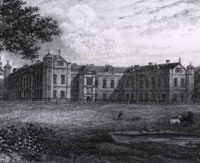
Rushbrook Hall in the 19th Century
|
|
blank |
It is not definitely known who built the first major residence on the site of Rushbrook Hall, but it has been credited to Edmund (Roberts) or Sir Thomas (Statham) Jermyn around 1550, and also apparently to a later date of about 1575, by Sir Robert Jermyn. This is the period when great houses were being built in a U or E shape, and E is the shape of Rushbrook. It was built in the older moated style.
The climate has not always been just as we experience it today. We all know about the Ice Age which was thousands of years in the past, but from about 1550 to around 1850 there was a cooler period, sometimes called the Little Ice Age. Prior to this time there had been a warmer period, called the Medieval Warm Period, from about 800 to about 1300.
After the mid 1500's there were colder winters than we are used to today, with great hardship for man and beast.
|
|
1551
|
In 1551, the people of Haverhill petitioned the King that the old St Marys church (previously referred to as St Botolphs) at Burton End be abandoned, and it was pulled down. Nothing of the original Burton End settlement now remains, though an excavation carried out in 1997 by the Hertford Archaeological Trust, uncovered many ancient skeletons and funeral relics. Pigot's Directory of Suffolk for 1830 stated that ruins of this church were still visible at that time.
May 12th 1551 "...Whereas the inhabitants of Haverhille, Suffolk, have informed the King that of the two churches in that town that the one called the Overchurche is too small to hold all the parishioners and is difficult to access; whereas the other church called Netherchurch (St Marys) is large enough for all and conveniently situated, that the inhabitants are not able to repair and maintain two churches and the Netherchurche shall then be the parish church of the whole town, and its rector shall have the tithes and profits previously enjoyed by the Rector of the Overchurche."
There is a plaque in the St James's Church at Bury recording that King Edward VI contributed £200 for the completion of the work on the nave, which had been going on since 1503.
In London, the Earl of Warwick, John Dudley, made himself Duke of Northumberland.
|
|
1552
|
Parliament passed the Second Act of Uniformity. Church attendance was made compulsory on Sundays.
A second new Prayer Book was introduced. Church vestments were already banned and alters had been replaced by tables in the previous year. The ancient Mass was effectively now replaced by a Protestant Holy Communion.
Sir Thomas Jermyn died at his newly built home at Rushbrooke hall. The family was Puritan in religion and there would be 16 generations born at Rushbrooke.
The Clothing Act of 1551-52 sought to impose further rules upon the production and sale of cloth. It was intended to stop the production of a range of inferior products and so imposed a comprehensive set of rules governing all cloth types, specifying compulsory sizes and weights of all types of cloth from Suffolk, Norfolk and Essex. The colours allowed were also specified, as were many of the methods of production which were now outlawed. Town inspectors had to seal the cloths with an "F" and charge 2d a piece for doing so. Local clothiers complained that their main competitors, the Dutch, suffered no such restrictions, and Dutch cloths were becoming more and more into fashion. These Dutch weavers were immigrants from The Low Countries, who were all Protestants, who could not continue to thrive under the Spanish Catholic rule there. The lead seals used by the Dutch clothiers were trusted to be accurate as these people became highly regarded for proberty and honest dealings.
|
|
1553
|
By 1553 the 15 year old King Edward VI was dying of TB. He was an enthusiastic Protestant and, on his deathbed, disinherited his Catholic sister Mary to avoid his reforms being reversed. The English church was totally reformed by now, both in the destruction of statues and decorations, and in the forms of worship. In 1553 Thomas Cranmer issued his Forty Two Articles of Religion which gave the English Church its final Protestant Theology. The legality of this act of disinheritance was questionable, and many people thought it the result of a plot. King Edward VI died on July 8th.
This was a time of intense rumour and speculation. Lady Jane Grey was the daughter of a cousin of the king, only 15 years old, and was born in the same month and year as Edward VI. She was the daughter of Henry Grey, the Duke of Suffolk. His wife was Frances Brandon, a cousin of King Edward VI. It was said that John Dudley, the Duke of Northumberland, was behind the plan to replace Mary by Lady Jane. His son Guilford had been married to Lady Jane only two months previously, and now he ordered the Tower of London to be fortified, and was expected to seize Lady Mary. It was also rumoured that the king had died on July 6th, but the news was suppressed by Northumberland for two days, while he put his plans into effect.
Mary, a mature woman of 37, was at home in Hunsdon in Hertfordshire when news of the king's decision arrived, but rather than obey the summons to what she believed was imprisonment, she fled to Cambridgeshire. On 9th July she wrote to the Council in London asking for their allegiance as the true Queen. From there she went to the home of the Duke of Norfolk at Kenninghall in Norfolk. Norfolk had been imprisoned by both Henry VIII and Edward VI, because of his Catholic beliefs. His properties at Kenninghall and Framlingham had been passed to Mary. Sir William Drury of Hawstead took 100 men to Kenninghall to assist Mary.
On 11th July the Sheriff of Norfolk and Suffolk, Sir Thomas Cornwallis, with other local nobles, joined Ipswich Town Council in declaring Lady Jane Grey, the Queen of England. The people of the town were much less enthusiastic, and there were some disturbances. John Dudley, Duke of Northumberland, was not popular in East Anglia, having been involved in the bloody suppression of Kett's protest camp in 1549, when he was the Earl of Warwick. By this time, John Dudley was in possession of the manor of Great Barton, for in 1553 he now exchanged it for the manor of Drayton Bassett. Thus did Great Barton apparently pass into the property of Thomas Audley. Great Barton would remain in the Audley family until 1706.
On 12th July, Mary moved from Kenninghall to the great castle at Framlingham. The Sheriff, Cornwallis, now relented his position and joined Mary's side.
By 14th July Norwich declared for Mary, and a throng of local nobility joined her at Framlingham.
Sir William Drury of Hawstead Place swore allegiance to Mary as Queen on 17th July. Mary ordered all captains to bring their men to muster under Sir William Drury and Sir William Waldegrave.
Mary Tudor was the rightful Queen in the eyes of much of the country, and poor manipulated Queen Jane was to reign for only nine days. Sir Henry Bedingfield had marched from Norfolk to Framlingham. Most of the East Suffolk nobles now supported Mary. They even turned the naval ships laying in Orwell Haven to cut off Mary's escape, into her supporters. Some 10,000 men were now in Framlingham to support her cause, camped in and around a small town of usually only 600 people.
At this time the Duke of Northumberland's army had left London and was marching to confront Lady Mary, via Cambridge.
|
|

Queen Mary
|
|
blank |
Mary was proclaimed Queen on July 19th 1553 by the Privy Council in London. With Northumberland's army out of London they could see that she had widespread support, and admitted they had been in error. The Lord Mayor and Aldermen of the city proclaimed Mary the true Queen along with the Duke of Arundel, by public proclamation. They now put out a reward for the capture of Northumberland. Northumberland's army was now refusing to proceed past St Edmundsbury because of the size of the army waiting for them at Framlingham. Many were deserting Queen Jane's cause.
The Duke of Suffolk was now vigorously turning against Jane, despite the fact that she was his daughter, and even tore down her banner with his own hands, said she was no longer queen, and ordered his men to disarm.
The population of London went wild with joy at this news.
On 20th July many of the Council, including Arundel, had ridden to Framlingham to pledge allegiance to Mary, and to beg for forgiveness for ever supporting Jane. Sir William Waldegrave was there from Bury in her support, and even protestants like Edward Withipoll of Ipswich were now in Framlingham to pay court. By now, Northumberland's army had reached Bury, and the Framlingham army was mustered to attack them. In the event Northumberland retreated, and a smaller band went in pursuit of him and any supporters they could find.
On 24th July Queen Mary left Framlingham to proceed with a large company to London. They took the road to Saxmundham, turned towards Parham, and headed to Ipswich. The Queen stayed overnight at Humphrey Wingfield's house in Tacket Street. After a day's rest, they rode to Colchester. Over the next few days they travelled to Boreham, Ingatestone Hall, and on to Havering, where Lady Elizabeth, Mary's sister, came to pledge loyalty. Elizabeth was only 17, and must have felt in some danger as she was just as Protestant as Edward VI had been.
Mary entered London as Queen on August 3rd, 1553. On 10th August she released some of the prisoners held in the Tower who held Catholic beliefs, notably Thomas Howard, the Duke of Norfolk, and Stephen Gardiner, the Bury born former Bishop of Winchester. Thomas Howard was made Lord Marshal, and by the end of August, he had presided over the trial and execution of John Dudley, the Duke of Northumberland.
Queen Mary would reign for only five years until 17th November 1558. She came to the throne on a wave of popular support, but would leave it almost universally despised. She now set about a Catholic revival, while promising freedom of worship.
The First Statute of Repeal was passed by Parliament which repealed all of Edward VI's protestant legislation.
Within days the churches in the City of London had alters and crucifixes installed. Nicholas Ridley was thrown into the Tower, and Stephen Gardiner replaced John Ponet as Bishop of Winchester. Stephen Gardiner also became her Lord Chancellor. He was a devout Catholic, and was the son of John Gardiner, a Bury St Edmunds Clothmaker. Like Nicholas Bacon, also of Bury origins, he probably helped the town by minimising the impact of the dissolution of the guilds, and helped the feoffees.
Queen Mary appointed William Cordell of Melford Hall as Solicitor General and a member of her Privy Council. William Cordell had already risen to dizzy heights from his origins at Melford, but would go on to do better. His father is believed to be a John Cordell, who was Steward for the Clopton family at Kentwell Hall in Melford. Such was his new position that the Queen would be prepared to grant him the freehold of Melford Hall in 1554, a property which he had previously leased from the crown.
Sir William Drury of Hawstead became a Privy Councillor to Queen Mary some time in the autumn and was one of those charged to survey the ordnance and stores. Drury augmented his inheritance of seven Suffolk manors by grant, marriage and purchase. Two of his acquisitions, Lawshall and Whepstead, both in Suffolk, were confirmed to him by Mary to hold in chief on his surrender of an annuity of 100 marks awarded him in Nov 1553 for his services during the succession crisis.
Many prominent protestants now left the country, all within a matter of three weeks. In a few more weeks many prominent men throughout the land were replaced in public offices by Catholics. Queen Mary replaced all of the religious provisions of both Henry VII and Edward VI's reign. Churches were ordered to re-equip for Catholic worship and the old services reinstated.
Queen Mary's sister, Elizabeth was noticeably protestant and tried to avoid attending Mass and Mary became intensely suspicious of her.
By November, Mary wanted to marry Philip of Spain amidst general public protest. Parliament had recommended an English Lord, the Duke of Devon, but the queen favoured the suggestion of the Emperor Charles V, that she should marry his son Philip, the heir to the throne of Spain.
A key player in Queen Mary's bid to restore Catholicism in England, Sir William Drury was ordered to search the house of Thomas Pooley of Icklingham who was leading a Protestant revolt against the Queen's proposed marriage to King Felipe of Spain.
|
|
1554
|
In January, Sir Thomas Wyatt raised an army of 4,000 men in Kent in an attempt to stop the Spanish marriage, and in protest against the removal of the reformed faith. They reached London where they met the Duke of Norfolk defending the city. Many of Norfolk's own troops went over to Wyatt's side. Queen Mary herself turned out to rally Londoners to her cause, and confronted the rebels at Charing Cross, where Wyatt and many of his supporters were arrested. Within a few weeks Wyatt's protest had failed.
Mary was now convinced that a crack down was needed, and hundreds of Wyatt's followers were hanged. In February Lady Jane Grey was executed along with her husband, Guilford Dudley, and the Duke of Suffolk, Henry Grey, her father. The Queen's sister, Lady Elizabeth was sent to the tower under suspicion of supporting this revolt. She was there eight weeks in fear of execution. Sir Henry Bedingfield then took her to Woodstock Park under lock and key for a year.
By April, Thomas Cranmer, (previously Archbishop of Canterbury), Nicholas Ridley, (lately Bishop of London), and Edward Latimer were under arrest, along with other lesser clergy, like the Dean of Hadleigh, who resisted the introduction of the Mass.
Queen Mary issued injunctions that removed the newly married priests from office.
In August Queen Mary married Philip, "the Prudent", of Spain in Winchester Cathedral. He would become King of Spain in two years time. The marriage ceremony was performed by Stephen Gardiner the Bury St Edmunds born Bishop of Winchester.
After her marriage the Heresy Laws were revived, and the Second Statute of Repeal aimed to undo Henry VIII's anti-papal legislation. The country was to return to the ways of 1529, but it was too late to undo the Dissolution of the Monasteries.
|
|
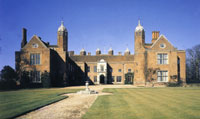
Melford Hall today
|
|
blank |
The estate at Melford Hall had belonged to the Abbey of St Edmunds until seized by the crown in 1539 as part of the Dissolution. Henry VIII had leased Melford Hall and its estate to William Cordell since the 1540's. Edward VI had given the freehold to his sister Mary, who was now Queen Mary. She decided to grant William Cordell the freehold in 1554 in place of his leases. The Melford estate was to be associated with the Cordell family for many years.
William Cordell added some features to Melford Hall, although it was already a grand building, having been rebuilt by Abbot Reeve, earler in the 16th century. However, there was now a fashion for a Banqueting House, reserved for the enjoyment of a "banket" of sweets, fruits, and confectionary of every conceivable kind. Some houses had such a room added on the roof, but at Melford it was added in the garden as a separate building, during the 1550's, by William Cordell.
|
|
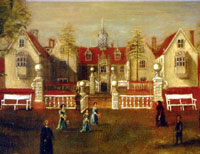
Redgrave Hall
|
|
blank |
At Redgrave, Sir Nicholas Bacon had finished building Redgrave Hall as his main Suffolk residence. It cost him £1,253. Bacon had been a solicitor, but in 1540 he became solicitor to the Court of Augmentations. This involved him in the disposal of lands taken from the Church in the Dissolution of the Monasteries. He made enough money to buy Redgrave in 1545. He removed the old Grange of the monks, and used his position to plunder materials from the newly redundant church buildings, such as St Saviour's hospital at Bury, and others. In 1547 he became Attorney of the Court of Wards and Liveries which gave him another source of profit.
Although he was a Protestant, he was useful to Queen Mary, and he kept his religious convictions to himself throughout her reign.
Redgrave house was rebuilt in 1763 in a more modern style, but demolished in 1946.
|
|
1555
|
By 1555 the second Parliament under Mary had passed laws which restored the Roman Catholic Church officially in England. All the laws which had been passed to remove the authority of the Pope were now repealed. But of more significance was the decision to restore the medieval penalties for so-called heretics who continued to oppose these changes.
Queen Mary's Lord Chancellor was Stephen Gardiner, Bishop of Winchester and a Bury man who helped the town retain or re-acquire monastic lands seized directly by the crown. Gardiner had overseen the laws which re-introduced burning at the stake for protestants.
This change was to result in Queen Mary being remembered as Bloody Mary for her persecution of Protestants. The burning of heretic Protestants now got underway. A church court could pass this sentence, and the victim was then handed to civil authorities to carry out the sentence.
|
|
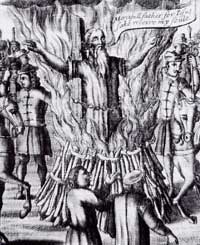
First Suffolk Martyr
|
|
blank |
In February Dr Rowland Taylor, the Dean of Hadleigh, was burned to death on Aldham Common. He was the first of the Marian Martys, (as they are known), to die in Suffolk. Nationally, over 300 people would die in this manner before Queen Mary herself died. Twelve were martyred in Bury, and their memorial stands in the Great Churchyard. About 30 Suffolk people were martyred in total.
The martyrs were not just church officials, or prominent citizens. For example, James Abbes, a shoemaker from Stoke by Nayland, was burned at Bury in August, 1555.
In September 1555, Thomas Cobbe, a butcher from Haverhill, suffered martyrdom at the stake at Thetford for his Protestant faith. He had denied transubstantiation and said that Baptism was not a sacrament.
By December Stephen Gardiner, the Chancellor and Bishop, was dead. Few of the common people would mourn him. He had risen from being the son of a cloth merchant in Bury St Edmunds to being Bishop of Winchester under Henry VIII, imprisoned in the Tower for opposing the Protestant reforms of Edward VI, and reinstated as Bishop of Winchester and made Lord Chancellor of England by Queen Mary. He had been the architect of Henry VIII's Six Articles, which had resulted in the deaths of high ranking Protestants, but under Mary these laws were extended to all Protestants, both high and low born. His tomb lies in Winchester Cathedral.
An Act of Parliament was passed to give parishes the responsibility to maintain the roads in their areas. The Highway Act of 1555 placed responsibility upon the parish highway surveyor, who was unpaid, but probably did his best with scarce resources.
|
|
1556
|
In February 1556, Latimer and Ridley were burned at the stake in Oxford. Thomas Cranmer followed them shortly afterwards.
Women could also suffer this fate. For example at Ipswich, in February 1556, Joan Trunchfield, a shoemaker's wife, and Anne Potton, a beer maker's wife, were both burned to death on the Cornhill for refusing to renounce the Protestant religion.
Philip of Spain now became King Philip of Spain when Charles V abdicated.
|
|
1557
|
In June, war was declared on France. Philip, now King of Spain, had finally drawn his wife, Mary, and England, into his father's war with France. One outcome of this was that in December, the English ruled town of Calais was overrun by the French army. This was England's only safe base in France, and was a bitter strategic and emotional blow. Calais was a symbol of the triumphs of the Black Prince and Henry V.
Despite war and hardship from poor harvests, the burning of Protestants continued. At St Edmundsbury, three people were burned in June, 1557. They were Roger Barnard, a labourer from Framsden, Adam Foster, a tailor from Mendlesham, and Robert Lawson, a linen weaver from Bedfield.
In November, Thomas Spurdance, described as a royal servant, from Crowfield, was also burned at Bury.
In Bury, William Tassell conveyed the Angel and the Castle Inns on the site of today's Angel Hotel to the Guildhall Feoffees to provide on income for various charitable purposes in the town. Specifically his deed stated that the income was to be used for the maintenance of the two parish churches, St James's and St Mary's, for setting forth soldiers, and for the relief of the people of the town. The Feoffees kept it until 1582, then re-acquired it in 1606. It was finally sold off in 1917 to raise funds.
William Cordell of Melford Hall had been the Queen's Solicitor General since 1553. In 1557 she made him Sir William Cordell, and gave him the post of Master of the Rolls.
|
|
1558
|
On 11th January, 1558, Sir William Drury of Hawstead died. By now, his eldest son, Robert, had died, and the estates passed to Robert's son, William. William was still a minor, aged 7, so the will made provision for Sir William's wife to hold the estates for 10 to 13 years until young William reached 21 years old. In this will there was no mention of Hawstead Place. Evidently it was still called 'Talmage, otherwise called Buckenham's', as referred to in the will.
John Crofts of Little Saxham Hall also died in January 1558 and was buried at West Stow, which had remained the Crofts' hunting lodge ever since the move to Little Saxham in 1531. West Stow must have remained an important part of Croft's life, despite living mainly at Saxham.
Croft's son Edmund, born 1520, was his son and heir. At the age of 17 he had married Elizabeth Kitson, or Kytson, who was the daughter of Sir Thomas Kytson, the builder of Hengrave Hall, who died in 1540. Edmund only survived his father by three weeks, and he also died in January or February 1558. Thomas Crofts now inherited the Little Saxham estate. He was born in 1538 and had 12 children by his wife Susan. He became Sheriff of Suffolk in 1595 and outlived his wife by 8 years, dying in 1612.
In August 1558 there were more burnings at Bury St Edmunds. All four of the victims were from Stoke by Nayland, Robert Miles, a shearman, Alexander Lane, a wheelwright, John Cooke, the sawyer, and James Ashley.
Three more Protestants were killed at Bury in November, only days before Bloody Mary herself was to die in her bed. They were Philip Umfreye, a tailor from Onehouse, and from Stradishall, John Davye, a shearman, and Henry Davye, a carpenter.
It is noticeable that nobody from the town of Bury itself was burned as a Protestant heretic. While Hadleigh had a strong Protestant movement, as had Ipswich, it was the Stour Valley and central Suffolk where anti-Catholic feeling was strongest at this time. Haverhill and Stradishall had their martyrs while much larger Bury did not.
Within a month or two of her marriage to Philip of Spain, there had been announcements that the Queen was pregnant. No child was born, and there were further such announcements over the short years of her reign. By 1558 it was instead believed that the Queen was suffering from a fatal dropsy, which today may have been diagnosed as ovarian cancer. Parliament had always refused to name Philip as a successor King of England, and so in November, as Mary lay dying, she named Elizabeth as her successor. Philip, now King of Flanders, as well as Spain, tried to maintain his hold on England.
Mary had come to the throne on a wave of popular support, but she died hated, on 17th November. Vast cheering crowds greeted Elizabeth to London. Queen Elizabeth I came to the throne and reigned for forty-four years.
Sir Nicholas Bacon was by now an extremely wealthy landowner, mainly acquired through holding the office of Solicitor to the Court of Augmentations from 1537 to 1546. He was made Lord Keeper of the Great Seal in 1558. Bacon owned the Manor of Redgrave and retained links with Bury. His father had been a yeoman at Drinkstone.
|
|
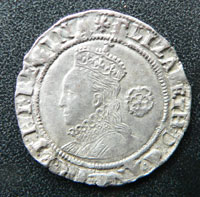
Queen Elizabeth I
|
|
1559
|
Queen Elizabeth I was crowned in the grandest style in 1559. She had two hurdles to overcome, both assumptions in peoples minds. These were that no woman could be as good a ruler as a man, and that no ruler could be as great as Henry VIII. Following the reign of Bloody Mary, John Knox had even written pamphlets to say that a woman could never be a fit ruler.
Nothing daunted, Queen Elizabeth immediately began to once again dismantle the trappings of catholicism in the churches and re-introduce protestant forms of service.
The Act of Supremacy of 1559 once again made the monarch head of the English church. This has been called the Third Reformation of the English church, counting Henry's as the first and Edward VI's as the second. The Queen made herself Supreme Governor of the Church of England and decreed that her coat of arms should be placed in every church.
The Act of Uniformity authorised a new English Prayer Book, and levied a shilling fine on anyone not attending Sunday church of the new Protestant type. This prayer book was not quite so strict about the doctrine of transubstantiation and a concession was made which allowed crucifixes and some furnishings in church. Some vestments could be worn by priests and the sign of the cross could be made at Baptism. This was protestantism with enough of the old ways retained to appease those who missed the old religion. While this may have helped reconcile the ordinary folk to the new church, it satisfied neither the strong Catholic or the new Puritans.
Tobacco was introduced from the new world.
|
|
1560
|
On 14th February, 1560, Queen Elizabeth in consideration of £412 19s 4d. paid by John Eyer, Esq., granted him (inter al) "All that the site, circuit and precinct of the late dissolved Monastery of Bury, otherwise called "Bury St Edmunds" amongst the specified lands and buildings being the Dorter Court, the Garners, the Abbot's Stables, the Gate House, the Great Court, the Pallaies Garden, the Lecture Yard, Bradfield Hall, the Pond Yard and the Vine." The ashlars were sold by the cartload for building material, but most of it had probably already gone. John Eyer already had rights to monastic rents in many parts of Norfolk and Suffolk which he had obtained under Henry VIII in 1544. He now lived for many years in the Abbey precincts in a grand mansion. It is believed that he commissioned a painted copy of the stained glass window in the Cellarer's old Quarters within the abbey, and this copy survives in Moyse's Hall Museum today.
|
|
1561
|
By 1561 Queen Elizabeth had again fully changed the appearance of English churches and services back to protestantism. Many noble families were caught up in the changes of the last twenty years, coming in and out of favour as the state religion changed. A number of important Suffolk families kept the Roman Catholic faith, the most notable being the Howards who were Dukes of Norfolk. Others were the Bedingfields, the Sulyards of Haughley Park and the Rokewoods of Euston and Stanningfield. Sir Thomas Cornwallis had been controller of the household to Queen Mary, but now retired to Brome in Suffolk.
At Hengrave Hall, Margaret Kytson died, to be succeeded by her son, Thomas Kytson, the younger. Thomas was a friend of the Duke of Norfolk, and at this time also came under suspicion for this association.
On the other hand there were even more families of a Puritan persuasion, a faith that continued to grow. At Ipswich the Queen was offended when the extreme protestant clergy refused to wear the surplice, which she had just re-introduced, as part of her compromise reforms.
Sir Robert Jermyn of Rushbrook Hall had the gift of ten livings locally, and he appointed puritan sympathisers when a vacancy arose. These included Horringer, Bradfield, Stanton and Welnetham.
Similarly the puritan Sir John Higham of Barrow had four benefices in his gift. Other Puritan gentry locally with power over livings included Sir Nicholas Bacon junior of Redgrave, and Sir William Spring of Pakenham.
|
|

Sir Nicholas Bacon
|
|
1562
|
Lord Keeper of the Queen's Privy Seal Bacon wrote to the Feoffees of Bury St Edmunds to say that he would "be glad and willing to travail as I may conveniently" to help them get a charter of incorporation for the town of Bury St Edmunds. However, he warned them that "there is an opinon received among men of wisdom and understanding, that the number of incorporations already granted and established within this realm are so many, and it is not meet nor convenient to have that number increased with any more." His letter was addressed to Sir Clement Higham, Sir Ambrose Jermyn, Henry Payne and John Holt.
Nicholas Bacon was a barrister who had connections with Bury and became Solicitor to the Court of Augmentations, acquiring much monastic land, including the manor of Redgrave, in the process.
There were still legal issues outstanding since the dissolution and annexation of monastic and "superstitious" property begun by Henry VIII. In the Council yearbook for 1896/97, which lists the charities of the town of Bury St Edmunds, one such disputed property was the Guildhall itself. This deed appears to have been necessary to settle ownership once and for all.
"By letters patent, bearing date 6th July, 4 Elizabeth, (ie 1562), the following properties, viz, the Guildhall, a messuage or tenement and Grange, in Eastgate, then lately used as the Grammar School, and the Manor of Bretts in Hepworth, which amongst other property, were alleged to have been concealed from the Crown, were granted to the Feoffees of the Town Lands for the common profit and benefit of the Burgesses of the Town."
Part of Queen Elizabeth's church reforms included the licensing of preachers. Only those ordained ministers trusted to preach the official doctrine would be given a license. Any minister who was unlicensed could only read out a pre-written sermon. A selection of acceptable sermons was published in 1562, entitled "Certain Sermons or Homilies, appointed to be read in Churches." This book was reprinted many times and was still in use in 1683, when it was re-issued under Charles II.
|
|
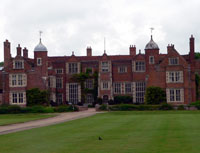
Kentwell Hall 2005
|
|
1563
|
Tolls of Bury's markets and fairs were leased by the crown for 21 years to Thomas Andrews.
Around 1563 the Clopton's mansion at Melford, now called Kentwell Hall, was completed. Unlike Melford Hall, which today looks very different to the 16th century building, Kentwell remains today looking the very much same as it did at this time.
The first Witchcraft Act came into force in England. English law now accepted witchcraft as a fact, and it was made a crime to be found guilty of witchcraft. The Witchcraft Acts were not abolished until 1763.
|
1564
|
In 1564 Bartholomew Brokesby gave "several houses" to the poor, which stood on Crown Street, backing on to the churchyard, a little distance from the west end of St Mary's church. Almshouses apparently stood on this site until taken down in 1813, and replaced by ten in Westgate Street. The source for this is a plaque erected on College Square in 1909, where several of these old endowments were consolidated into this new development by the Guildhall Feoffees.
|
|
1565
|
Bury St Edmunds was divided into the two parishes of St Mary's and St James'. Each parish had a minister, who was under the jurisdiction of the Bishop of Norwich, and a preacher, chosen by the congregation. In Bury at this time the congregations also claimed the right to appoint their own minister, which could become a point of conflict with the bishop. In 1565, one of the town preachers was George Withers, a Protestant whose views were more reformist than the English Reformation allowed. Withers caused controversy when he refused to wear a cornered clerical cap.
|
|
|
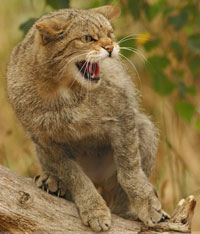
Wildcat extinct in Suffolk by 1590
|
|
1566
|
There had been various Acts of Parliament passed to control "vermin" species, but the strongest legislation came in 1566, for the "Preservation of Grayne". Harsh winters and poor harvests characterised the second half of the 16th century, and the government wanted to preserve as much food as possible for the human population. All parishes had to impose a levy upon landowners and farmers to provide a vermin fund. This fund was used to make payments to parishioners who showed evidence of the destruction of any of a long list of "pests". There was a price fixed for the deaths of stoat, weasel, polecat, pine marten, badger, fox and wildcat, as well as for the rats and mice which we might expect. Hedgehogs were on the list for stealing eggs and moles for damaging pastures. These payments continued for 300 years, until repealed in 1863. By the end of the 16th century the wildcat would become extinct in East Anglia. Pine martens clung on until the early 19th century, while polecats were eradicated by the end of the 19th century.
Suffolk Broadcloth was by now old fashioned. It was heavy and dark. People now wanted the New draperies, which were lighter, more colourful and cheaper than traditional woollens and worsteds. In 1566 the first "Strangers", as they were called, arrived in Norwich. These were Protestant refugees from the Netherlands, which were now under Spanish rule, and being "converted" to the Roman Catholic religion. They brought with them the knowledge and equipment to produce the New Draperies. In 1568, another refugee colony had started in Colchester. These two centres of Norwich and Colchester would become formidable competition to the established Suffolk trade, including to Bury St Edmunds, Lavenham, and the rest.
|
|
1567
|
The manor of Ousden had been owned by the Waldegrave family since the beginning of the 15th century. In 1567 it was sold to the Moseley family, who would own the manor until 1800. During the late Tudor period the family built the first Ousden Hall. Two Georgian style wings would be added in the 18th century. Memorials to the Moseley family may be seen in Ousden church, the most unusual incorporating a carved skeleton depicting Laititia Moseley, who died in 1619.
According to the "History of St Mary's Church, Troston", by Clive Paine, that church had a bell that was originally cast by Stevan Tonni of Bury, in 1567. Although all the bells here were recast in 1868, the original inscriptions were retained. We believe that Tonni did not start his foundry until 1570, so this may be a transcription error for 1576.
|
|
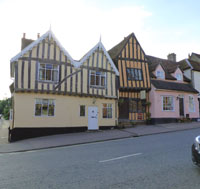
Lavenham frozen in time
|
|
1568
|
Sir Edward Coke reported that three Suffolk Gentlemen refused to attend church. These Catholic recusants, as they were called, were Messrs. Cornwallis of Brome, Beddingfield of Denham, and Silyarde of Haughley.
Meanwhile another Lay Subsidy or tax was demanded from those worth more than £1 a year from lands, or £3 or more in goods. The return for Suffolk has been published as Volume XII of the Suffolk Green Books. Although Betterton and Dymond noted that this tax was widely avoided, they suggest that by this time Lavenham had sunk in wealth to only a position of eighth in Babergh Hundred and 49th in wealth in the whole county of Suffolk. Lavenham's great heyday was over, and it was never to return. This fact alone seems to be the reason that Lavenham appears to be frozen in time with its early Tudor timber framed buildings surviving to the present day. Lavenham never again became rich enough to replace its old worn out and unfashionable buildings as usually happened every century in other more prosperous towns.
Those families who had become wealthy from the cloth trade a half century earlier, had forsaken Lavenham industry and taken their wealth away to become "Gentlemen". The Spring daughters married into the nobility. Margaret Spring married Sir Thomas Jermyn of Rushbrooke. A cousin also called Margaret Spring married Aubrey de Vere, second son of the 15th Earl of Oxford. They moved their family seat out to Pakenham. John Spring had married into the Waldegrave family at Bures and had been knighted by the boy king Edward VI in 1547.
Other wealthy clothiers who had left the Lavenham trade to become gentry were Robert Crytofte, John Grome and Thomas Rysby. Thomas Rysby died in 1568, but he had already settled his family into Thorpe Morieux as Lords of the Manor.
|
|
1569
|
In July another popular rebellion broke out at Lavenham. A weaver called John Porter was a local ringleader and his grievance was against the newly rich merchants. Suffolk dyed cloth was no longer wanted on the continent and although some big clothiers were still rich, there was no longer the guaranteed work for the small weavers and spinners of fifty years before.
The Feoffees at Bury St Edmunds had to find money to buy back from the Crown some further property recently confiscated on the grounds that it had been unlawfully concealed from the confiscations of 1545. These included the Guildhall in Guildhall Street and the Guildhall of the Guild of St Thomas à Becket in Eastgate Street. This latter building, possibly today called Ancient House, was let rent free to the Governors of the Grammar School.
|
|
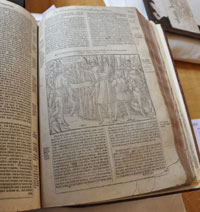
Foxe's Book of Martyrs
|
|
1570
|
Religious questions were the main intellectual topic of the day. This is the second edition of John Foxe's Book of Martyrs which was printed in 1570 by Suffolk man, John Daye. (The first edition came out in 1563.) This particular volume would be preserved in St James library and would be one of the largest volumes that the library possessed. Indeed, at this time it was the largest publishing project ever carried out. The 1570 edition was 2,300 pages long, with major corrections and additions to the first edition. It was so well received by the English church that it was to be placed in every church in the land, alongside the Bishops' Bible. It deeply offended Catholic sensibilities, and would become the main tract of anti-catholic feeling for decades afterwards.
Although it covered all the early martyrs, its intent was to concentrate upon the sufferings of English Protestants in the Tudor period under Queen Mary. This page shows the death of Roland Taylor, Rector of Hadleigh and Archdeacon of Bury, who was burnt to death at Hadleigh in 1555. This copy would be owned by Robert Plummer, a Barber Surgeon of Bury, who would donate it to St James's Library in 1680. Further editions were printed in 1576 and 1583.
By 1570 the Guildhall Feoffees were repairing town gates and bridges and carrying out many duties which would otherwise have fallen to the Town Corporation if one had existed. They even provided a town pillory. They seem to have been known as the Alderman, Dye and brethren of Candlemas Guild into the 1570's, despite the Guild's dissolution in 1545.
In 1570 the William Barnaby alms houses were on the site of Jankyn Smyth's College of Jesus founded as a residence for the parish priests of St Mary's and St James'. In 1570 they were owned by William Barnaby who conveyed them to the Feoffees. Barnaby himself lived in the manor house at Great Saxham. After the reformation men of good will who would previously have left money to the church or for "superstitious" purposes, now left it to help the poor.
The Feoffees even felt it necessary to finance a Town Preacher in Bury, and Puritan ideas led to a rise in religious discussion groups, and the clergy were as likely to be criticised as anyone else, for not being Godly enough. These ideas would gain more and more ground to the middle of the next century.
The Pope, Pious V, increased the pressure on England by issuing a Bull which excommunicated and deposed Queen Elizabeth I. This declaration, "Regnans in Excelsis", in effect meant that the Pope declared war on England. After this event Catholicism was regarded as treason in England, and penalties against them were more rigidly enforced.
Those Catholics who had hitherto quietly attended church as non-communicants or schismatics, (meaning that they followed protestant worship but were catholic in their hearts), were now faced with either defying the Pope or joining the new church fully. Hard choices had to be made, both by Catholics, and by the Queen, who had a potential Fifth Column of recusants in her midst.
The manor of Mildenhall had been seized by the Crown at the time of the dissolution of St Edmund's Abbey. It had subsequently been leased out. In 1570 a new 30 year lease was sold to Sir Nicholas Bacon, Lord Keeper of the Great Seal. After the death of Sir Nicholas in 1579 the lease passed to Henry North.
|
|
1571
|
In 1571 William Drury reached the age of 21. He was heir to the Drury estates at Hawstead, including many other manors in Suffolk. It is suggested by Sir John Cullum, in his History of Hawstead, that William was responsible for transforming the old Bokenham's Hall into a modern mansion. "It was this Sir William Drury, I apprehend, who rebuilt, or greatly repaired, Hawstead House, afterwards called Hawstead Place, or The Place." By 1578, the Place was suitable to be visited by Queen Elizabeth I.
|
|
1572
|
The Feoffees set up an almshouse at St Peter's Hospital, which later became a House of Correction to handle penniless troublemakers. This was the hospital which was founded by Abbot Anselm for infirm priests, and stood in Out Risbygate opposite the site of today's West Suffolk College. Later it moved to Bridewell Lane.
The 4th Duke of Norfolk, of the Howard family, like his predecessors, had kept the Roman Catholic faith. In 1571 he had become involved in the plot to replace Queen Elizabeth by Mary, Queen of Scots. He was put in the Tower and executed in 1572. Up to this point he had held tremendous power in both Norfolk and Suffolk, appointing JP's and getting involved in nominating MP's as well. His execution gave other lesser gentry of Suffolk the freedom to get much more involved in public life in the county. The Duke of Suffolk had already lost much of his hold over Suffolk when the Liberty of Eye was returned to the Crown in 1538.
At the other end of the religious spectrum were the more extreme protestants. Both Catholics and extreme Protestants were out of favour with the established church and state because of their refusal to conform to the established modes of worship and thought. In 1572 the more Protestant elements in Bury St Edmunds brought in a new Town Preacher called John Handson. Handson quickly came to the attention of the establishment for refusing to wear a surplice, not just during normal services, but even during holy communion.
|
|
1573
|
Despite his lack of help with incorporation in 1562, Sir Nicholas Bacon, who had been one of the Feoffees for years, was elected Alderman at Bury St Edmunds. Bacon was Lord Keeper of the Great Seal, a Bury man who was also an important national figure.
At Melford Sir William Cordell of Melford Hall built the Hospital on Melford Green, in front of Melford Church. The land it was built on had previously belonged to the church as part of the Monks Manor, but Cordell had acquired it following the Dissolution. The building that we see today is not the original from 1573. It was rebuilt from basement level upwards in 1874. The garden wall dates from 1633, with later restorations.
In 1573 Colchester carried out a census of its Flemish weaving population. The total of the Dutch manufacturers was found to be 248, and with their wives, children and servants, numbered 1,023. The "Flemings," or Deutsch as they were locally referred to, were skilled makers of various types of cloth with names like Bays and Says, tapestry and brocade. These would become known collectively as the New Draperies, and over the next 125 years would come to dominate cloth production, replacing the old heavy duty broadcloth traditionally made in East Anglia.
The Colchester Corporation Archives (known as the Monday Book) contains this introduction to the census as follows: "The view of all such strangers, manne, womann and children, as are within the Towne of Colchester, this XXVI dae of Aprill 1573, in the tyme of Robert Lambith and of Thomas Laurence, Bailiffs, which fled out of the countrye of Flanders for their consence sake, by reason of the tiranius usage of the Papists there, and permitted to remain in the Towne of Colchester by Licence from the Queen's Magistrate Privie Council.
The names of the Dutchman (Flemish and French) together with the houses wherein thare dwell." The census then lists all the names of the town wards and the homes in which they live. The district where most of the Flemish weavers lived and worked is know to this day as the Dutch Quarter in Colchester.
The French and Dutch (Flemings) were held in high regard for their honest dealing. When their bales and packs were marketed, the purchasers of their wares, whether Bays, Says, tapestry or brocade, relied solely on the seal attached to each bale. This seal truthfully stated the weight, length, and quality of the contents of the bale or pack to which it was attached.
Exactly what these draperies were like at the time is often unclear, and each community of Flemish weavers seems to have had a variation on a theme, known by a local name. However, Bay is thought to be a kind of open, woven, coarse woolen stuff, having a long nap, "sometimes not friesed, and has no wale". It was woven on a special loom as was flannel. Generally it was pure white. The word "Bay" is said to be derived from the Latin word, "Badium" which means chestnut color. Possibly this was the original color of the cloth.
Say was a kind of serge, or very light weight, cross-woven material. It was favored for linings, and extensively used by the religious for shirts and habits. (The Quakers would eventually use it for aprons, and when used for that purpose it was usually dyed green.) The word "Say" is said to be from the Latin word, "Sagum", which meant the coarse coat or blanket of a Roman soldier.
|
|

Coldham Hall
|
|
1574
|
Robert Rookwood built Coldham Hall at Stanningfield. Rookwood was a wealthy Roman Catholic, and there is a priest hole in the Hall. His son, Ambrose, would get involved in the Gunpowder Plot of 1605. In 2002 it was bought by the actress, Claudia Schiffer, for £5 million.
|
|
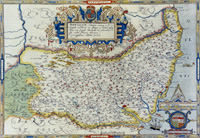
Suffolk by Christopher Saxton
|
|
1575
|
The first printed map of Suffolk was drawn by Christopher Saxton, and was part of an atlas of the counties of England and Wales. The Suffolk map is labelled 1575, and the atlas was commissioned by Thomas Seckford of Ipswich. A facsimile was published by the British Library in 1936, while the Atlas itself was published in 1579. Seckford was the Master of Requests to Queen Elizabeth, but he paid for the commission himself. Saxton's map was reproduced at three miles to the inch, and was the basis for all maps of Suffolk produced for the next 200 years. A detailed view is available by clicking on the small map shown here, but the enlargement is 3 megabytes in size, and may take a minute to load.
|
|
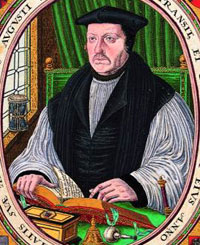
Matthew Parker
|
|
blank |
In 1575 Archbishop Matthew Parker died and left his extremely important collection of monastic and religious documents to Corpus Christi College in Cambridge, including the Bury Bible, and other manuscripts from the Bury Abbey. It is also one of the finest collections of Anglo-Saxon manuscripts in the world, including Version A of the Anglo-Saxon chronicles.
Matthew Parker was born in Norwich on August 6th 1504 and came to Corpus as a student and was ordained in 1527. He became Chaplain to Ann Boleyn, and she got him appointed dean of the college of secular canons at Stoke-by-Clare in 1535. He became chaplain to Henry VIII in 1538, and was recommended to Corpus as its new Master by Henry in 1544. Under Queen Mary he retired from public life to Norfolk and was deprived of his livings, but when Queen Elizabeth came to the throne, he was reinstated. He was installed as Archbishop of Canterbury 13 months later at the age of 55, and held the post until his death. He now had to mediate between the Catholics and the extreme Protestants to find a middle way for the Church of England. Between 1563-1568 he produced the new official version of the Bible - the 'Bishop's Bible' which was the authorised version until the King James Bible in 1611. He also supervised the revision of Cranmer's 42 doctrinal articles to produce the definitive 39 Articles of Religion which defined the doctrine of the Church of England.
He also set about finding independent evidence of the origins of an independent Christian Church in England to justify the split from Rome. To this end he collected a great many ancient manuscripts, which remain in the library he founded in Corpus Christi college today. Following the dissolution of the monasteries the great collections of the Religious Houses had been broken up and scattered. He undertook to recover manuscripts and books which were thought to be lost.
He obtained a warrant from the Privy Council enabling him to "...make a general search after all such records and muniments as related to these Realms, and which upon the dissolution of the monasteries had fallen into private hands; whereby he preserved from perishing some of the most valuable remains of our Church and Nation."
It is said that he became known as Nosy Parker because of his diligent enquiries, and that this is the origin of that saying.
There are records, which begin in 1575, of the Guildhall Feoffees paying surgeons to care for the poor of Bury St Edmunds.
|
|

Bell by Stephen Tonni
|
|
1576
|
In Moyse's Hall museum, there is a church bell from Great Bradley which was cast in Bury St Edmunds in 1576 by Stephen Tonni. The inscription reads "De me Stefanus Tonni Edmondi Santi fecit WL 1576."
|
|
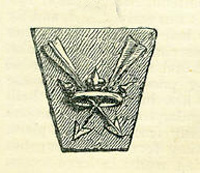
Tonni's foundry mark
|
|
blank |
Bury had a bell foundry before the Reformation, dating from 1450 to 1533, but such foundries were hit hard by Puritan views against bell ringing. Tonni seems to have started a new foundry at Bury in 1570. By now it seems to be the position that bells could be safely rung as a secular activity.
According to the anonymous Brief History of St Peter's Church at Fakenham Magna, that church contains a "second" bell cast in Bury St Edmunds in 1572. It is a 31.4 inch diameter bell, weighing about 5 cwt, cast by Stephen Tonni. The church has one bell older than this date and another from the 17th century. The last bells to be made in Bury had been dated from 1632, and were made by Thomas Cheese. However, the church at Fakenham Magna contains a bell cast by Robert Gurney of Bury St Edmunds in 1667.
Up until 1576 Suffolk and Norfolk had been under a joint Sheriff. Suffolk had included such a large proportion of ecclesistical Liberties, that the amount of so-called Geldable Suffolk had been very limited. The Liberty of St Edmund covered the whole of West suffolk. The Liberty of St Etheldreda, or Audrey, was about half the size of St Edmunds, but was still a substantial area surrounding Woodbridge. Unlike St Edmunds, which was run from Bury, St Etheldreda's was run from Ely. With the Abbots no longer in power since 1539, the Sheriff's writ now also ran in the old Liberties. Suffolk now acquired its own Sheriff in 1576, when William Spring was appointed to the post.
The Liberties passed into Crown hands in 1539, and continued to have some status as administrative units, but St Edmund's retained far more cohesion than St Etheldreda's.
However, the power of the Sheriffs was being overtaken as Lord Liutenants of the County were gradually introduced between 1550 and 1585. The Lord Liutenant's job was to be directly accountable to the Monarch, and to train and equip a local militia in each County.
Justices of the Peace came under the Lord Lieutenant. By 1579 there were 56 JP's in Suffolk. These were men like Sir Nicholas Bacon of Redgrave. JP's at this time carried out many functions of local government, as well as their judicial role.
Chief Justice Wray wrote to Lord Burghley to complain that the Elizabethan church settlement was accepted everywhere except Norfolk and Suffolk. Although he complained that many were papists, he said that most of them were Puritans, although he called them "wilful and indiscreet precisians". There were some notable Catholics among the gentry, but there were far more radical protestants in Suffolk. The latter soon became better known by the name of Puritan.
One such man was John Copping, a local minister near Bury St Edmunds.
In 1576 he was brought before the bishop of Norwich's commissary, and committed to prison at Bury, where he was charged with maintaining the following opinions:
- “That unpreaching ministers were dumb dogs:
- That whoever kept saints' days were idolaters:
- That the queen, having sworn to keep God's law, and set forth his glory as appointed in the scriptures, but did not, lay perjured:
- That for six months he had refused to have his own child baptized, because he had determined that none should baptize it who did not preach;
- and that he would not admit a godfather or godmother on the occasion.”
John Copping would languish in jail for two years, be examined and condemned again for another five years, and eventually hanged.
|
|
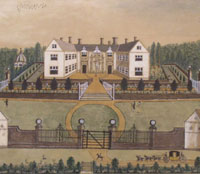
Hawstead Place
|
|
1577
|
At around this time the old manor house called Bokenhams at Hawstead was enlarged and improved by Sir William Drury. The walls were said to be decorated with inlays of glass, so that the house gleamed and glittered by day and by moonlight. A description of the property was included by Sir John Cullum in his History of Hawstead. It was described as being on an eminence, gently sloping towards the south. The whole formed a quadrangle, 202 by 211 feet, divided into two sections. The first courtyard consisted on three sides of barns, stables, a mill house, slaughter house, blacksmiths shop, and various other offices. In the fashion of the time, these working buildings were a little further away from the great house than they would have been in the time of Henry VIII. The main house could only be approached through this Outer Court.
The rear section of the whole enclosure contained the mansion house, standing higher than the other buildings and divided from them by a moat, and surrounded by a fine wide terrace. This Inner Court was an area of 58 feet square.
|
|
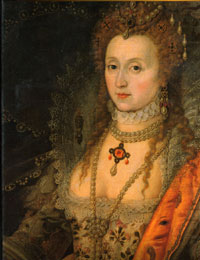
Queen Elizabeth I
|
|
1578
|
Queen Elizabeth I had reigned for twenty years, and was in the habit of undertaking Royal Progresses through the kingdom. This kept her in touch with people and ideas, and allowed her to favour the compliant and snub the disaffected or fanatical adherents to religious views of which she disapproved. It was also her general policy to show herselves to her people, and to gain acceptance for her ideas by the force of her royal presence in their own towns. She knew that ultimately, like all monarchs, she ruled subject to the will of the nation.
A long held traditional view was that going on progress also allowed her to save money by living richly at other people's expense. However, Zillah Dovey has shown in her book "An Elizabethan Progress", that it cost the crown about £2,000 a year more to take the court on the road than to stay in one place. Her visits did indeed cost her hosts deep in the purse, but the crown bore the costs for transport and accomodation for the court and the system of government which had to accompany her. The Queen travelled with up to 1,000 staff and had 2-300 waggons pulled by 2,400 horses. Only the baggage was on wheels, everybody else rode on horseback. The entourage could cover about 10 or 12 miles in a day. The cost of accomodating and feeding such a host must have been prodigious.
In 1578 the Privy Council had two major issues to consider. The first was the Calvinist revolt in the Netherlands against their ruler, the Catholic King Philip of Spain. Queen Elizabeth wanted the Protestants to succeed, but she also believed in the rights of Philip as the rightful King of the Netherlands.
At home, the major issue was the refusal of Catholics to accept the official Protestant religion. This issue was made more dangerous by the presence of Mary Queen of Scots under house arrest in Derbyshire. She could at any time become the focus of a Catholic uprising. East Anglia was prosperous and densely populated, and Norfolk and Suffolk retained a number of important Catholic families. Not only that, but the Bishop of Norwich at the time was Edmund Freake. Freake seemed to be happy to come down heavily upon the Puritans, who were too extreme for the state sponsored religion, but to be reluctant to move against Catholics, who were much more feared by the government.
Therefore it was decided that a Progress up to Norwich would force these issues into the open. In May the first ideas were being discussed at Court. In mid June, Thetford and Norwich were given official notice to expect the Queen in August. In late July Thomas Churchyard was sent up to Norwich to prepare the entertainments and receptions to welcome the Queen. Churchyard was to write up the details of these entertainments, and these accounts give the most detailed account we have of a Royal Progress. Meanwhile William Bowles was sent out to visit two dozen houses which could be used on the route outwards, and another dozen for the way homewards.
Thus, in July, August and September of 1578, the Queen and the Court made their progress from Greenwich, in London, to Norwich and back, returning by a different route. Norwich was the second city of England, with 16,000 inhabitants, and was extremely prosperous. Her journey brought her into Suffolk through Haverhill and Long Melford and north to the Bury St Edmunds area. The Queen had never gone further into East Anglia than Audley End in 1578, and despite plans to repeat the trip, she would never visit Suffolk and Norfolk again.
The trip began on 11th July, with a short move from Greenwich to the palace at Havering. On 21st July she moved on to Mark Hall at Latton, and on the 23rd, progressed to Standon. On the 26th July the court moved to Audley End, owned by Thomas Howard, second son of the 4th Duke of Norfolk. The 4th Duke had been executed by Elizabeth in 1572, but Thomas, now only 17, would live to be the discoverer of the Gunpowder Plot in the search of the cellars of the House of Commons in 1605. Much of the court took lodgings in Saffron Walden during this part of the progress. On Friday August 1st , the court left Audley End, making for Melford Hall, about 20 miles away.
Dinner was taken at Barham Prory, near Linton, and the Queen needed three overnight stops before reaching Melford. After dinner on the 1st August, the Queen probably crossed into Suffolk. Thomas Churchyard recorded the scene, but it is unlikely that he was actually present, as he was in Norwich, preparing for the Royal arrival later in the month.
Although the counties of Suffolk and Norfolk had only had a couple of months notice of the Queen's plans, they had made extensive preparations. Churchyard wrote that "All the velvets and silks were taken up that might be laid hand on and bought for any money". As the Queen entered Suffolk going from Linton towards Haverhill and Kedington, she was met by the Sheriff of Suffolk, William Spring III. Spring was accompanied by "two hundred young gentlemen, clad all in white velvet, and three hundred of the graver sort, apparelled in black velvet coats, and fair chains." The Spring family fortune had been made from the cloth trade in Lavenham but by the 1520s the Springs had lifted themselves above mere trade to become landed gentry. William Spring III was knighted by Queen Elizabeth I.
It was later reported that the Queen was impressed by the fact that the Gentlemen of Suffolk greeted her along with their parish priests. Once in Suffolk the Queen passed through Haverhill, making for Kedington and the house of Thomas Barnardiston, a staunch Protestant from an established and wealthy family. The Queen and Lord Burghley and their closest servants stayed in the Barnardiston House overnight on 1st August. Lord Leicester stayed overnight at Blunts Hall, about a mile away.
Next day was Saturday, August 2nd, and the court moved on to Cavendish, where the Queen dined at Colte Hall, owned by George Colte. George was knighted by the Queen at this time as a reward for his conformity. After dinner the entourage moved on to Melford, arriving that evening.
|
|
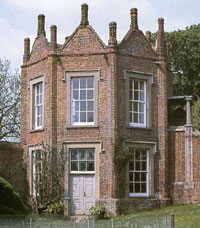
The Banket House at Melford Hall
|
|
blank |
At Long Melford she was welcomed to Melford Hall by Sir William Cordell, who had received the lease to the estate from Henry VIII and the Freehold from Queen Mary. Cordell was a new man, who owed his elevation to the law. He was Solicitor General to Queen Mary in 1553, and knighted and made Master of the Rolls in 1557.
Simon Bowyer had already been at Melford for 8 days getting the house ready for the Queen. She always had the layouts changed to a standard pattern, and her own plate and wall hangings were laid out. In effect, when the Queen moved in, your house became hers, but the extensive arrangements made at Melford reflected the length and importance of her stay there.
Queen Elizabeth I stayed here for some days as Cordell's guest. Churchyard recorded the progress in these terms, "Such sumptuous feastings and banquets, as seldom in any part of the world hath been seen before." At this date a banquet, or banket, as Churchyard spelled the word, referred to the sweet course alone, which was often taken in a special "banket room", where all manner of sweets and puddings would be lavishly displayed. The Banqet House at Melford is today called the Garden House, or the Gazebo, and was probably supplemented by tents or pavilions to accomodate the required numbers.
Court business had to continue, and on August 3rd, just a day after arriving, and on a Sunday, the Queen received both the French and the Scottish Ambassadors. While the French ambassador was at Melford, there was an incident when the Queen sent a messenger to ask Edward de Vere, the Earl of Oxford, to dance for the Ambassador. De Vere refused twice, and was often in hot water with the Queen, but was married to Ann Cecil, the daughter of William Cecil, Lord Burghley.
The eight man Privy Council met twice at Melford Hall. Some of the officials stayed in nearby Sudbury while the court was at Melford. The visit to Melford Hall lasted from Saturday evening of August 2nd until early morning on Tuesday, 5th August, 1578.
On Tuesday, the Queen journeyed northwards to Lawshall Hall, the home of Henry Drury , where she dined, but did not stay overnight.
Henry Drury was a Catholic, and although nothing happened while the Queen was at his home, he would later be arrested for his faith.
Later on that evening of the 5th August, the Queen rode on into Bury St Edmunds. There seems to be no record of her reception, but there must have been some sort of official reception. We know that in preparation for the Queen's arrival, the Feoffees had refurbished the town gates and made other improvements around the town. So it is likely that there would have been a turnout of local worthies to welcome her.
The Queen's destination was the old abbey, where she was due to stay for four nights.
The abbey grounds and the former Abbot's Palace was owned at this time by Sir Thomas Badby, a rich and active local Puritan. Badby was uncle to Robert Jermyn of Rushbrooke.
However, the old Abbot's Palace did not prove big enough for the Queen's senior ministers, and Lord Burghley and Lord Leicester stayed with Thomas Andrews, another wealthy Bury man. Andrews was often in opposition to Badby's Puritanism.
Next day, Wednesday, August 6th, the Council met at Bury, although Lord Leicester and Lord Warwick were absent, somewhere in the town.
During the stay at Bury many state letters were dispatched from the town, including over a dozen sent abroad. However, on 7th August, Lord Leicester wrote to Walsingham that the Queen would only deal with the most urgent state matters, having had a cold, and suffering from pains in her face. Walsingham was in the Low Countries, trying to contact the Duke d'Alencon on behalf of the Queen. Some of the royal clerks were installed at Thetford, so messengers sometimes passed from Bury to Thetford and back, before being finally signed and dispatched.
On 8th August, Lord Burghley wrote that the people of Bury were "very sound saving in some part affected with the brainsick heresy of the papistical Family of Love." The Family of Love was an heretical sect who believed that only they would be saved on the Day of Judgement, and had some following in the east of England. The 'Family' was outlawed in 1580.
|
|
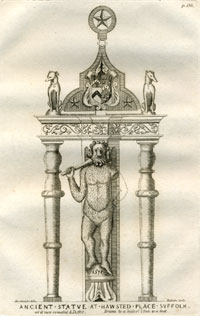
Hercules
|
|
blank |
During the stay at Bury St Edmunds, the Queen rode out to visit the newly rebuilt manor house of Sir William Drury at Hawstead Place. This is generally accepted to be on the site of the old Bokenham's manor house. Sir William Drury was nephew to Henry Drury of Lawshall, but was not a Catholic, and thus found greater favour from the Queen. Sir William Drury was well known to the Queen, having married Elizabeth Stafford, one of the ladies of the Bedchamber.
In honour of the Queen's visit, a wooden statue was carved of a naked man with a large club. This may have been intended to be Hercules, a popular theme at this time. The illustration here showing the statue in a loincloth is almost certainly not as it originally appeared. It originally formed part of a stone fountain in which the flow of water made it appear that it was Hercules passing water. This statue was taken with the Drurys when they moved to Hardwick in the 17th century, but now stands at Hawstead Place Farm today.
The Queen was said to have dropped her fan into the moat at Hawstead. As Sir William had 2,000 acres enclosed for a Deer Park, the Queen went hunting there, and then enjoyed a "costly and delicate dinner." But even this outing had been carefully orchestrated by Anthony Wingfield, of the Court, who had spent two days at Hawstead setting up the Dining Chamber, and Charles Smythe, who came for a day to assist the arrangements.
|
|

Thomas Kytson 1573
|
|
blank |
At Bury she knighted Thomas Kytson the younger, of nearby Hengrave Hall. By now Kytson had persuaded the Queen that he supported her rule and her religious policies, having been previously under suspicion for Catholic extremism. Kytson had the advantage of being fabulously wealthy, but not being of noble birth, was glad to be rewarded for his promises to attend church and listen to orthodox sermons by being given his knighthood. Nevertheless, he provided generous hospitality to courtiers on the Progress.
Also during the stay in Bury other Suffolk gentlemen in favour were knighted. Robert Jermyn of Rushbrooke, and William Spring, Sheriff of Suffolk were both good Protestants and had entertained any members of the Court's Progress who cared to visit them. Jermyn had twice feasted the French ambassadors, and both men gave accomodation to visitors. Both men were now knighted by their Queen.
Other Suffolk worthies to be knighted in Bury were Arthur Heveningham, with estates in east Suffolk as well as in Norfolk, and Phillip Parker, a prominent Suffolk magistrate.
On 8th August the Clerk of St James's parish recorded a death from the dreaded plague. Another 25 people would die of plague in Bury over the remainder of 1578. One of the main checks carried out before the Queen travelled anywhere, was to ensure that she went nowhere where there was evidence of the plague. The suspicion was that someone in the Progress, or one of its camp followers, had brought the disease to Bury.
The Queen had stayed an unusual length of time at Bury, and left that town on Saturday 9th August, heading for Mr Rookwood's house at Euston for the weekend. Edward Rookwood was a Catholic gentleman, and brother to Ambrose Rookwood of Coldham Hall in Stanningfield. This two day visit by the Queen turned out to be a disaster for Rookwood. Usually nothing untoward would happen while the Queen was on the premises, but Lord Chamberlain Sussex berated Rookwood for coming before the Queen and ordered him to leave his own house. The Spanish ambassador would later report that Rookwood had received the Queen with a crucifix around his neck. A search was made of the premises, ostensibly to look for a missing piece of the royal plate, but a statue of the Virgin Mary was discovered, hidden in a hayrick. It was brought to the Queen who ordered it burnt.
These incidents would not have been witnessed by the many court officials who had to stay elsewhere in the area. Lord Leicester stayed 3 miles away at Mr Methwold's house at Rushford. His men had to lodge at Thetford, where there was already a contingent in residence since before Bury.
On Monday 11th August the Queen dined at Euston, and then left for Norfolk, heading towards Kenninghall Palace. Churchyard wrote that the Norfolk gentlemen had heard of the reception the Queen had received in Suffolk, and "prepared in like sort to so themselves dutiful." On crossing into Norfolk she was met by the Sheriff of Norfolk and 2,500 horsemen, including 600 gentlemen. Churchyard was probably exaggerating these numbers, as Lord Burghley also had a list of Norfolk gentlemen which contained only 324 names.
The Queen's progress in Norfolk can be summarised as follows;
- 11th August at Kenninghall Palace, owned by Philip Howard, Earl of Surrey, a member of the generally disgraced Catholic family of Dukes of Norfolk.
- 14th August at Mergate Hall in Bracon Ash, the home of Thomas Townsend, a known Catholic recusant.
- 16th August at Norwich, staying in the Bishop's palace.
- 22nd August at Kimberley Tower, home of Roger Wodehouse.
- 24th August at Woodrising Hall, home of the Southwells.
- 26th August, arrive at Thetford at the former Nunnery of St George, owned by Sir Edward Clere of Blickling.
On the 15th August, the parishioners of St James, in Bury St Edmunds, sent a petition to Lord Burghley, on behalf of their town preacher, John Handson. According to J S Craig, (SIAH Vol 37, part 3, 1991), it is likely that Handson had been called before the royal council, when in Bury, and indicted to appear before the next assize to answer for the doctrinal views in his preaching. Handson was a more radical Protestant than some more conservative townsmen could accept. There were 63 signatures all testifying that Handson was a true and faithful subject, beset by enemies and false accusations. This letter seems to have gained Handson a reprieve from further official action against him, but he still had enemies in the town.
On 22nd August, the Council had examined several recusants at Norwich, handing out such judgements as they thought fit, including house arrest with local reliable Protestants where they would receive daily persuasion to convert from the Bishop or his man. Edward Rookwood had also been summoned up from Euston, and he was now imprisoned in Norwich Gaol, where he stayed until October. Only Rookwood and Robert Downes were actually held in Norwich Gaol.
Once in Thetford, Lord Leicester stayed at East Harling. Its owner, Thomas Lovell, had just been put under house arrest in Norwich as a recusant. The Privy Council met at Thetford on 27th August, and one small issue that they were burdened with was a local dispute between Thetford Corporation and a former Mayor, William Davye. Davye seems to have been at the centre of local disputes for several years after this time.
The Queen cut short her stay at Thetford, leaving on the 27th August to head for Hengrave, two or three miles outside Bury St Edmunds.
On her progress back from Norwich, the Queen stayed at Hengrave Hall for three nights from August 27th. Sir Thomas Kitson had only been knighted when the Queen had been in Bury a few weeks earlier, but he was fabulously wealthy. The stay was a notable one, outdoing many others by its lavish hospitality and entertainments.
At Hengrave the Privy Council met three times, continuing to concentrate on the perceived Catholic threat. They considered a list of 34 names from Suffolk, interviewing a group of them.
Nine were sentenced to imprisonment for refusing to conform to the state religion. This was mostly a form of house arrest, in the house of other more reliable citizens. Henry Drury of Lawshall, Michael Hare of Bruisyard and Roger Martin of Melford all refused to conform and were sent to prison in Ipswich. John Daniel of Acton, Edmund Bedingfield of Denham and Henry Everard of Linstead and several others were sent to houses in Bury for their "imprisonment". Others like Edward Sulliard were sent to houses in Ipswich. Later, when Bedingfield was sick, he was allowed to move to Leiston Abbey, and the following year he was allowed to take the waters in Bath. Those in prison were sometimes moved out to private houses, and bailed to avoid the plague.
On 30th August the Queen moved on to Chippenham in Cambridgeshire, the home of Thomas Revet.
After the Queen left the Bury area this was the end of royal patronage of Bury for over 300 years, until Edward VII's visit in 1904.
Leaving Chippenham on 1st September, the Queen skirted Newmarket, making for Kirtling Tower, to the home of Roger, Lord North.
Sir Nicholas Bacon died in 1578 owning over 30 manors, half in Suffolk, which he ran from his home at Redgrave Hall. He retained links to Bury and Drinkstone where he grew up. In 1558 he was made Lord Keeper of the Great Seal, a great achievement for a Suffolk Yeoman's son.
Ann Kytson, the sister of Thomas Kytson II married the High Sheriff of Suffolk, Sir William Spring of Pakenham. Thus did the great families intertwine their fortunes and cement social positions.
By this time John Copping had remained in prison two years for holding religious opinions of an extreme Puritan nature. Because he was still refusing to conform, he was brought before Justice Andrews in December 1578, when his "false and malicious opinions", were proved against him. Having refused to change his opinions, once more he was remanded to prison where he remained almost five years more. At some point he would be joined in prison by Elias Thacker, another minister of the same opinions.
|
|
1579
|
Thomas Badby, who now owned the site of the old abbey, gave the Feoffees of Jankyn Smyth's bequest the building at the bottom of Honey Hill which had been the monastic grammar school. It was to be used as a Shire House for the assizes and county Quarter Sessions to be held in the town. The Shire Hall still stands partly on this site. By about 1584 we know that the Assizes were held in the town at the new Shire House, having now moved into town from their previous site at Shirehouse Heath. The building seems to have survived until 1840 when it was replaced by a Shire Hall built in the style of a Greek temple. From this origin the site has remained a public building and centre of justice ever since.
In February, four apparently puritan JP's at Bury issued their own code of discipline for the parishioners of St Mary's church. Penalties were laid down for gaming, usury, fornication and drunkenness, but also for keeping monuments of idolatry, papism, absence from church, disturbing prayers, blasphemy and witchcraft. These JP's were Robert Jermyn of Rushbrooke, Thomas Andrews of Bury, John Higham of Barrow and Robert Ashfield of Stowlangtoft. Thomas Andrews was a leading Feoffee and was much more conservative in his views than Jermyn or Higham.
|
|
1580
|
The Feoffees set up a House of Correction for sturdy beggars and incorrigible rogues in Master Andrewes Street in Bury, off Churchgate Street. Taking its name from the Bridewell, or House of Correction, the street soon became known as Bridewell Lane, a name still in use.
The Feoffees were a group of "24 discreet and substantial persons" in the town, who were by 1580 wielding great power in the town. They administered income from rents, bequests and sales amounting to £285.15s.6d in 1580. This money was used to maintain the Guildhall, almshouses, parish churches, alms for the prisoners in the gaol, the poor in hospital and the orphans in the town. They also kept a Clerk, a Chief Porter and Under Porter, a cook and a dee, or Major Domo, at the Guildhall to wait upon them. These expenses totalled £248.14s.2d in 1580. Various officers of the Feoffees paid themselves an annual fee, as well as themselves renting some of those charity lands to themselves at advantageous rents.
Seven Feoffees brought a case in Chancery against Thomas Badby, another Feoffee, charging him with appropriating land to his own private use and profit. The seven were Thomas Andrews, William Hill, Henry Collyng, Stephen Hayward, Anthony Payne, Thomas Bright and Roger Potter. Possibly Badby was being singled out because he was not a hard line conservative like Andrews.
In October 1580, Edward Rookwood of Euston was in Norwich Gaol for recusancy. He was held there with Humphry Bedingfield, and the Suffolk recusants, Michael Hare, Roger Martin and Edward Sulliard. In prison he received a plan of escape sent to him by English Catholics living in France. He burned the letter, but not before the Bishop heard about it. Rookwood had to persuade the Bishop that he was loyal to the Queen and had no thought of treason.
|
|
1581
|
An Act of Parliament said that anyone staying away from church services could be fined £20 for every month in default. This was aimed at Catholic recusants, but there was a group of protestants who preached Separatism from the Church of England.
Robert Browne (1550?-1633) was a prominent Elizabethan Separatist. He was born in Tolethorpe, Rutlandshire, of a wealthy and prominent Northamptonshire family. Browne attended Cambridge University 1570-73. He received a B. A. (1572) from Corpus Christi College (Cambridge).
It was while Browne was at Corpus Christi, that he first met Robert Harrison (154?-1585?). Harrison came from Norwich. In 1578 Browne became a member of the household of a Puritan clergyman at Dry Drayton outside Cambridge, the Rev. Richard Greenham. This “preaching minister” was one of those who remained loyal to the Church of England, but clung resolutely to simplicity of dress and worship. Browne preached in the area, but because of his objections to Bishops and church regulations, he refused to ask for a proper preaching license. He left the Cambridge area after about 6 months and Browne was able to persuade Harrison to establish their own Separatist congregation at Norwich early in 1581 based on their own ideas. At Norwich there was a large Dutch and Walloon population, sympathetic to radical Protestant ideas. This group is recognised as the first of what is now called the Congregationalists. Browne was also engaged in preaching at Bury St. Edmunds.
Browne's followers were the so-called Brownists, and they were active in Ipswich, Mildenhall and Thetford, but above all, at Bury St Edmunds.
On 15th April, 1581, the Bishop of Norwich, Edmund Freke, visited Bury St Edmunds to assess the situation. He was so concerned that he wrote to Lord Burghley to report on separatist meetings held in this town. The Bishop told of meetings, "to the number of a hundred at a time in private houses and conventicles" to hear Robert Browne preach. The Bishop feared that expression of such radical views to such numbers was "not without danger of some ill event." He found "great divisions amongst the people."
In 1581 the separatist leader, Robert Browne, was put in prison by order of the Bishop of Norwich for his unlicensed and seditious preaching at Bury. By 1591 Browne had returned to the Church of England in Northamptonshire, but his followers kept his old ideas alive. The Congregationalists or Independents would later follow very similar ideas.
Unfortunately the separatist movement had the knock-on effect of reinforcing opposition to much less militant non-conformists. In 1581, town preacher at Bury John Handson had his preaching licence suspended by the Bishop of Norwich.
Sir William Cordell of Melford Hall, and the Master of the Rolls, died in 1581. This estate had belonged to the abbey until 1539, and Cordell acquired control of it from the crown by the late 1540's. He had been responsible for rebuilding Melford Hall into a grand and imposing building. It is unclear whether the original house of the Abbots was demolished as part of this campaign, or was incorporated in some way into the new structure. Melford Hall passed to Cordell's brothers, then to his sister, Jane Allington. By 1602 it was in a poor state of repair when it was inherited by Thomas Savage.
|
|
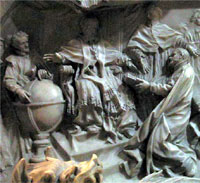
Pope Gregory's new calendar
|
|
1582
|
On 24th February, 1582, Pope Gregory XIII announced that the Catholic world was to adopt a new calendar, named the Gregorian calendar. The Julian calendar, named after Julius Caesar and in use since 45BC, had been gaining one whole day every 128 years. As a result there was a difference of ten days between solar time and official time. This difference was made up later in the year by making 5th October, 1582, into 15th October. The Julian calendar already had months of different lengths, and had used leap years in a very complex manner. Pope Gregory slightly adjusted the various months with unequal numbers of days and used a new system of leap years to keep the system in step with solar time. The Gregorian new year was to start on 1st January. This edict did not cover this country and the system was not adopted here until 1752. In England, Scotland and Wales, the new year continued to begin on Lady Day, 25th March, and would be 10 to 11 days behind the new Gregorian system for the next 170 years.
There was no hope of adopting any calendar of the Pope's while Puritans like the rector of Cockfield had any say. In 1582 John Knewstubb, who was a well known and prominent puritan, called a secret conference of 60 East Anglian clergy at Cockfield to discuss what parts of the prayer book they would accept or reject.
Bury St Edmunds was in the midst of a religious turmoil known as the "Bury Stirs". Certain Puritan leaning Suffolk magistrates like Sir Robert Jermyn and Sir John Higham were frequently in dispute with the Bishop of Norwich, Edmund Freke. Similarly, within the town, there were those inclined towards Puritanism, who considered themselves to be Godly men, who were constantly at odds with the more conservative supporters of the official church doctrines. This enmity led to underhand tricks and misrepresentations, followed by appeal and counter-appeal to the authorities.
James Gayton, the Town Preacher for St Mary's parish, left Bury St Edmunds in early 1582, unable to bear the situation any longer. In June John Handson also left the town, blaming, "the violent and continual practices...of some men's malice."
By August, 1582, both of Bury's town preachers, John Handson and James Gayton, had left the town because of the conservative hostility to their preachings. This caused 174 local men to appeal to the Privy Council to send commissioners to enquire into the matter. Town preachers were paid by contributions from parishioners, and the failure to meet these payments, on the part of some objectors, was the material reason why they had to seek "employment" elsewhere.
One further incident which inflamed the situation involved the royal coat of arms which was displayed in St Mary's church. Some townsmen had organised the painting of part of a verse from Revelations around the Queen's arms. The inscription of part of Revelations chapter 2, verse 19, was taken as a direct criticism of Queen Elizabeth and her church. This graffitto was seen as treason in official quarters, and was to be quoted as evidence against any form of dissent.
This verse seems innocent enough on its own:
"I know thy works, and charity, and service, and faith, and thy patience, and thy works; and the last to be more than the first."
but it merely introduces the next verse which goes as follows:
"Notwithstanding I have a few things against thee, because thou sufferest that woman Jezebel, which calleth herself a prophetess, to teach and to seduce my servants to commit fornication, and to eat things sacrificed unto idols."
The implication that the Queen is equated with Jezebel makes this inscription much more serious than it first appeared.
The underlying issue was the Reformation itself. How far should reform go? The crown wanted to keep the peace by fixing upon an official form of worship, which it hoped would appeal to all sides. This was supported by the Bishops and the church hierarchy. Those who wanted to go further covered a spectrum of beliefs from merely rejecting the wearing of the surplice or the clerical hat, to those who rejected the idea of a church hierarchy of any description. These were the separatists, or Brownists, who wanted to set up a separate congregation untramelled by the rule of Bishops.
It is fair to say that both sides misrepresented the ideas of their opponents in order to discredit them, and both sides refused to accept the good faith of the other. The Puritans referred to everybody else as "irreligious persons", or "backward men in religion". Bishop Freke in 1581 had referred to the non-conformists as "those given to fantastical innovations" as compared to those who had a "dutifull affection to have Her Majesties proceedings observed", and it was a "vulgar sort of people" who favoured innovation.
The conservative elements within the town who opposed the radical views of the town preachers were mainly the Governors of the Grammar School and the Guildhall Feoffees. Of the 24 Feoffees, only Thomas Badby had broken ranks and signed the petition to the Privy Council on behalf of the town preachers. Although small in number, the Feoffees had power and influence within Bury St Edmunds, and could command a hearing by the highest in the land.
By November John Handson had returned to Bury, persuaded back by his flock who promised to stand by him. On 6th November, they wrote another appeal to Lord Burghley, signed by 144 inhabitants. The appeal said that Handson had returned as he was "sent for by a general consent", but "he will not execute his office" until he was sure of a peaceful reception. The letter claimed the support of 400 parishioners, against "the false accusations of of a few infamous persons who cannot abide the godly preacher of the word."
Because of the general air of dissent and tension in Bury St Edmunds in 1582, the Assize judges avoided a sitting in Bury during this year.
By now, the Guildhall Feoffees appointed a town surgeon every year to provide medical care to the poor in Bury. In 1582 the town surgeon was assisted by "a woman surgeon of Colchester."
|
|
1583
|
The Guildhall Feoffees raised money to build "a very fayer large house for cornesellers ... wherein they may stand to their great ease very commodiously in the heat of summer and also in time of rainy and cold wet winter." The exact site is not known. It is believed to have burned down in the great fire of 1608.
|
|
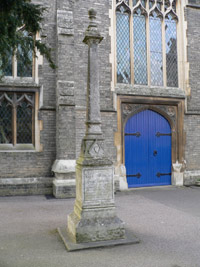
Thacker & Copping Memorial
|
|
blank |
More and more Puritans were questioning the legitimacy of the established church. The most extremely outspoken were often jailed. In 1582 Robert Browne had published his tract called "A Book which sheweth the Life and Manners of all true Christians" which was so inflammatory that he moved to Holland, where he also wrote "Treatise of Reformation without Tarrying for Anie" By 1583, the writings of both Browne and the like minded Robert Harrison were being sold in England. In mid-1583 a Proclamation was issued against the buying, selling or owning the dissident works of Robert Browne and Robert Harrison.
By 1583, the Reverend John Copping had been on remand in Bury St Edmunds goal for seven years. At some point he was joined by Elias Thacker, prosecuted for distributing Browne's pamphlets. Although imprisoned, their preaching so undermined good order in the jail that something more had to be done. They tried to get a writ of Habeas corpus, but at the trial the prosecution barrister associated them with the seditious graffiti around the Queen's coat of arms found in St Mary's Church the previous year. The sentence passed upon them was founded upon the 23rd Eliz. law against seditious libels, and for refusing the oath of supremacy. They acknowledged the supremacy of the queen in civil matters only, not in matters ecclesiastical, thereby subverting the constitution of the established church.
The Judge passed the death penalty, and both men were sentenced to hang at Tay Fen, just outside the line of Bury's ancient wall. The authorities collected together all that could be found of Brown's books, prior to their execution, and burnt them before their eyes. Lord Chief Justice Wray claimed that there were many of Copping and Thackers' opinions in the town, and that the example made of them would act as a deterrent.
Only one man was convicted of arranging for the defacing of the royal arms. He was Thomas Gibson, a Bury bookbinder, who was fined for his part in the action.
A minister was later convicted for claiming that if the executions had taken place a year earlier, there would have been another 500 people in the crowd at the hangings. Clearly by 1583 the reforming zeal had been damped down somewhat within Bury St Edmunds. Nevertheless these ideas were widespread in West Suffolk. At Thetford, the separatist preacher William Dennis was also hanged in 1583.
Meanwhile Browne, the well off and well connected writer of the pamphlets, was free at large while others were being arrested and hanged for selling his books. Browne himself has often been called the father of Congregationalism.
In Whiting Street there is a memorial to John Copping and Elias Thacker, hanged in 1583 for distributing puritan literature and supporting independency. This memorial was erected in 1904 in the grounds of the Congregational Church.
Thomas Badby, a leading puritan JP, who lived in Bury St Edmunds, died on 7th December, 1583. He had recently been ejected from the Commission of the Peace for his puritan zeal. Sir Robert Jermyn, another puritan, felt moved to appeal to Lord Burghley on his behalf as recently as November 22nd, citing an "unworthy and unlawful minister", as the cause of his eviction and fine of 100 marks.
|
|
1584
|
Over 50 Suffolk ministers were suspended for refusing to conform to the official Protestant Church of England teachings including a refusal to wear the surplice. Puritanism continued to spread, despite official persecution.
In Bury, since the Dissolution of the abbey, the town had fallen under an increasingly oligarchic administration by the capital burgesses. The inhabitants complained to the crown and a commission was appointed to look into how the Feoffees were administering the town lands. To some extent this was a move by the puritan leaning townspeople against the conservative Feoffees, and, in particular, Thomas Andrews, in revenge for their attacks upon the town preachers.
Sir Nicholas Bacon, Sir Robert Jermyn and four others, Robert Ashfield, John Jermyn, Thomas Poley and George Kemp, were appointed by the Privy Council for the task on 20th December, 1584.
|
|
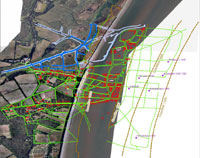
Dunwich coastal erosion
|
|
1585
|
Radulphas Agas was a mapmaker and surveyor from Sudbury. In 1585 he was commissioned to make a report on the once famous town of Dunwich. Agas found that by this time about half the medieval town had disappeared beneath the encroaching seas. This had started with a great storm in 1286, which eroded the cliffs and deposited tons of silt in the harbour channels. By 1328 the port was useless due to silting up, and by 1342, about 400 houses had been destroyed by wave erosion. Erosion of this coast would continue to the present day.
On 28th April, 1585, The Commission appointed to examine the accounts of the Feoffees sent their report to the Privy Council. They found that the Feoffees had ignored the terms of the bequests they administered. They had accounted to themselves and not to all the burgesses, contrary to the express words of the will of the main donor. They alone had been appointing their successors, which was a job for all the burgesses. Town houses had been sold off to friends at below market price, and they had kept the best leases to themselves at 12d per acre when they were worth 5 shillings. In addition a compromise position which had been reached and agreed in January between town and Feoffees was being flouted. They were found guilty of maladministration and peculation.
Thomas Andrews, a conservative Feoffee who had led the legal machinations against the townspeople, died during 1585, and for the first time, there was a proper Michaelmas accounting by the Feoffees. The list of signatories now included Sir John Higham and four men who had petitioned in favour of the town preachers. The "godly" faction had at last gained the upper hand in Bury St Edmunds, and this ascendancy of puritan thought would prevail for decades to come. The town, the Feoffees and the School governors were all now in puritan hands.
In 1585 the Earl of Leicester sailed to the Netherlands to fight on the side of Dutch protestants against the Spanish. Their motivation was to protect protestantism, and keep Catholicism as far from England as possible. Sir Robert Jermyn of Rushbrooke, his half brother Henry Blague of Horringer, their brother William Jermyn and Thomas Poley of Icklingham, all joined the expedition. They all took local volunteers with them and actively recruited for this cause in Suffolk.
|
|
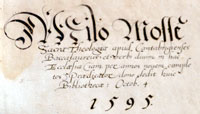
Miles Moss at St James
|
|
1586
|
In 1586 Miles Mosse became the Reader, or town preacher, at St James in Bury St Edmunds at a salary of £48 a year. Miles Mosse was the son of Miles Mosse of Chevington, and was born in 1558. He was educated at Bury Grammar School and Caius College, Cambridge, gaining his first degree in 1579. In 1585 he became vicar of St Stephens in Norwich, and was soon recruited to his home town of Bury. He had gained a reputation as a preacher, and the delivery of learned sermons was regarded as the prime responsibility of any church.
Mosse was now supported in his puritan leanings by the majority of the town, unlike the position of his predecessors in the post, just a few years earlier. Illustrative of this sea change in control are the Feoffee accounts, which showed between £2 and £4 a year spent on both parish churches and their ministers from 1582 to 1585. In 1586, after the demise of Thomas Andrews, and the enquiry into Feoffee accounts, expenditure on church and ministers shot up to £50. In 1588 it would rise to £58 and by 1589 it reached a level of £82, where it would stand for another decade.
One of the new Reader's duties was to give the regular Combination Lectures, held on Mondays. These were open to both clergy and to lay people. Mosse seems to have thought that this provision could be improved upon, and he soon extended them.
Mosse was keen to train the local clergy, and he set up classes at St James on Mondays, Wednesdays and Fridays, which were attended by lay people as well as by the ordained. He soon realised that he needed a number of books to help with his teaching, and he would be responsible for building up a library of books at St James which survives today. The illustration here is from a book which he gave to St James library when it was formally established in 1595.
By now the lease of the manor of Mildenhall was acquired by Sir Roger North of Kirtling. It had passed through a number of owners' hands since the Dissolution of the Abbey of St Edmund, one of which had been Sir Nicholas Bacon of Redgrave, who died in 1579. Soon after 1586 Sir Roger's son, Henry North, moved to Mildenhall and either built or re-built the Manor House there. In 1614 the Patent Rolls reveal that Sir Henry North obtained the full grant of the "site of the Manor and the Grange of Mildenhall". The estate would pass through four generations of the North family, some of whom would become prominent in national politics and all of whom were staunch royalists.
|
|

Drinkstone Post-Mill
|
|
1587
|
Around this time the post mill at Drinkstone must have been built. Timbers inside have been dated to this century, and the central post has been dated to 1587 by dendro-chronology, or the study of tree growth rings. This would make this mill one of the oldest surviving in the country. It was still being used to grind corn commercially until 1973.
Mary, Queen of Scots was executed for treason.
Thomas Bright died in Bury and left money to help clothe a large number of Bury's poor.
Another Act was passed against Catholics refusing to pay their fines for recusancy. They could lose all their goods and two thirds of their lands. The £20 a month fine was paid by Edward Rookwood of Euston, Edward Sulyard of Haughley, and Michael Hare at Bruisyard. Roger Martin of Long Melford not only paid over £200 in fines but after 1587 lost his income from his lands to the state. Edward Rookwood was eventually ruined by a combination of fines and the cost of building Euston Hall, one of the biggest houses in Suffolk.
|
|
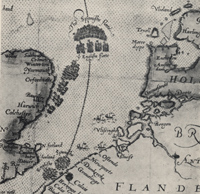
Armada off Suffolk July 1588
|
|
1588
|
In 1588 the country was expecting an invasion by Spain. All over England men were mustered to join the military. Chevington has records of nine men put under arms supplied by the local Paman family and other local gentry. This map was published in 1590 and is now in the British Museum. In August a Suffolk contingent were marched to Tilbury Fort under Sir John Heigham of Barrow Hall, High Sheriff of Suffolk.
These land defences were not needed as the Spanish Armada was defeated by Sir Francis Drake. However, the threat of domination by a foreign Catholic power helped to stir up further pressure to be put on Catholics refusing to go to church, who were also seen as potential traitors to the crown.
Despite Sir Thomas Kytson's promises to Queen Elizabeth to observe the new religion, both Thomas and his wife Elizabeth were included in a list of recusants compiled in 1588. They lived at Hengrave Hall.
|
|
1589
|
Plague revisited Bury in 1589, and as usual, attempts were made to isolate the victims. However, this outbreak became worse than others in recent memory and tents were set up, and families sent off to live in them. Plague was a summer time sickness, and perhaps tent life was better than being boarded up in your own home, as often happened in the next century. The next major outbreak with many deaths would come to Bury in 1636.
In 1589 Sir William Drury of Hawstead was a Colonel in France, and was killed in a duel with Colonel Sir John Burroughs over what Sir John Cullum called "a foolish quarrel about precedency". His body was brought home to be buried in Hawstead Church "where a fine marble bust of him in armour still remains."
Following Drury's demise, Sir William Waldegrave, Sir John Higham, Sir Nicholas Bacon and Sir William Spring were directed by the Queen to undertake the commission for the inquisition after his death to enquire into the annual value of his estates. The enquiry found, amongst other things, that "Roger Reve of Bury, gent, holds, by lease, (from Drury - ed) the profits of the fayres and markets in Bury, at £36 a year's rent, 40s deductions." At this date it therefore appears that the fairs and markets in Bury had been leased to Sir William Drury of Hawstead Place from the Crown, and that he had sub-leased these rights to Reve.
In 1510 Sir Robert Drury had gained permission to empark his estates. However, with the refurbishment of Buckenhams to become Hawstead Place, it seems that a new park was created around the estate in the 1580s. One set of particulars from the depositions after the enquiry into his will, was as follows:
"The new park is unletten, worth about 20 marks yearlie, besides profits of deer and conies. Another person valued the park very differently, unless he included the profits of the livestock in it: he said the new park is not very much charged with deer and conies; and worth yearlie £50."
Sir William Drury was succeeded by his son, Robert Drury, who was a friend of the poet John Donne. Donne would write Drury's daughter's epitaph and memorial elegies after her death in 1610.
|
|
1590
|
By the 1590's Suffolk Puritanism was so strong that about a third of the clergy had been reported for refusing to wear the surplice. The surplice itself had been a Church of England simplification of the original Catholic vestments. Puritan clergy were installed by Puritan patrons of their livings like Sir Robert Jermyn of Rushbrooke and Sir John Higham of Barrow. These two men alone controlled 15 benefices.
However, there were some strongly Catholic members of the gentry willing to take risks. In 1590 the Jesuit priest John Gerard spent a year with Edward Rookwood at Euston Hall.
|
|
1591
|
From 1586 to 1591, Sir Nicholas Bacon built himself Culford Hall on its present site. This probably replaced an earlier hall nearby.
The Jesuit priest John Gerard moved from Euston Hall to spend about a year with Henry Drury at Lawshall.
|
|
1592
|
John Wilbye came to Hengrave Hall as Chief of the Minstrels. He would stay there for 36 years, and during this time would write two books or sets of Madrigals. He became famous for these works, dedicated to the Kytson family of Hengrave.
|
|
1593
|
An inspection or 'visitation' of the Archdeaconry of Sudbury reported 81 ministers for refusing to wear a surplice. This was a sign of extreme protestant views, which were out of step with the Queen's Reformation rules.
This was not just the case in urban areas. At St Andrews Church in Barningham the rector, Andrew Carter, "doth not usually wear the surplice, nor usually say service upon the week days. He preacheth, but whether licensed or no, they know not."
Churchmen had to be licensed to preach without a script, and the approved sermons were published in 1562, and re-issued over the years. This was the Book of "Certain Sermons or Homilies, appointed to be read in Churches." It contained 33 sermons in the 1683 edition, and if the incumbent was not licensed to preach, then he had instead to read out one of these homilies at his services.
Andrew Carter seems to have avoided any extreme official censure, as he was rector of Barningham from 1584 to 1624, a remarkable 40 years.
|
|
1594
|
The Feoffees appointed 31 Overseers to to distribute out - relief to the poor in their own homes, as distinct from the indoor relief given in almshouses. This was a bad year for the poorer classes as prices were unusually high. The Feoffee's had to spend £80 to buy wool for the poor to card and spin, and thus meet some of the costs of their own relief. They also paid £60 for coal which was distributed to the elegible poor.
|
|

Sermons from Bury
|
|
1595
|
The sermon, that ‘immortal seed of regeneration’, was a central concern of the Elizabethan and Jacobean church. The Bury St. Edmund’s lecturer, Dr Miles Mosse’s "The Arraignment and Conviction of Usurie" was originally delivered in six sermons at Bury. The treatise was published in book form "by the Widow Orwin for John Porter", in 1595. Mosse included a long dedication to the Archbishop of Canterbury which he concluded with the dateline, "Bury St Edmunds this first of Ianuarie. 1595."
According to a University of Paris website, Miles Mosse was the son of Miles Mosse of Chevington, and was born in 1558. He was educated at Bury Grammar School and Caius College, Cambridge, gaining his first degree in 1579. In 1585 he became vicar of St Stephens in Norwich. In 1586 he became the Reader at St James in Bury St Edmunds at a salary of £48 a year. He would be Rector of Combes in Suffolk from 1597 until his death in 1615.
Mosse has been credited with producing the most elaborate discussion of usury in the latter part of the sixteenth century. Such a work and the debates it inspired would be reflected in William Shakespeare's play, "The Merchant of Venice", produced in 1619.
To compose an effective sermon, access to books was considered crucial. Mosse cited one hundred and fifty seven authors, prefacing his work with a list of pre-Reformation authorities running into several pages. These books had most likely been in the hands of the great monastery libraries before 1539.
The library of the abbey of St Edmund had long since been broken up, and individual collectors had acquired some of these books. Unfortunately we do not know the source of the books quoted by Mosse, or who their current owners were. Mosse saw that it was essential to build up a new library in Bury St Edmunds for use in the education of local clergy. As he was the lecturer at St James's, (now the cathedral), the new library was founded at the east end of the north aisle of that church. Mosse generously donated volumes on various topics from his own collection. He continued to donate items, as did other rich local patrons of the church. By 1599 the St James library would hold 138 titles.
J S Craig has suggested that the St James Parish Library was the first parochial library of its kind in the country, as distinct from collections of prescribed texts or school books. The St James Parish Library, founded in 1595, still survives today as a nationally significant parish library. After being moved around Bury St Edmunds over the years, it is now housed in the Cathedral of St James Library building of 1959 to 1965. It is important to note that it is not a continuation of the Abbey library which was dedicated to Catholic works. The St James parish library was a new compilation of dedicated Protestant thought.
The markets and fairs, tolls and other rights at St Edmundsbury were leased by the crown to Sir Nicholas Bacon. These old monastic rights were still in the hands of the crown, and while this situation continued Bury's local autonomy remained weak.
|
|
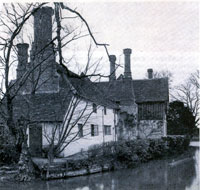
Otley Hall 1912
|
|
1596
|
Bartholomew Gosnold came from a well to do family who had lived at Otley Hall, at Grundisburgh, eight miles north of Ipswich, for over a hundred years. It is said that he was brought up hearing stories of red indians brought back by the likes of Martin Frobisher and Sir Walter Raleigh. In 1596 he sailed to the Azores with the Earl of Essex and he would continue to attempt to explore new lands until his death in 1607 at the colony of Jamestown in America.
|
|
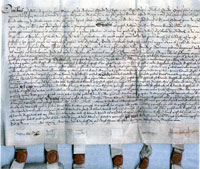
Gosnold Land Deed
|
|
1597
|
By April 1597, Bartholomew Gosnold and his wife Mary, (maiden name Golding), were living in Bury St Edmunds. The Gosnold family also sold some land at Great Barton in that year, and the deed survives in the West Suffolk Record Office to this day. It was only noticed in 2007, when research was being undertaken into the family to prepare for the centenary celebrations of the founding of Jamestown. It was displayed as part of those celebrations. Bartholomew's signature and seal is second from the left.
Bartholomew and Mary Gosnold's daughter Martha was baptised at St James's church in Bury in 1597. Unfortunately she would die before she reached her second birthday.
The Bishop of Norwich found that 81 of the church ministers in the Archdeaconry of Suffolk were refusing to wear the surplice, a sure sign of extremist puritan beliefs. Together with the 83 found in the Sudbury archdeaconry in 1593, this meant that about one third of the clergy in the County of Suffolk were Puritans.
In 1597 the Manor of Great Saxham was bought by John Eldred, a great merchant-adventurer to places like Tripoli and Babylon. Eldred was born in 1552 at New Buckenham in Norfolk, where his father had moved from Knettishall in Suffolk. He was already a well-to-do merchant when 'upon Shrove Monday 1583' he 'departed out of London in the ship called the Tiger, in the company of Mr. John Newbery, Mr. Ralph Fitch, and six or seven other honest merchants.' They arrived at Aleppo on 11 June 1584. For the next three years Eldred made Aleppo his headquarters for further explorations. The real motivation was not exploration as such, but to buy vast quantities of merchandise, consisting mainly of spices; bales of cinnamon and nutmeg. He returned to London on 26 March 1588, in the Hercules of London, which was 'the richest ship of English merchants' goods that ever was known to come into this realm.' A large part of these riches appears to have belonged to Eldred.
Having bought the manor of Great Saxham in Suffolk for £3,000, he built a large five gabled mansion which came to be popularly known as 'Nutmeg Hall.' He continued, however, to reside chiefly in London, engaged in business. When the East India Company was started, he was a large subscriber. Eldred died in 1632, and Nutmeg Hall stood until it burnt down in 1779.
Also in 1597 the manor of Murrells in Little Livermere was acquired by William Cooke of Barrow, and his brother in law, William Chapman. In 1603 they would purchase the manor of Great Livermere, known also at this time as Broom Hall. This manor included a mansion house, a gatehouse and closes. In 1617 they decided to allocate Broome hall to Cooke and Murrells to Chapman. However, upon their deaths, both manors would pass to Cooke's son, Richard Cooke. This combined property in Great and Little Livermere would be in Cooke family hands for just over a century.
|
|
1598
|
Bartholomew Gosnold was living in Bury St Edmunds at this time. In 1598 he made a fortune while on an expedition with the Earl of Essex. They captured a Spanish ship, and under the law at the time they were able to share in its disposal proceeds.
|
|
1599
|
Alderman William Smart, Portreeve of Ipswich died, and left his collection of monastic documents to Pembroke College, Cambridge. This collection included 110 manuscripts from the library of the abbey at Bury St Edmunds. Around 260 Bury Manuscripts are thought to still exist today, the bulk of them at Pembroke College. They represent by far the greatest surviving nucleus of any of the great monastic libraries. The Medieval Manuscript Library of Pembroke College, Cambridge, today consists of just over 300 manuscripts in total, so over one-third of the library is from St Edmund's.
|
|
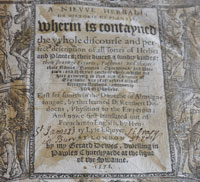
Dodoen's Herbal in English, 1578
|
|
blank |
At the church of St James, in Bury St Edmunds, the preacher Miles Mosse had helped to set up a new library in 1595 to serve to spread the godly message to the clergy and laiety of the district. An inventory dated 1599 shows that there were 138 volumes held in the north aisle at that time. The donors were also recorded at the time. Miles Mosse himself had given books, as had members of the clergy of several parishes around Bury. The gentry were also generous, including 15 volumes of Calvin donated by Sir Robert Jermyn of Rushbrooke. His half brother Henry Blagge gave books, as did his brother William Jermyn. Local tradesmen could demonstrate their wealth, as well as their piety, by providing volumes for the public good. Henry and Thomas Bright had made money in the cloth industry, and John Bye and Augustine Gooch were maltsters in the parish of St James. From St Mary's parish the clothiers Thomas Bennet and John Lansdale donated volumes.
These books were still mainly printed in latin, but a few, including Dodoen's Herbal, were printed in English. Books would continue to be donated into future centuries.
The first recorded account of a witch trial at Bury St. Edmunds was held in 1599 when Jone Jordan of Shadbrook (Stradbroke) and Joane Nayler were tried, but there is no record of the charges or verdicts. In the same year, Oliffe Bartham of Shadbrook was executed, for "sending three toads to destroy the rest (ie sleep) of Joan Jordan".
The century ended with a year in which William Shakespeare wrote his plays, "Henry V", "Julius Caesar", and "As you like it". He had started work on one of his greatest plays, "Hamlet".
There had been another rebellion in Ireland, known as the Tyrone Rebellion, and the country had been thrown into a panic with rumours of a second Spanish Armada.
|
|
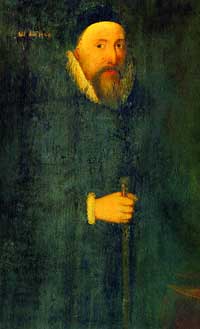
Thomas Bright
|
|
1600
|
At about 1600 to 1601 a group of notable Bury townspeople led by Thomas Bright of the Guildhall Feoffees, met and agreed to share the costs of petitioning the crown for a grant of incorporation. They agreed to contribute £68:5:0 each. In August 1601 Sir Robert Jermyn wrote a letter to Sir Robert Cecil to object to any incorporation for Bury St Edmunds.
Sir Nicholas Bacon assigned his market lease at Bury to Sir Robert Drury of Hawstead.
In 1600 it was still possible for sailing boats to reach Mildenhall on occasion, from the sea. The tidal nature of the Great Ouse penetrated deep inland. Sea fish had been occasionally caught as far upriver as Cambridge. However, it was also generally agreed that the Fens were drowning under constant inundations.
In 1600, an Act of Parliament was passed for the recovery of many hundred thousand acres of marshes. Adventurers, as they were known, could venture to carry out drainage projects at their own cost, in return for which they could keep large acreages of the land so recovered. No major work took place for some decades.
|
|
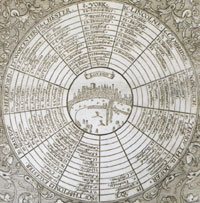
Distances from London by W Dight
|
|
blank |
Although maps were scarce and often inaccurate, travellers still needed to know how to make their way from place to place. Christopher Saxton's map of Suffolk, published in 1575, made no attempt to show roads between towns, so other ideas had to be employed. One method was to rely upon riding from town to town, along well known roads, hopefully marked by signposts. You could find out the towns to visit by consulting one of the lists which were available. This picture shows a Distance Table from London, at its centre, to places at all points of the compass. For our region it gave the then current accepted routes from London to Cambridge, Norwich and Yarmouth, together with the mileage between the named places.
The route from London to Norwich did not pass through Bury St Edmunds, but from Newmarket the traveller was advised to pass through Icklingham and then head for Thetford. This part of the old London to Norwich route is just an unmade dirt track today, and is largely forgotten.
This version of a Distance Table was published by Walter Dight in 1600, and was an indispensable aid to the carters, carriers and merchants trading to and from the capital, as well as to the thousands of visitors to London. By clicking on the thumbnail picture you can see an enlarged version of it, as usual. Also, you can see a close-up view of our three local routes by clicking on the link shown here Close up on Cambridge,Norwich and Yarmouth
|
|

Will Kemp
|
|
blank |
William Kemp was an actor who was well known in his time. In 1594 he had joined the Lord Chamberlain's Men acting company along with Richard Burbage and William Shakespeare.
He was associated with at least two roles in Shakespeare plays, known from notes in surviving scripts. These were Dogberry in Much Ado About Nothing and Peter in Romeo and Juliet, although he would certainly have acted in most productions of the company. In 1600 he decided to try a solo career.
During February and March of 1600, Will Kemp performed his feat of the "Nine Daies Wonder", when he attempted to dance from London to Norwich in nine days. In his own reckoning this would have occurred in 1599, under the dating style in use at the time, but we would reckon it as 1600. He did not count lost time when he was not dancing, and the whole trip to Norwich took nearly four weeks. This is how he began his entertaining account, followed by his account of passing through west Suffolk:
"THE first mundaye in Lent, the close morning promising a cleere day, attended on by Thomas Slye my Taberer, William Bee my seruant, and George Sprat, appointed for my ouerseer, that I should take no other ease but my prescribed order) my selfe, thats I, otherwise called Caualiero Kemp, head-Master of Morrice-dauncers, high Head-borough of heighs, and onely tricker of your Trill lilles, and best bel-shangles betweene Sion and mount Surrey, began frolickely to foote it, from the right Honorable the Lord Mayors of London, towards the right worshipfull (and truely bountifull) Master Mayors of Norwich......."
He danced out of London via Romford and on to Chelmsford, and then to Braintree.
By the fifth day he had reached Sudbury:
" In this towne of Sudbury, there came a lusty tall fellow, a butcher by his profession, that would in a Morrice keepe mee company to Bury: I being glad of his friendly offer, gaue him thankes, and forward wwe did set: but ere wee had measur'd halfe a mile of our way, he gaue me ouer in the plain field, protesting, that if he might get a 100. pound, he would not hold out with me; for indeed my pace in dauncing is not ordinary........"
"At Melford, diuers Gentlemen met mee, who brought me to one master Colts, a very kinde and worshipfull Gentleman, where I had vnexpected entertainement till the Satterday. From whose house hauing hope somewhat to amend my way to Bury, I determined to goe by Clare, but I found it to be both farther and fouler....... "
" I keeping on my course to Clare, where I a while rested, and then cheerefully set forward to Bury.
Passing from Clare towards Bury, I was inuited to the house of a very bountiful widdow, whose husband during his life was a Yeoman of that Countrie, dying rich no doubt, as might well appeare, by the riches and plentie, that abounded in euerie corner of the house. She is called the widdow Eueret.
At her house were met aboue thirty Gentlemen. Such, and so plentifull variety of good fare, I haue very sildome seene in any Commoners house. Her behauiur being very modest and freendly, argued her bringing vp not to be rude. She was a woman of good presence: and if a foole may iudge, of no smal discretion.
From this widdowes I daunst to Bury, comming in on the Satterday in the afternoone, at what time the right Honorable, the Lord Chiefe Justice entred at an other gate of the towne, the wondring and regardles multitude making his honor cleere way, left the streetes where he past to gape at me: the throng of them being so great, that poore Will Kemp was seauen times stayed ere hee could recouer his Inne. By reason of the great snow that then fell I stayed at Bury from Satterday in the second week of my setting foorth, til Thursday night the weeke following. "
"VPON Fryday morning I set on towardes Thetford, dauncing that tenne mile in three houres: for I left Bury somewhat after seauen in the morning, and was at Thetford somewhat after ten that same forenoone. But indeed considering how I had been booted the other iourneys before, and that all this way or the most of it was ouer a heath, it was no great wonder: for I far'd like one that had escaped the stockes, and tride the vse of his legs to out-run the Constable: so light was my heeles, that I counted the ten mile no better than a leape.
At my entrance into Thetford, the people came in great numbers to see mee: for there were many there, being Size time. The noble Gentleman Sir Edwin Rich, gaue me entertainement in such bountifull and liberal sort, during my continuance there Satterday and Sunday, that I want fitte words to expresse the least part of his worthy vsage of my vnworthines: and to conclude liberally as hee had begun and continued, at my departure on Munday, his worship gaue me fiue pound. "
From Thetford, Kemp danced to Rockland and Hingham, to Barford Bridge and into Norwich, where he collected five pounds in Elizabeth Angels, and was given a pension of 40 shillings a year.
In Scotland, it was decided that the year should no longer officially begin on March 25th, as it had hitherto in England, Scotland and Wales. Thus in Scotland January 1st was adopted as the official legal and civil start of the New Year, bringing Scotland more closely into line with the continental practice. This meant that the year 1600 began in Scotland three months earlier than it did in England. So a date of, say, 10th January would be called 10th January, 1600 in Scotland, but 10th January, 1599, in England. This discrepepancy would continue until England, Scotland and Wales adopted the Gregorian calendar in September, 1752.
|
|
1601
|
In 1601 a new Poor Law came into operation. The parish vestry had to appoint Overseers of the Poor whose job was to levy a Poor Rate on the owners of land, and oversee distribution of the revenue to the necessitous poor. This was the start of the Rating System which survived in ever more sophisticated form until 1992, when it was abolished on domestic property but retained on commercial premises.
|
|
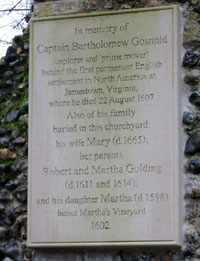
Gosnold Memorial of 2007 |
|
1602
|
Bartholomew Gosnold put together an expedition to found a colony at Cuttyhunk in the Americas. He named the area the Elizabeth Isles after the Queen. He also named Martha's Vineyard after Martha, his first daughter, who had died before she was aged two, in 1600. He also discovered and named Cape Cod. The colony failed after 12 weeks due to lack of food and they returned home. He would soon return to America.
Gosnold has always been described as "of Otley Hall in Suffolk", and indeed, his father did own Otley. However, Bartholomew's daughter Martha was baptised at St James's church, Bury St Edmunds, in 1597, as were his son Robert in 1600, Susan in 1602, Bartholomew in 1603, Paul in 1605, and another Martha in 1607. Thus Bartholomew Gosnold was living in the parish of St James at Bury St Edmunds during the time of his explorations of America.
The attached memorial plaque was erected in 2007 on the Chapel of the Charnel in the Churchyard at Bury St Edmunds, as part of the celebrations to commemorate the founding of Jamestown.
|
|

King James I
|
|
1603
|
Good Queen Bess died and King James VI of Scotland became James I of England on 24th March, 1603, the first Stuart to rule England. The new king had been King of Scotland since 1567, when only a child. James I would reign until 1625.
James I had more extreme religious views than had Queen Elizabeth I, who believed in keeping things as moderate as possible in an attempt to keep most people happy. James had a strong belief in witchcraft, and so a new Witchcraft Act was passed which gave the penalty for practising witchcraft to be death by hanging.
Thomas Bright of Bury St Edmunds would make seven journeys to London and one to Royston, where James I frequently stayed, over the years from 1600 to 1603 in pursuit of the granting of a Charter for Bury.
Robert Reyce seems to have produced his "Breviary of Suffolk" in the years from 1603 to 1618. This was a description of the county at the time, which was re-published in 1902 by Lord Francis Hervey. Reyce noted that hops were an expanding Suffolk crop at this time, some marshes were even drained to grow hops. Reyce was a Puritan himself, and he commended "the great number of religious, grave, reverend and learned ministers of God's holy word, which are planted in this shire."
Reyce's Breviary commented upon the clothing industry. "Another large benefit wherewith this county is furnished is the excellent commodity of clothing, which of long time hath here flourished, enriching the country and bringing thereunto not a little praise and commendation......these artificers do set many poor persons a-work which otherwise knew not how to live." Reyce reckoned that the production of 20 broadcloths a week needed 500 people to be employed in the full range of trades thus involved.
Reyce also noted that "there is another kind of this trade, not long since found out, by which many of the poorer sort are much set a-work, and with far more profit, as they say, this trade is commonly called Kembing." This kembing or wool combing came about because of the demands of the New Draperies. The spinners now needed a fine and very clean wool to make the fine thread required for the modern stuffs. The finished yarn was sent to London , Norwich and other places. The combers would sort, wash, comb and trim the raw wool before it went for spinning, in a way that had been unecessary for the old heavy broadcloth production.
Also from this time, of around 1600 to 1605, comes the "Chorography of Suffolk", whose author is unknown. It was never published at the time, and it was very little known until it was finally published by the Suffolk Records Society in 1976. This author noted that butter and cheese were made in exceeding great quantity in High Suffolk. The entry for Bury St Edmunds appears to have been lost.
|
|
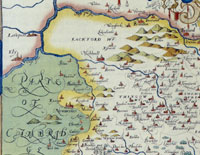
River Lark 1575 by Christopher Saxton
|
|
blank |
However, the Chorographer does seem to throw a possible light on the use of the word Burn for the River Lark.
He described the rivers of Suffolk, but he had no name for our River Lark. His source for this seems to have been Saxton's Map of Suffolk, dated 1575, with a dash of his own ideas thrown in. Saxton's spellings were perpetuated and further bungled by the chorographer. On the Lark he wrote as follows:
"Not farre from Burne Bradfeld above the greater Feltham springs another litle river that runneth to Nawton, Burye, Fernhams, Hengrave, Flempton, Lackforde, Icklingha', Berton & Mildenhall & between Islam in Cambridgeshire & Worlington in Suff. it meeteth with another litle river that springeth about Catlidge (called the Dale water) in Cambridgeshire & Lidgate in Suff. which from that in a continuall streame dischargeth itself into the Greater Ouse betwene Ely and Littleporte in Cambridgeshire."
This note was adjacent to a paragraph heading of "Burne fl", presumably short for Burne fluvius or River Burne. Burne Bradfeld comes from Saxton's map, where it is written as the one word Burnebradfeld, referring to the village now called Bradfield Combust. This erroneous jotting may be thought to be the derivation of the name Burne used for the Lark in the Act of Parliament to be passed in 1699/1700.
Elsewhere in the Chorography, the author uses the more familiar version of the village name of "Burnt Bradfelde alias little Bradfelde".
According to the modern calculations of John Patten in 1979, Bury had grown from a population of 3,550 in 1525 to 4,500 in 1603. Ipswich had grown much more in the same time from 3,100 to 5,000. Bury was the largest town in Suffolk in 1525, but Ipswich had overtaken it by 1603.
|
|
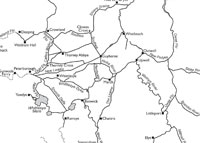
Fenland waterways 1604 redrawn by M Chisholm
|
|
1604
|
In 1604 William Hayward published a map of the main elements of the river systems in the Fens at a scale of one inch to the mile. His original map has been lost and we are reliant upon later copies, particularly that of Payler Smith, drawn in 1727.
Professor Michael Chisholm has re-drawn and adjusted this map and published it in the Proceedings of the Cambridge Antiquarian Society in 2010, with further considerations in PCAS 2011. Clicking on the thumbnail will reveal the full map.
The pecked lines show rivers which extended outside the scope of Hayward's map. Hayward's names are retained.
Chisholm suggested that Crowland, and its triple arched Trinity Bridge, was a key factor in the medieval navigational network. Chisholm called a key waterway here the Crowland Cut, an artificial canal which Hayward called Nene flu., linking the Nene and Welland.
A new lease of the market rights at Bury was made for 40 years to Sir Robert Drury by the Crown. According to Cullum's History of Hawstead, Drury had to pay £36.13s.4d annual rent for this privilege. In return he was free to manage the market and set such rents as he thought fit, keeping any such income for himself. In this way he expected to make a profit, as well as having a significant part to play in the management of Bury's commercial life.
James I ended the war with Spain which had been ruinous to the manufacturing trade, although agriculture had grown by leaps and bounds to become highly profitable.
|
|

Seventeenth Earl of Oxford
|
|
blank |
In 1086 the estate of Lavenham was in the possession of Aubrey de Vere I, ancestor of the Earls of Oxford. He had already had a vineyard planted there. The de Vere family continued to hold the manor of Lavenham as Earls of Oxford until 1604, when it was sold to Sir Thomas Skinner, an Alderman of London, and friend of Edward de Vere, the 17th Earl of Oxford. The de Vere connection with Lavenham thus ended after 500 years due to the profligacy and immoderate character of the 17th Earl. By July, 1604, the 17th Earl of Oxford was dead.
Contemporary critics such as Webbe and Puttenham praised de Vere's poetic ability, and his verses were published in several poetry miscellanies. A stream of dedications praised Oxford as an intellect and poet, although they were written by those seeking patronage. His lifelong patronage of writers, musicians and actors prompted his modern editor Stephen May to term Oxford 'a nobleman with extraordinary intellectual interests and commitments'.
In "Shakespeare Identified", published in 1920, J. Thomas Looney, an English schoolteacher, proposed the 17th Earl of Oxford as a candidate for the authorship of Shakespeare's works. His theory was based on perceived analogies between Oxford's life and poetic techniques in Shakespeare's plays and sonnets. It supplanted an earlier popular theory involving Francis Bacon. Academic consensus today rejects all alternative candidates for Shakespeare's authorship, including Oxford.
At Melford a virulent plague struck the town in May 1604, when 15 people died in that month. In June, another 14 died, and things grew worse in July and August when 92 deaths were recorded. Nearby locations do not seem to have been affected quite so badly, and there must have been strenuous efforts made to prevent it from reaching beyond Melford. Plague was specifically recorded as a cause of death at Castle Hedingham and at Stoke by Nayland, but higher than average death rates seem to have also occurred at Boxted, Cavendish, Sudbury, Stradishall, Cockfield, Bildeston, and Halstead, according to Lynn Boothman in "Long Melford- the last 2,000 years." This attack of the plague had burnt itself out by the end of September.
|
|

Coldham Hall 2009
|
|
1605
|
A failed attempt to blow up Parliament became known as the Gunpowder Plot. Bury St Edmunds and its surrounding countryside still held many Catholic families, many of them officially recorded as recusants, that is they refused to attend Protestant services. It was not unusual to install priest holes into their grand houses in which a travelling priest could hide in the event of a visit from the authorities. Nicholas Owen of Oxborough Hall in Norfolk was the architect of many such installations. At Coldham Hall in Stanningfield, Ambrose Rokewood had such a priest hole in his house. Coldham Hall had been built by his father, Robert, in 1574. Ambrose Rokewood was a rich young Catholic with a reputation for his stable of fine horses. Somehow, very late in the Gunpowder Plot, he was persuaded to supply the plotters with swift horses for their escape. The plot was discovered on November 5th 1605, and by the following January the plotters, including Rokewood were hanged, drawn and quartered for treason.
Ipswich had been appointing Puritan town preachers since the time of Queen Elizabeth. The most notable of these was to be Samuel Ward, the son of John Ward, the Puritan preacher from Haverhill. At the age of 28, Samuel was appointed Town Preacher for Ipswich on 1st November, 1605. His uncompromising views on how the Reformation should be carried forward were fully supported by Ipswich town and corporation, and he remained in this post until his death in 1640.
In 1605 King James I was coursing hares at Fordham with his dogs, having taken lodgings at the Griffin Inn on Newmarket's High Street. Hare coursing was a great aristocratic sport at this time, as was stag hunting and hawking. The area around Newmarket was well known for these pursuits at this period, but horse racing was not among them at this time. These sports were very much subject to their own rules and regulations, and were not for the ordinary folk to pursue. Thomas Howard, 4th Duke of Norfolk had drawn up the "Laws of the Leash" in the 16th century, to illustrate the proper manner in which the hunt should be organised.
Newmarket at this time was little more than a staging post along the old Icknield Way route. It had about 400 houses and most people depended upon agriculture and work in the many coaching inns and rest houses strung along the highway. The presence of the King was to transform the village into a centre for the royal court and make it into a centre for sporting interests of all kinds. With the influx of wealthy courtiers attending upon the king, and the crowds of local gentry who came hoping to see his royal presence, there would now be a boom in new shops and trades of all descriptions.
|
|
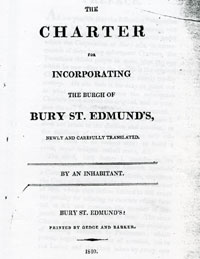
Charter translated in 1810 |
|
1606
|
In April 1606 the King granted a charter to the town of Bury St Edmunds, setting up a corporation of 37 members. In legal terms, the word charter has no meaning, technically this document was what is called Letters Patent. Nevertheless, this was the first time that the town had an official form of local self-government.
The charter acknowledged that Bury was already a borough "by prescription", as follows:
"Whereas our town of Bury St Edmund's, in our county of Suffolk, is a burgh, or ancient and populous town,: and whereas also the inhabitants of the same burgh or town, in times past, have had, used and enjoyed, divers liberties, privileges, customs, franchises, freedoms and prerogatives, as well by reason of divers Charters and Letters Patent, as by reason of divers prescriptions and customs,in ancient times, used within the same town or burgh: and......"
Whether these were just a catch-all form of words to cover all possibilities is not all that clear to us today. However in the book, "The English and Welsh Boroughs", the author ranks Bury with other Boroughs by Prescription. Nevertheless, this charter put the matter beyond doubt, and created the corporate body of "Alderman and Burgesses of Bury St Edmunds, in the county of Suffolk."
There were to be 12 Capital Burgesses, 24 Burgesses of the Common Council and 1 Alderman, roughly equivalent to the Mayor of today.
This document is known locally as the Charter or First Charter. The full text of the Charter of 1606 is available to view by clicking here, but you will find that it is 57 pages in all.
|
|
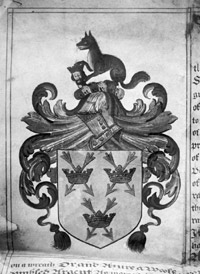
The grant of arms |
|
blank |
In November the Borough Council received a grant of arms, but no motto. The town was free to choose its own motto as it wished. The current motto was not apparently in use prior to 1850.
Any Grant of Arms comes not from the King, but from the College of Heralds. The full text of the Grant of Arms 1606 is available to view by clicking here.
The Corporation could elect four Justices of the Peace, called Assistants, pass bye-laws and appoint a Town Clerk and a Recorder. The towns' first Alderman was Richard Walker, and he was entitled to be preceded in processions by two Sergeants-at-Mace carrying Maces of gold or silver adorned with the royal coat of arms. Over half the members of the new Corporation were existing Guildhall Feoffees. Lobel reported that at least 20 of the 29 appointees were the same men who had fattened on the embezzled profits of the town lands, and who were now endowed with a new legitimacy.
Monastic rights which had passed to the crown were now passed to the new corporation. They were allowed their own Justices of the Peace and gaol delivery, and exemption from interference of any royal justice. The alderman and capital burgesses controlled the assize of wine, bread and ale, and the sale of all food and drink. They were to act as clerk of the market, and fairs. A fair was to be held yearly in Easter Week, with a court of Piepowder.
The new corporation moved the town courts from the market Toll House into the Guildhall. The five essentials of being incorporated were:- perpetual succession, the power of suing and being sued in the name of the corporation, power to hold land, possession of a common seal, and authority to make bye-laws.
The borough did not get the power to hold its own Quarter Sessions until the Charter of 1614.
Following the Gunpowder Plot of 1605, Parliament passed the 1606 'Act for the better discovering and repressing of popish recusants'. The churchwardens and constables of towns were required to bring to the Quarter Sessions all the recusants who had not attended a Church of England service for a month.
In April, 1606,King James I issued charters to set up two joint stock companies to establish colonies in America. They were the Virginia Company of London, and the Virginia Company of Plymouth. The London Company was founded and organised by Bartholomew Gosnold, the Suffolk man who had already sailed to those waters.
In December, 1606 Bartholomew Gosnold once again sailed with an expedition which he had planned for three years from his home in Bury St Edmunds, and at his father's estate at Otley Hall, Suffolk. Gosnold himself had recruited the settlers, and raised the finance. Gosnold recruited 105 settlers and 55 crew. Forty of the settlers were from East Suffolk villages around Otley.
However, from the beginning there were problems when the royal patent required Christopher Newport to be made Admiral to lead in the biggest of the three ships. Gosnold was only made vice-admiral sailing the Godspeed. There was a mutiny on the voyage as the sailors wanted Gosnold to lead, and three men were sentenced to death, then held in irons from February 1607 to July. One of the prisoners was called Captain John Smith from Lincolnshire.
|
|
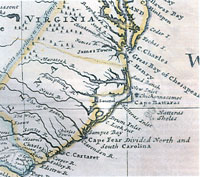
Virginia
|
|
1607
|
Bartholomew Gosnold's three ships (Susan Constant, Discovery, and Godspeed), arrived in America, finally sailing 50 miles up the James River in Virginia to set up James Fort on May 14th 1607. Today's Jamestown would be set up a few years later further down the river. Some say that upon a vote, taken while Gosnold's supporters in chains could not participate, Gosnold's cousin Edward - Maria Wingfield was elected governor. Others say that there were sealed orders from the crown nominating the governor and council. The triangular fort was attacked by Indians, but severe illnesses also broke out, so that on August 22nd, Batholomew Gosnold died, and his role was largely forgotten.
The colony still suffered from internal strife and Wingfield was deposed and replaced by John Smith, who has for many years been regarded, perhaps wrongly, as the founder of Jamestown.
Mary Gosnold, Bartholomew's wife, lived out the rest of her days apparently at Bury St Edmunds, where she was buried on 23rd October, 1665, at St James's Church.
The Borough of Bury St Edmunds made its first byelaws in 1607, as allowed under the charter of 1606. These included byelaws "For the better ordering of the market" and "For usage of the Faires and Markets by strangers". Hogs and swine were forbidden to roam free in the streets, householders had to clean the gutters and street outside their houses, keep the road outside free of obstructions and hang out a lantern every night to light the street from November to February.
Margaret Statham has pointed out that 27 of the new bye-laws related to the activities of Bakers in the town. They could have a company, society or fellowship, provided it was approved by the corporation. This may have been passed to legitimise the existence of the old Guild of Bakers, first set up by 1180, but we do not know if it had survived the dissolution or not. Now its members had to be Freemen of the Borough, and as before, had to keep to the rules, or Assize, of bread making.
Bye laws also covered the activities of Linen Weavers, and like the bakers, any fines levied were divided into three parts. One third went to the Corporation, one-third went to the company of weavers or bakers as appropriate, and one-third went to the poor of the town.
Another bye law said that plays could not be performed in inn yards without a license by the travelling players of the time. Inn yards often had purpose built galleries to allow spectators to enjoy such entertainments.
In 1607 King James I was again hunting around Newmarket, taking his customary rooms in the Griffin Inn. However, this became public knowledge, and one lady in particular, Lady Buckhurst, was constantly annoying him by her persistence for his company. He now decided that he could no longer lodge within a common inn, and so purchased the Griffin for his private use. He quickly decided to have it demolished and replaced by new Privy Lodgings. These apartments were built between 1607 and 1610, and represent the first of three royal "palaces" to be built in Newmarket. After 1607 the King and his Queen, Ann of Denmark, lived apart.
|
|

St Edmundsbury Fire
|
|
1608
|
There was a serious fire in Bury in 1608, and the old market hall was burnt down. The fire started between 8 and 9 am, on Monday, 10th April in Eastgate Street in the malt house of a Bury Maltster called James Randall. A malthouse might use fire in a special kiln to help dry the grain and then to promote germination. A negligent servant was blamed for letting things get out of hand, and the resulting blaze burned for 3 days spreading up Northgate Street, into Looms Lane, into the Market Place, possibly ending at Woolhall Street on one side and the Suffolk Hotel on the other. The Market Cross, built in 1583, and Toll House also burned down. This event proved the vulnerability of the old timber and thatch houses which still predominated in most towns in the land. Some 160 dwellings and 400 outhouses were destroyed, worth about £60,000.
The new corporation quickly added a new byelaw to the 132 passed in 1607. Thatch was prohibited as a roofing material in the town as it was blamed for allowing the wind to spread fire and "disperse itself into so many places". The modern legacy of this fire is that the east and centre of the historic grid pattern of the town no longer contains property older than 1608, whereas many properties to the west side still retain medieval structures hidden within them.
On July 1st the King granted the Town a second Charter which dealt with matters to help recovery from the fire, but included what they had always wanted, : the Market rights and tolls. This Charter cost over £300 and the Feoffees agreed to finance this cost.
Following the fire, James I's second grant of privileges to the Borough contained what was technically only the reversion of the 1604 lease to Sir Robert Drury for the tithes, fairs, markets and other rights. This is often referred to as the Market Charter, but because of the existing lease all the tolls and rights still went to Sir Robert! The alderman and burgesses also received the farm called Almoners Barns, the gaol and fire damaged toll house, both located on the Cornhill at the foot of today's Woolhall Street, the market cross and bell, the right to appoint the gaol keeper, and the right to collect landmol rents. This charter also gave the town a considerable amount of timber to help with the rebuilding. This charter is described elsewhere on this website. Click here for more on The Market Charter. (Then use your browser "Back" button to return here.)
|
|
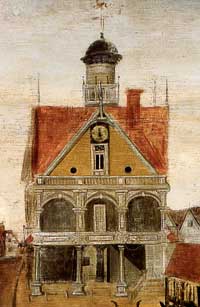
The Market Cross
|
|
blank |
The market cross on its present site was built soon afterwards with an open ground floor and was used as the corn exchange. It was needed to replace the Market House built in 1583, and destroyed in the fire. It is shown in this view as it appeared by about 1699. Although referred to as a cross, it was a substantial building, with steps to the upper floor.
During 1608 the Clothmakers Company was established in Bury St Edmunds in order to maintain the standards of cloth making in Bury and the surrounding area. There were 20 Associate members of the Company, including Roger Grome of Lavenham. However, the cloth making industry in the old traditional Suffolk broadcloths was already in deep trouble. Dutch immigrants had set up communities in Braintree, Colchester and Norwich early in the last century, and these were now well established in the production of what were called "The New Draperies". These had rapidly become fashionable in the later 16th century, and were also much lighter and cheaper to produce than broadcloth, and thus could enjoy greater sales at lower prices. The old broadcloth producers were reduced to selling their heavy weatherproof cloth into the Baltic and other countries where a harsher climate prevailed.
During 1608 it appears that Captain Christopher Newport had returned from Jamestown in Virginia to ferry more men and supplies to the new colony there. Despite the delivery of supplies in 1608 on the First and Second Supply missions of Captain Christopher Newport, it seemed likely that without a major relief effort, the colony at Jamestown would meet the same fate as two earlier failed English attempts to settle in North America, the Roanoke Colony and the Popham Colony. So the Virginia Company of London commissioned a larger vessel, probably to be built at Aldeburgh, which became called the Sea Venture.
Norwich City Library was set up in 1608, according to the Norfolk County Council website. It was the first library to be established by a local administration in England outside London. In that year the City Assembly ordered that three rooms at St. Andrew’s Hall were to be converted into a library. However, at this time the library was not meant to serve lay people. According to the minute in the Assembly Book, the library was established ‘for the preachers’ and for a ‘lodging room for such preachers who shall come to this city to preach’. The new library was not just for the benefit of the city clergy but for clergy travelling to the city from elsewhere who had to find overnight lodgings. It is likely that these visiting clergy would have been combination lecturers, beneficed ministers who preached at the cathedral in the ‘common preaching place’ or greenyard in rotation. Combination lectures took place weekly or fortnightly, drew their audiences from a wide catchment area and were supplied by a panel or combination of preaching clergy. It was common practice for the combination to be present at each lecture and for the lecture to be followed by dinner and a clerical conference. Interest in religion was clearly a high priority for life in East Anglia at this period.
|
|
1609
|
The Sea Venture was launched at Aldeburgh and sailed to Plymouth to join a fleet to be sent to relieve the colony at James Fort in Virginia.
On June 2, 1609, the Sea Venture set sail from Plymouth as the flagship of a seven-ship fleet (towing two additional pinnaces) destined for Jamestown, Virginia as part of the Third Supply, carrying 500 to 600 people. Once in the West Indies the fleet was scattered by a violent storm, and only the Sea Venture herself survived. She was beached on the island now called Bermuda, and that land was claimed for England. They now built two further vessels out of the wrecked Sea Venture, in an attempt to travel on to Virginia.
Accounts of the storm which wrecked Sea Venture and destroyed the other eight vessels are said to have inspired William Shakespeare to write The Tempest in about 1610-1611.
The Town Clerk of Bury, John Mallowes, and his brother Edward were assigned the unexpired part of Sir Robert Drury's interest in the property leased to him. They also agreed to move the fish market to some other convenient place.
The Reverend Richard Cradock was made Rector of Barrow. In 1633 he would have a granddaughter called Mary who, as Mary Beale, would become the first professional woman portrait painter.
|
|
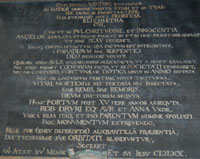
Epitaph of Elizabeth Drury
|
|
1610
|
The Alderman and other members of the corporation of St Edmundsbury acquired the assignment of Sir Robert Drury's lease as trustees for the Corporation. The price they paid him was £2,000. In return, Sir Robert gave the town charities £100 in stock to purchase firewood for the poor of Bury.
By this time the Toll House had been re-built following the fire and was converted into the Market House or Market Hall. Later it was called the Wool Hall and wool was sold here in great quantities up to the 19th century. Woolhall Street takes its name from the old Wool Hall.
The cloth trade was under pressure from competition from the new continental lightweight fabrics. At Bury the corporation allowed the clothiers to incorporate themselves into a society to try to regulate the trade and improve their lot. The meeting included many of the Stour Valley clothiers as well as those from Bury.
A Glemsford clothier attended the meeting in Bury St. Edmunds in 1610 when the clothiers, woollen weavers and tailors were incorporated into a Company framed after the model of a London Livery Company. Among other things, the Bury Corporation controlled the engagement of workers, journeymen and apprentices, and the payment of wages, Glemsford joined in this effort to regulate the Wool Trade in West Suffolk but the Corporation did not last long as the formation of these companies had an adverse effect upon the free trade in Wool.
Events quickly overtook them, as the Broadcloth the Bury and district weavers had produced with great success since medieval times was fast going out of fashion.
Within 20 years many wool merchants in Suffolk were made bankrupt, some had migrated to Holland and the wool industry was transferred to Yorkshire and the West Country.
The Feoffees opened a Poor House in Whiting Street, Bury St Edmunds.
Sir Robert Drury of Hawstead purchased the manor of Hardwick, or Hardwick Wood, from Thomas Stanton of Bury. Drury had probably financed the purchase by his sale of the market rights at Bury, mentioned above. He paid £1,100 for Hardwick, and thus began the association of the Drury family with Hardwick until 1656. Drury now proceeded to build the mansion, later to become known as Hardwick House. He would remove many of his treasures from his old estate at Hawstead Place, and install them in the new Hardwick House.
In 1610 tragedy struck the Drury family, as Robert's only surviving child, Elizabeth, died at the age of 14. The poet John Donne wrote her epitaph, which is on her tomb in Hawstead Church. John Donne had probably been known to Drury for some time, but it was this elegy which made them friends.
Sir Robert Drury now set off on a European tour to recover from this loss, and he took Donne with him as an interpreter. By December, Drury, his wife and John Donne arrived at Amiens, but Donne soon fell ill with worry over leaving his pregnant wife behind.
John Speed published "Suffolk Described" in 1610. It was basically a lavish re-working of Christopher Saxton's map of Suffolk, drawn in 1575.
On 23rd May, 1610, the relief ships launched in Bermuda finally reached James Fort in Virginia, but found only 60 people left alive of the colony which had been 500 strong. It was decided to leave the original island site of James Fort and return to England. However, having sailed a few miles down the James River, they met another supply fleet under Baron De La Ware in his ship Deliverance. The colonists decided to stay in Virginia once the new supplies arrived, and it seems to have been in 1610 that the present site of Jamestown was established.
|
|
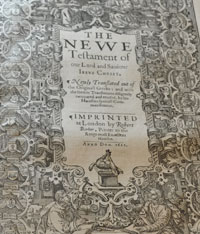
New Testament of King James Bible
|
|
1611
|
The King James, or Authorised, Version of the Bible was published, and is still printed today. It arose from the Hampton Court Conference of 1604, and was proposed by John Reynolds, a moderate Puritan. The existing Geneva Bible included criticism of monarchic rule in its annotations, and King James was keen to remove these. Fifty four translators were appointed to go back to the original Greek in order to correct and amend the Bishops' Bible, and produce a format for use in reading in church. The Geneva Bible would retain its popularity for another 40 years, before the King James Bible became fully accepted. This particular volume was given to the library of the Cathedral of St James in 1934.
Ipswich corporation put up, or 'adventured', £100 towards the cost of ships to sail to Jamestown, in Virginia to help the colonists get established.
Through the early part of the year Sir Robert Drury, his wife, and the poet, John Donne, were travelling in Europe. From Amiens they moved to Paris and on to Heidelberg and Frankfurt, via Aix. By September they returned to London from Spa via Brussels.
On the first anniversary of the death of little Elizabeth Drury, buried in Hawstead Church, the poet Dr John Donne wrote a memorial elegy to her for her father. This poem, called "An anatomy of the World - First Anniversary", is still read today. In particular it marks a change in Donne's outlook from the secular themes of his youth to the pious themes of his later years.
At around this time it seems that Sir Robert Drury decided to leave Hawstead Place and move to Hardwick House, perhaps to have a fresh start after his family loss. The dairy and park at Hawstead were let out on a three year term, and he founded a charity, which was worth £52 a year.
|
|
1612
|
The date of around 1612 is thought to mark the completion of the new Hardwick House by Sir Robert Drury. Like many such great houses, it seems to have incorporated features from an earlier building on the site. In this case it is believed to have been the medieval Abbey Lodge. Drury removed 68 painted panels from Hawstead to incorporate into a room later known as the Painted Closet. Possibly this was intended to be for a chapel in the house.
|
|
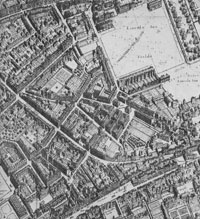
London showing Drury Lane
|
|
blank |
Drury's association with John Donne did not produce any employment for Donne. However, according to Cullum's book on Hawstead,
Sir Robert Drury was said to be so moved by Donne's elegy for his lost daughter, that he gave John Donne and his family rent free accomodation at Sir Robert's London house in Drury Lane. In Donne's biography by Derek Parker this tale is told somewhat differently. Parker says it was the friendship built up over the years that led to Sir Robert Drury renting him, very reasonably, a neat little brick house attached to his mansion in Drury Lane, with a private entrance to a paved court within the larger courtyard of Drury House itself. The Donne family moved in at the end of 1612 or early in 1613. Dr Donne was described as the tenant of "one bricke howse ...with a little passage and a smale court" within Drury House. Drury House was at the southern end of Drury Lane in what apparently became called Wych Street by 1700. This map shows Drury Lane by 1636. Donne would die in 1631.
Sir John Crofts came into Little Saxham Hall and its estate on the death of his father in 1612. He was 49 at the time and had lived in Bedfordshire for most of his married life. He had been knighted in Dublin in 1599, presumably for active service in Ireland. He would live at Little Saxham until his death in March 1628. He was to entertain King James I, members of his court and the aristocracy on a number of occasions during his 16 years at the Hall.
The colony had hung on at James Fort in Virginia through severe illness and deprivation for several years, but eventually the fort was abandoned and the survivors moved down river. As luck would have it they met a supply ship and re-established Jamestown down the river. John Smith became famous as the man saved from death by Pocahontas and the first viable English speaking American colony was therefore established here by Suffolk men 13 years before the Pilgrim fathers arrived in the Mayflower.
|
1613
|
As if to confirm his removal from Hawstead Place to Hardwick House, Sir Robert Drury obtained a license to have divine service read in his new house at Hardwick. Thomas Ridley, the Archbishop of Canterbury, granted the license to include his wife, his servants, and the widows from his newly founded almshouse. Hardwick appears to have now become an extra-parochial district.
By 1613, the king, James I, had established himself three favourite resorts for hunting. These were at Royston, Theobalds House, and at Newmarket. In Royston before 1603 much of the town was given over to inns catering for travellers mainly going between London and York.
When, on 29 April 1603 James VI of Scotland was travelling south to become King James I of England, he had paused overnight at Royston, in the residence of Robert Chester, established within the old Priory grounds. Attracted by the suitability of the area for hunting, James later hired the house for a year. In 1604 the king decided to create a hunting lodge in the town by demolishing the "Cock" and "Greyhound" Inns. The king's lodgings were completed in 1607, and were described in 1652 as "all of brick well-tiled double-built, in length 78 ft., breadth 43 ft., height from eaves to ground 24 ft., thickness of walls 24 inches." This was his first of three favourite hunting lodges.
Theobalds House was built between 1564 and 1585 by Lord Burghley the most senior councillor of Elizabeth I, the location desirable in that it lay just outside Cheshunt in Hertfordshire, just off the main road north from London to Ware.
In 1607 the house passed in ownership from Robert Cecil, who had inherited it from his father, to James I, who exchanged Theobalds House for the nearby Hatfield Palace. Theobalds House quickly became a favourite country seat of the King James I of England who would eventually die within its walls on March 27, 1625.
King James I had completed his third hunting lodge at Newmarket between 1607 and 1610, and made use of it on an annual basis. In court terms it was referred to as his Privy Lodgings, located on the site of the now demolished Griffin Inn, on Newmarket High Street.
Wherever the king went, so went much of his court. Until his untimely death in 1612, the Prince of Wales, Prince Henry Frederick, had visited Newmarket, and attracted a great following on "Newmarket's naked plains." In February, 1613, the king's second child, Elizabeth, married Frederick V, at the time the Elector of the Palatinate in Germany. (In 1619 Frederick would become King of Bohemia, and Elizabeth would be Queen of Bohemia.) Both the Elector and Elizabeth visited James I at Newmarket in 1613. Also present was the king's second son, Prince Charles, now the heir to the throne, and future Charles I.
It would appear that the King's new lodgings at Newmarket were poorly built, as in March, 1613, the King had to be rushed out of his bedroom, as the foundations began to subside alarmingly. This would result in its replacement by a second Privy Lodging, but this time Inigo Jones would be called upon to design it. The new Lodgings were built behind the old lodge between 1614 and 1621.
At Newmarket the first known horse race in the area took place in 1613, run between Linton and Newmarket. It is recorded by Symonds D'Ewes of Stowlangtoft, (later Sir Symonds D'Ewes), that George Villiers first appeared upon the Newmarket scene in 1613. Villiers appeared to be down on his luck at the time, as he was sharing a room at Linton, and wore only an old black suit. However, Villiers was to be instrumental in turning the King's interests towards racing horses, a pursuit which does not seem to have interested the King, or his court, before this time. George Villiers would soon become a "favourite" of James I, who rose him rapidly through the ranks of the nobility to become made Duke of Buckingham by 1623.
|
|
|
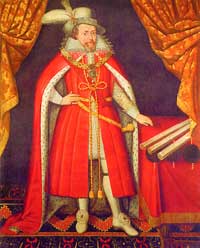
James I and three charters
|
|
1614
|
The town of Bury St Edmunds received a final Charter from James I which gave it the right to send 2 MPs to Parliament, and to hold a court of quarter sessions. The corporation were so pleased with their three charters that a painter called Fenn was commissioned to picture the king with a representation of the three documents, as shown here.
The latest writ also gave other new privileges to the town's council. The Court of Record was now extended from £50 a case to £200, and a Court Leet set up for dealing with items of good order such as weights and measures. There was also a new right to have a Coroner. Every retiring Alderman would be the Coroner for one year.
The Right to Send Two MPs to Parliament can be viewed in a translation made in 1810, by clicking where indicated.
The borough could already hold a Court of Pie Powder since the 1606 charter, from the French for "dusty feet", which regulated the business affairs of the market traders. The town could now have four ceremonial maces instead of two. For these rights the town paid a fee farm rent of £57-13s-4d. At last Bury had become a fully functioning self-governing borough with the powers it needed to run its own affairs. In gratitude to James I, they had his portrait painted and hung it in the Guildhall. The three charters are depicted laying on a table with the inscription, "Creavit, ditavit, amplificavit."
The two MP's were to be elected solely by the 37 members of the corporation, but for many years those chosen would be effectively the nominees of the Duke of Grafton and the Marquess of Bristol. In monastic days it was the abbot who represented the area in Parliament. In 1614 the first two MP's were Sir Thomas Jermyn and Robert Crane.
Any earlier benefactions given to the Alderman and Burgesses in monastic times were confirmed to the new Corporation. Therefore, the churches of St James and St Mary now also came under the corporation's wing. They claimed the same episcopal exemptions won by abbot Baldwin, so that the corporation could appoint the local clergy themselves. This right lasted up until 1842, when the corporation sold these rights. Previously, from 1539 until 1614, the right to appoint the clergy had been exercised by the Feoffees of the Town Lands. They had set up a library at St James Church, and this also passed to the Corporation in 1614.
The new court leet appointed constables for the two parishes of St James and St Mary's. These would be the only police force until 1836. This court also brought to task those who failed to carry out duties such as cleaning blocked water courses. Most substantial men of the parish were known as dezoners or deasners, and had to carry out such works near their properties.
The justices also controlled malting and brewing and all leather buckets needed to be approved and registered.
In 1614 the London dyers persuaded the government to ban all undyed exports of cloth. The country's clothiers, including those at Bury had depended upon this export trade and within six years the trade would collapse, and many were bankrupted as they held large stocks they could no longer sell. This hit the town badly, but probably hit the cottage industry in the countryside worse.
|
|
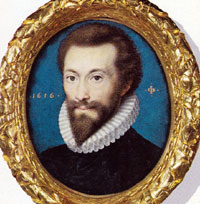
John Donne in 1616
|
|
1615
|
In February 1615 King James I was at Newmarket, where he was visited by John Donne, who was seeking patronage and employment. Donne had been ordained in January by the Bishop of London. The King appointed Donne to the post of Chaplain-in-Ordinary, which brought him two different benefices. On 7th March, Donne appeared at Cambridge accompanying the King, where Donne was given an honorary degree under the sponsorship of the King. Donne's reputation as an erotic poet at first made the University reluctant to honour him, but doubtless the King's influence was to prevail.
In the years from 1614 to 1620 the new Royal palace, or "Privy Lodgings" was being built at Newmarket. The architect Inigo Jones was engaged to design it, and several designs were drawn up. These buildings are today the site of Moon's Toy Shop. By 1615 the King also wanted an indoor tennis court, a brewery and stables added to the work. At this time these would not be racing stables, but would house hunting horses and carriage horses. James I also built a "Riding House", where equitation could be practised in the form of 'haute ecole'. This also required stabling for the equitation horses. The location of these stables is still unproven.
The king also had kennels built along what is now Station Approach, in the grounds of Tattersalls today, for his hunting dogs. Some would be kept for hare coursing, and others would be staghounds.
During these years Prince Charles, (future Charles I), commissioned his own lodgings on the High Street at Newmarket, on a site now occupied by Hughes Electrical store. These were connected by a Long Gallery to the King's new apartments behind the High Street.
Samuel Ward, a puritan preacher from Haverhill, had his first book of Sermons published in 1615. There is a school in Haverhill named after him.
|
|
1617
|
On April 29th, 1617, licence was granted to Mary Middlemore, maid of honour to the Queen, to search for treasure in the grounds of the Abbey at Bury St Edmunds, according to Rymer. There appears to be no record of what (if anything) was found.
At this time the abbey grounds seem to have been owned by Edward or Erasmus Cope.
|
|
1618
|
By 1618 Robert Reyce had finished his Breviary of Suffolk. This was published in 1902 as "Suffolk in the 17th Century", by Lord Francis Hervey. Unlike the Chorography, it did not attempt to list every town, village and hamlet in Suffolk. Instead it discussed a series of topics, such as rivers, the soil, the agricultural products, mansions, the classes of people, lords of the manor, former religious houses, monuments in churches, coats of arms, etc..
Reyce noted that hops were an expanding Suffolk crop at this time, some marshes were even drained to grow hops. Reyce was a Puritan himself, and he commended "the great number of religious, grave, reverend and learned ministers of God's holy word, which are planted in this shire."
The River Larke is again called The Burne, while the Kennet is called the The Dale.
"This Burne ariseth nott far from Burne Bradfeild......."
In his notes added to the 1902 publication, Lord Francis Hervey noted that: "The 'river of Dale' is now known as Lee Brook. 'Burne Bradfeild' is Bradfield Combust. The name has nothing to do with the name of the River Burn or Larke." Having stamped upon this idea of the origin of the river's name, Lord Francis does not attempt to say where the name of Burn originated.
|
|
1619
|
The Chamberlain of Bury at this time was one Edward Bourne. His accounts record income from "fines" for admission as a freeman of the town, allowing tradespeople to set up in the town. This was worth £1 a time. Other income was from enrolment of apprenticeship indentures and from fines levied in Quarter Sessions in the Court of Record. Payments included work on the Market Cross and 14/2 to workmen to repair the highways from St Peters into the Risbygate Street.
Another financial officer was the Receiver of Rents, issues and profits belonging to the Almoner's Barns. These old monastic rights passed to the Corporation under the terms of the 1608 charter. As well as rents, he collected tithe wool from Eldo Farm which was paid in kind. £76 came from fairs and markets which were farmed out at this time. The tithe corn was also farmed at a rent of £40. The receiver had to pay some church stipends, and also bought wood for the poor, and in 1619 had paid 5/- for repairs to the common well in Southgate Street.
|
|
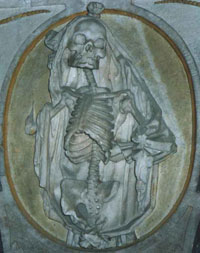
Laetitia Moseley Memorial
|
|
blank |
At Ousden, the death of Laetitia Moseley resulted in the erection of the usual memorial in the parish church, as befitted the wife of the owner of the Hall and most of Ousden and parts of surrounding parishes. Ousden had been owned by the Moseleys since 1567, and would continue to own the estate and Hall until 1800. The memorial depicts her skeleton, in a manor which modern eyes would find rather gruesome, together with a three verse rhyming epitaph.
|
|
1620
|
The Pilgrim Fathers landed in America on the Mayflower. Her Captain, Christopher Jones, was a Harwich man, and the Mayflower herself was out of Harwich. She may have been built in one of the Ipswich shipyards. However, other Suffolk men had already established James Fort in 1607 and relocated to Jamestown in Virginia in 1610.
By 1620, Haverhill had become well known as a Puritan town. It produced many leading Puritan preachers such as the Ward family (John, his sons Samuel and Nathaniel and his grandson John), the Faircloughs and the Scanderets.
In Bury the corporation erected a new Town Cross, with a Woolhall upstairs. See 1608 as well.
Sir John Crofts came to Little Saxham on the death of his father in 1612.
Sir John Crofts enjoyed several visits from James I, the recorded ones being in February 1620, December 1621 and February 1622. The King's wife had died in 1619.
The first of these visits is recorded in a letter from John Chamberlain to Sir Dudley Carleton and says, "(The King) passes the time merrily at Newmarket, and the running masque reigns all over the country where there be fit subjects to entertain it; as lately they have been at Sir John Crofts' near Bury."
Sir John's third son, also called John, was born in 1598. He wrote a poem entitled, 'To the King, at his entrance to Saxham'. If this was written while he was a boy, this would indicate that the King probably came to Little Saxham before these three recorded visits.
|
|
1621
|
Elections were held for the new Parliament due to meet in Westminster on 16th January. St Thomas Jermyn, Kt and John Woodford, Esq were elected Burgesses to represent the town of Bury by the 37 members of the corporation eligible to vote. Bury had only been a Parliamentary Borough since the 1614 Charter, and this was their second election. Woodford replaced Robert Crane.
The River Lark was at this time a mixture of gravelly shallows and easy fords, with reasonable depths of water in other places. Small boats and vessels could reach as far as Mildenhall from the sea at Kings Lynn, but it was too difficult to reach any further with the same boat.
If the river could be modified, or deepened in some way, then more goods could reach Bury St Edmunds without needing to leave the water. The use of single gates or staunches to hold back water in a section of river, had been known for hundreds of years.
The first known attempt to seriously improve the River Lark for navigation since Roman times took place in 1621. Plans were prepared by a John Gason of Finchley, and authorisation was sought by way of an Act of Parliament. Gason also tried to be appointed the undertaker for several other rivers, including the Lark, but this bill was rejected by Parliament.
In December, 1621, King James I was, once again, entertained at Little Saxham Hall. A letter written in December 1621 says that
"the King has been entertained with a masque by Sir John Crofts and his daughters, and they visited him at Newmarket".
While the king was at Newmarket in December he received a delegation of MPs from Parliament protesting against the general conduct of government. In the background there was the issue of royal patents and monopolies being used as a means of raising income for the crown instead of through taxation raised via parliamentary procedures. There was also the possibility that Prince Charles would marry the Catholic Spanish Infanta, Maria. By this time there was an upsurge in anti-catholic sentiment. Parliament had framed a petition asking not only for a war with Spain but for Prince Charles to marry a Protestant, and for enforcement of the anti-Catholic laws. James told them not to interfere in matters of royal prerogative or they would risk punishment. Parliament responded by issuing a statement protesting their rights, including freedom of speech. This was the petition delivered to the king at Newmarket.
Urged on by George Villiers, now the Earl of Buckingham and the Spanish ambassador Gondomar, James returned to London and ripped the protest out of the record book and dissolved Parliament on 6th January, 1622.
|
|
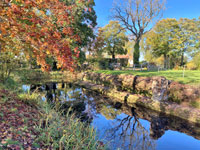
Site of Little Saxham Hall
|
|
1622
|
Two months after his last recorded visit to Newmarket and to Little Saxham, in February 1622 the same letter writer recorded that: "(The King) is to go a-shroving to Sir John Crofts. That Lady (Crofts) and her daughter Cecilia have been much at Newmarket of late". This comment, with its hidden meaning, was echoed around the country.
The following month the King himself was reported as saying that he was the king of the most lying nation in the world, for they had reported that he was now married to Sir John Crofts' daughter. There were rumours of an affair between him and Cecilia, though he was 56 in 1622 and she was only in her early twenties. Cecilia was 'a very gay young lady, prominent in the masquerades'.
King James I paid many visits to Sir John Crofts home at Little Saxham Hall. The remains of the house walls and its moat are shown here in this picture by Bob Jones. The house in the distance is today called Crofts Place, and is believed to have been originally built as stabling for the Hall in the 1570s.
King James I had maintained a royal presence at Newmarket since 1605, where he kept a palace and indulged in hare coursing and other sports. He does not seem to have moved to Newmarket for any existing connection to horse racing, as the first recorded incidence of a horse race at Newmarket occurred in 1613. This had been run across open country from Linton to Newmarket.
On 8th March, 1622 another race at Newmarket involved a horse, called "Prince", owned by the Duke of Buckingham and one owned by Lord Salisbury, and was run for a wager of £100. The first proper course would not be laid out until the reign of Charles I. By 1627 there would be regular Spring and Autumn horse races established there.
The harvest was very poor in 1622, and this seemed to usher in a decade of scarcity. The Feoffees had to buy corn at high prices to make into bread for the poor. The corporation tried to ban the malting of barley for beer in order to get grain onto the market for bread, but this only made the supply of grain dry up. They quickly had to abandon this idea.
Not only was food scarce and costly, but many had lost their livelihoods. By 1622 the old cloth trade was ruined. Broadcloth was out of fashion. Lighter and more colourful new draperies were in demand. The new draperies were lighter, and were being being produced by foreign weavers, many of whom had set up in Norwich and Colchester. Broad cloth was out of style, and Norwich stuff was in. Bury's clothiers had large stocks of cloth they could not sell, and were described as "much decayed in their estates by reason of the great losses they had received."
J.P.s in the Babergh Hundred also corresponded with the Privy Council in the 1620s and repeatedly spoke of the "decay of clothing", and the "great distress thereby falling upon the weavers, spinners and fullers... for want of work." Cloth had been produced, but nobody was buying it. Some 4,453 cloths worth over £39,000 remained unsold throughout 20 Suffolk towns and villages in 1622. Bankruptcies were frequent, which only added to the spread of poverty, as suppliers and workers went unpaid.
By an Order made in October, 1622, the Bury Corporation considered that it was "earnestly desired that provision may be made to set the poor of this town on work as well for the preventing of idleness as of a means to set them on work". They resolved that "the trade of making and weaving of stuffs shall be laboured to be brought to this town". They hoped to persuade Flemings, Frenchmen and Dutchman to bring their more modern weaving skills from Norwich to set up in Bury.
Towns previously famous for their cloth like Bury, Lavenham and East Bergholt were reduced to spinning yarn to send to Norwich or to Essex. Hence the cry for new weaving skills at Bury.
Horace Barker has recorded that in this year the almshouses in old St Peter's Hospital in Bury were changed into a House of Correction to deal with the upsurge of troublesome paupers.
However at Haverhill, Sudbury and Glemsford the local people adapted and took up weaving the new fabrics and thus gained back some of the lost prosperity.
The established producers of the New Draperies now retaliated by objecting to the old cloth makers who tried to convert their production. A petition of 1622 was presented by "the makers of bays and says, stuffs and fustians, commonly called the New Draperies, within the counties of Essex, Suffolk and Norfolk, to the Privy Council for redress against intruders in the said trade." Clearly there was not enough demand to go round, even for the new draperies.
In October 1622, Thomas Warner, a captain in James I's bodyguard, sailed from Kytson Point near Woodbridge, for St Christopher, now called St Kitts. He intended to grow tobacco, and came from Parham in Suffolk. The first crop was destroyed by a hurricane and they left. Next year the French had arrived. Warner became governor of St Kitts in 1627 but the island was sacked by the Spanish in 1629. Warner joined the naval fight against Spain and eventually the area was regained. He died on St Kitts in 1649.
|
|
1623
|
Things were desperate in many parts of the country, and Bury was no exception. It is thought that a workhouse had existed in the town before 1621, located in a house in Whiting Street. In 1623 a house in Churchgate Street was adapted to take over the role of workhouse.
Along with the new workhouse, St Peter's Hospital in Out Risbygate had just been refitted as a house of correction. The massive growth in poverty and near starvation was met by a growth in workhouse and correctional places.
A notable Puritan in the Haverhill area was Sir Nathaniel Barnardiston, who had the gift of three Suffolk livings. In 1623 he appointed Samuel Fairclough as Rector of Barnadiston. Fairclough was a famous puritan preacher, "mighty in the scriptures". Kedington Hall was the home of Sir Nathaniel and his servants were selected for their piety and sincerity. The house was run like a continuous prayer meeting, with psalms and prayers at every meal.
|
|
1624
|
One of the privileges chartered boroughs sought to acquire was the right to appoint their own coroner. Bury had acquired this right in 1614, and appointed a coroner annually, usually in the form of the outgoing Alderman. In 1624 an inquest was held on the body of Robert English, described as a 67 year old "chirurgeon", or surgeon, who died after being kicked by a horse. Unusually for the time the inquest record was written in English.
Bury St Edmunds Borough Council continued to pay witnesses expenses at the town coroner's court up to 1974.
War began with Spain and continued until 1630.
Robert Audley of Great Barton died in 1624. He is thought to have built the first Great Barton Hall in late Elizabethan or early Jacobean times. Like most other great houses, it would be much modified in the 18th and 19th centuries.
Sir John Crofts eldest son was Sir Henry Crofts. He had been knighted at Whitehall in 1611, at the age of 21. He had married Elizabeth a year earlier, in 1610. In 1624 he became the MP for Eye. Sir John Crofts lived at Little Saxham Hall until his death in 1628. The Crofts family had entertained King James I at Saxham on several occasions, often visited him at Newmarket, and retained royal connections into the next century.
Newmarket continued to attract a succession of wealthy visitors attending the king as well as pursuing their own hare coursing, hawking and deer hunts in the surrounding countryside. Sir Robert Shirley was one flamboyant character who was seen in Newmarket wearing a turban and arabic robes, the garb of his late post as Ambassador to the Shah of Persia.
|
|
1625
|
After a series of illnesses, James I finally died at Theobalds House in Hertfordshire on 27 March, 1625 during a violent attack of dysentery, with the Duke of Buckingham at his bedside. James had been accused of neglecting the business of government for leisure pastimes, such as the hunt, carried on at his palaces at Theobalds, Royston and Newmarket. His later dependence on male favourites, such as George Villiers at a scandal-ridden court also undermined the image of the monarchy. Much of the scandal revolved around Newmarket and its surrounds. However, James I died enjoying the affection of most of his subjects, who had enjoyed having long years of peace and low taxation during his reign.
James I's son, now King Charles I, came to the throne and would reign until 1649. George Villiers would continue to cultivate and influence Charles I, as he had for his father. Charles would continue to enjoy the sport of Newmarket, and to develop the horse racing side of that town's activities.
|
|
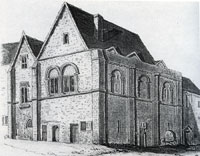
Moyse's Hall bought by Feoffees
|
|
1626
|
War began with France and continued until 1629.
In 1626 the Bury St Edmunds Guildhall Feoffees, looking for economy and efficiency, acquired Moyse's Hall. Moyses Hall was conveyed to the Feoffees by deed, dated 27th January, 1626, according to the Borough list of charities in the council yearbook for 1896/97. The sellers were described as "Collins and his daughters." The Feoffees aim was to integrate their Poorhouse, previously located in Whiting Street, and moved to Churchgate Street in 1622, with the House of Correction and a Jail. Moyse's Hall and adjacent buildings now performed all these functions on one site.
So, from 1626, Moyse's Hall was used as the Bridewell by the the Borough Magistrates. It would later become the Police Station, and so was a lock-up, of one sort or another, until 1892.
In later years, presumably as the number of inmates grew, the workhouse for St James parish was set up in Eastgate Street, and for St Mary's parish in Schoolhall Street.
The old town jail on the Cornhill, at the top of Abbeygate Street, continued to be used as the County Jail for the Liberty, or what would become West Suffolk. This jail dated back to Abbot Anselm's time, and conditions for its inmates were very poor.
In 1626 the Governors of the Bury Grammar School bought premises between the Norman Tower and St Mary's Church for use as a Poor Boys School. By 1630, the Haberden Estate was acquired as an endowment for this new school.
|
|
1627
|
King Charles I started to try and increase the amount of money paid for Catholic recusancy. He brought in a new system to replace monthly fines, but payments were steep. In 1627 he took £103 in such fines from Suffolk, but by 1634 this had risen to £728. As this could only be paid by the wealthy, it helps to explain why Suffolk Catholics did not rush to the king's side in the Civil War.
In addition the King levied a "forced loan" on the country without Parliamentary support. In Suffolk, several men were imprisoned for refusing to comply. Among them was Sir Nathaniel Barnardiston, who was, as well as a Puritan, a strong defender of the rights and privileges of Parliament. He was a Suffolk MP from Kedington.
However, under Charles I, high church practices would increasingly be introduced into the English church.
|
|
1628
|
Sir Edward Coke introduced his bill of liberties in the House of Commons, referring to "Magna Carta is such a fellow, that he will have no sovereign." The bill led to the Petition of Rights.
Sir Thomas Jermyn was again returned to Parliament as one of Bury's two MP's.
Sir William Hervey was now elected as the second MP for Bury. The Herveys had been squires of Ickworth since the 15th Century but from 1628 the family would continue in Parliament and public life until 1906.
|
|
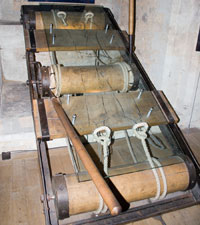
Rack outlawed for confessions
|
|
blank |
John Felton, a member of a well respected Suffolk family, was implicated in the murder of the Duke of Buckingham. Sir Thomas Richardson was the Recorder of Bury St Edmunds, in the 1620s, and a distinguished lawyer and Judge. He had been made Speaker of the House of Commons in 1621, and in 1628, he made legal history by refusing to allow John Felton to be tortured on the Rack in order to extract evidence from him. Sir Thomas Richardson was the first judge ever to rule that evidence obtained under torture was unsafe and inadmissible in law.
Lady Kytson of Hengrave died in 1628 and the manor of Chevington passed to her daughter, Mary Countess of Rivers.
Sir John Crofts had lived at Little Saxham Hall from 1612 until his death in March 1628. He had often entertained King James I at Saxham. His oldest son was Sir Henry Crofts, who now inherited the Hall and its lands. Like his father before him, Sir Henry was closely associated with the royal court. His own son, William Crofts, was born in 1611, and he would go on to fight for the King during the Civil War, and to be closely associated with Charles II after the restoration of the monarchy.
|
|
1629
|
Charles I dissolved Parliament and determined to govern without it for the next eleven years. This period is called The Personal Rule of Charles I. Charles had been king for only four years and at first he managed well enough without Parliament. However,in one regard he was stirring up resentments. He sponsored William Laud's high church teachings against the current mainstream of Anglican sensibilities.
|
|
1630
|
The Corporation at Bury conveyed all their property, including the markets, fairs and tolls, to 40 trustees. The reasons for this seem to be unclear, and there is suggestion that they feared the charter was about to be withdrawn. Bury corporation were strong supporters of Parliament, and the King had taken many personal decisions against those who resisted his arbitrary rule. This matter of the ownership of the corporate property became an issue in the 1660's.
In 1630 King Charles I spent three weeks in Newmarket, accompanied by the whole court. The King became famous for the lavishness of his feasts and entertainments. Charles I would spend large sums of money on royal buildings at Newmarket, not just for lodgings, but to hold audiences and to house his royal stable and his dogs. Rubens at this time was an Ambassador from Spain. Charles I knighted him at Newmarket, showing that state business continued at Newmarket while he was there.
The 1630s were a period of continuing religious tension. There was a division between the renewal of high church practices and a continued development of puritan ideas, which rejected elaborate, organised and hierarchical forms of religion.
Sir Nathaniel Barnardiston appointed Samuel Fairclough, his fiery puritan Rector of Barnardiston, to the living at Kedington, as Rector. The influence of such men made the Haverhill area a stronghold of Puritan values.
Nationally, as well as locally, large scale emigration to Massachusetts now began. The Massachusetts Bay Colony was much further north than the Jamestown Colony in Virginia, and was located on the site of modern day Boston, Massachusetts.
In 1628 a group of Puritan investors had set up the "The New England Company for a Plantation in Massachusetts Bay" to help people emigrate to the New World, seeking religious freedom. One influential member of this Company was John Winthrop, Lord of the Manor of Groton and Edwardstone near Hadleigh. He was a lawyer and left many letters and diaries.
The colonies in the New World were all set up by private companies operating under Royal Charters, and each colony had a Governor appointed by the sponsoring company shareholders. John Winthrop was appointed the third Governor of the Massachusetts Bay Colony in 1629, while still in England.
In East Anglia, pre-reformation church practices were returning in most areas and influential puritans like Winthrop could not accept this. In addition there was a depression in the area, and in April, 1630, 112 men, women and children left Suffolk for America, including John Winthrop. They travelled to Southampton to join the Arbella, one of a number of ships in the fleet. Some 700 colonists began landing at Salem in June, 1630. This venture is known today as the Winthrop Fleet, made up of eleven ships sailing from Plymouth, sixty or seventy to a ship on a three week crossing. When they landed in 1630 John Winthrop duly took over as Governor from John Endecott.
Colonists aimed to arrive early in the year to sow crops and they often took livestock with them. Applicants were selected for their trade or skills such as wheelwright or blacksmith, and family groups usually made up the basic unit.
Thirty Suffolk village names can be traced in the USA, including Haverhill, Clare, Ipswich, Boxford and Groton.
|
|
1631
|
The harvest failed again in 1631 in West Suffolk. There seemed to be plenty of grain in Norfolk and so the Bury corporation sent a team there to buy enough to sell to the poor at reasonable prices. For thirty weeks this effort continued, with 40 people involved in the project. In the end the costs were all met by voluntary giving by local worthies.
At this time there is evidence that the Woolpack inn stood next to the Woolhall in Bury. The Woolpack would eventually become Everards Hotel, and the Woolhall was standing where Woolhall Street now runs.
In 1631 there was probably just a narrow passage called the Woolpack Passage which allowed people to walk through from the Cornhill to Field Lane. By the time of Warren's maps in the 1740's there is no evidence of any access way here. The Woolpack was a Carrier's House for much of its life, and was conveniently located for wool and woollen products to be carted to and from the wool market in the Woolhall.
John Winthrop's wife and three children followed him, along with many others from Suffolk, Norfolk and Essex out to Massachusetts Bay, part of the 10,000 colonists who would make the trip over the next ten years.
|
|
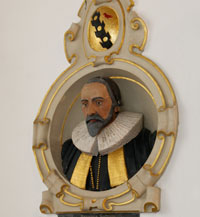
John Eldred monument
|
|
1632
|
In 1632 John Eldred died at Nutmeg Hall in Great Saxham. He had bought the manor and advowson of Great Saxham in 1597 following a spectacular voyage to the Middle East from 1583 to 1588, from which he returned a vastly rich man from trading in spices such as cinnamon and nutmeg. As well as fortune, he had fame, even Shakespeare's three witches alluded to the voyage in the Tiger to Aleppo in his play, Macbeth.
His son erected an impressive monument to him in Great Saxham church, as well as an impressive brass in the floor, both of which can still be seen.
According to the anonymous Brief History of St Peter's Church at Fakenham Magna, the church has one bell dated 1500, a second from 1572 and another from 1667. According to Clouston and Pipe, (Bells and Bellringing in Suffolk), the last bells to be made in Bury had been dated from 1632, and were made by Thomas Cheese. However, the church at Fakenham Magna contains a bell cast by Robert Gurney of Bury St Edmunds in 1667.
|
|
1633
|
In America Agawam remained an uncolonized part of the Massachusetts Bay Colony until 1633 when Governor John Winthrop sent his son, John, to establish a settlement to be called Ipswich. With twelve others, John sailed up the Ipswich River in March and began his settlement on the banks of the river. Some earlier explorations must have informed the new settlers that the banks of this tidal river would provide an ideal place for a new community to be established. Here they would enjoy the advantages of fresh water, water power, good fishing, and an easy means of transportation.
It was an strange group of settlers who came to Ipswich - men of substance and education, who were among the key founders of the Puritan Commonwealth: Thomas Dudley, Deputy Governor; Magistrates Simon Bradstreet, Richard Saltonstall, and Samuel Symonds; and Ministers Nathaniel Ward, John Norton, William Hubbard, and Nathaniel Rogers. Nathaniel Ward was a preacher from Haverhill in Suffolk, a brother of Samuel Ward, at this time the Town Preacher at Ipswich in Suffolk.
From 1611 to 1633 George Abbott had been Archbishop of Canterbury, a man of puritan sympathies. During his reign men like Samuel Ward, Town Preacher of Ipswich, had largely got away with preaching puritanism, offending the Spanish ambassador, attacking the Duke of Buckingham and opposing church ceremonies. This attitude would change in late 1633.
The newly appointed Archbishop of Canterbury was William Laud, a man who tried to impose "high-church" rituals and discipline upon the clergy. With such a strong puritan feeling in the Country, this was a great mistake, but he was supported by the King.
In reality he was probably more against the rising puritan practices than pro-catholic, but a new harder line was being drawn.
At Hengrave Hall, Sir John Gage died, having been the second husband of Lady Penelope Rivers, who would inherit Hengrave from her mother, Mary, the Countess of Rivers, in 1643. Mary was the daughter of Sir Thomas Kytson II and Lady Kytson. Hengrave would be associated with the Gage family now for another nine generations. Although Penelope eventually married her third husband, Sir William Hervey of Ickworth, she settled Hengrave on her third son, Edward Gage.
|
|
1634
|
Samual Ward, the puritan town lecturer of Ipswich for 30 years past was hauled before the Court of High Commission for praying informally and criticising Church hierarchy. Samual Ward was also accused of inciting emigration to New England.
Jeremiah Holt was the Rector of Stonham Aspal, and he had collected some old books and manuscripts from monastic days at Bury. According to M R James "On the Abbey of St Edmund at Bury", he gave his collection of Bury manuscripts to St John's College, at Cambridge.
The first Gold Cup horse race event was held in 1634 at Newmarket, after the town had been host to regular race meetings for just over a decade. The first race "course" as we would understand it, was laid out under Charles I, and was eight miles long. It was later referred to as the Long Course, and ran from the Fleam Dyke at Six Mile Bottom to the Bury St Edmunds side of Newmarket. The first circular course did not come into being until about 1665, under King Charles II.
|
|
1635
|
The first public postal service was established in Britain at the end of July 1635. Postage rates varied according to distance and ranged between twopence and eightpence.
The Earl of Suffolk, Lord Lieutenant of the County, instructed the Alderman, Recorder and Deputy Lieutenants of the Borough to prepare a muster roll of all able-bodied untrained men from 16 to 60 years of age. Bury's total was 1,335 men made up of North Ward - 193 men, South Ward - 277, East Ward - 116, West Ward - 426 and High Ward - 323.
Charles I invented a new tax called Ship Money, causing great resentment among the articulate and better off sections of society. There were several issues. Firstly the tax had no parliamentary support, as the King had decided to rule without it. Secondly the inland towns had never before had to pay for the navy. Resentment would continue as it was levied annually.
A new Bishop of Norwich was appointed, called Matthew Wren, a supporter of Laud's high church ideas. He cracked down on East Anglian puritanism.
Samuel Ward was censured in the Court of High Commission in November 1635. He was suspended from his job, and then imprisoned. Ipswich refused to replace him as they wanted Ward for Town Preacher, "or nobody".
One Robert Davers, later to become Sir Robert Davers of Rushbrooke, sailed to Barbados to plant sugar. He was one of 78 aboard the Falcon of London, and was 14 years old, almost certainly of humble status.
The attractive profits to be made by reducing the cost of transporting goods across country continued to make river improvement an attractive idea. In 1635 the entrepreneur Henry Lambe managed to obtain an Order in Council which gave him permission to carry out whatever work was needed to make the river navigable from Mildenhall to Bury St Edmunds.
However, all along the river there were watermills which depended upon a free flow of water for there existence. In some cases they were situated on mill streams flowing into the river, but in some cases they sat upon the river itself. Although these could all be avoided by digging new cuts around the mills, some millers feared the worst.
After proceeding only one mile, the landowners Sir Roger North and Thomas Steward, lodged objections, as a miller claimed that the contractors had damaged his mill. They managed to get the work stopped.
|
|
1636
|
The new Bishop of Norwich, Matthew Wren, stayed at Ipswich in 1636 and suspended some of the Suffolk clergy for refusing to accept certain new high church disciplines. Puritan local lecturers like Edmund Calamy at Bury, and Samuel Ward at Ipswich were excommunicated. The Puritan response was that Bishop Wren of Norwich was accused of driving out the god-fearing by his "popish idolatry." There were riots in the streets of Ipswich over it.
For ten years Edmund Calamy had been preaching to a packed church of St Mary's in Bury. In 1633 the government had felt obliged to issue lists of games, called the "Book of Sports", which could be played on Sundays without necessarily profaning the Sabbath, which included Morris Dancing and May games. Calamy had refused to read out this list in church as he disagreed with it. Puritans thought that the whole of Sunday should be for worship, and that no sport whatsoever should be played on a Sunday. After being sacked from the church he moved to London and would edit the "Soldier's Pocket Bible", a Puritan best seller during the Civil War.
Bishop Wren really put the cat among the pigeons when he insisted that the Communion Tables should be moved to a railed off part of the church at the east end, thus reinstating the Catholic Altar. Communicants had to kneel at the altar rail instead of receiving communion in their seats as had been the way since the Elizabethan Reformation.
|
|
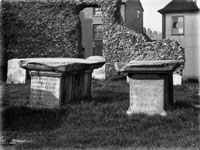
Bourne family graves
|
|
1637
|
Bury's population was about 6,000 at this time, its numbers swollen by out of work country weavers looking for jobs.
The seventh outbreak of the plague since the dissolution occurred in May of this year. It lasted until Christmas and 1637 was Bury's worst ever plague year, but thankfully this seems to have been the last of the plagues to hit the town. The Alderman, Edward Bourne, seems to have died himself within a few weeks of taking up office. These tombstones dating from the early 1600s, belonging to the Bourne family are the oldest remaining in the Great Churchyard of the Abbey. This picture is from the Spanton Jarman collection, probably taken in the early 20th century. By 2011 the inscriptions are much less clear than shown here.
The Bury St Edmunds Assizes were temporarily moved to Ipswich to avoid the outbreak of plague at Bury.
As usual the Guildhall Feoffees provided tents so that people could camp out of town in the hope of avoiding infection. This plague cost the Feoffees over £2,000. Over 600 people died, or about 10% of Bury's population. Some 439 were cured and 117 suffered nothing more than a serious rash. Some 103 families had been isolated in their own homes, and some of these seem to have been boarded up by the authorities, to keep them isolated.
Those who died on the Risby side of town were said to be buried at St Peter's Hospital, in the St Peter's Pit, in a communal grave. Temporary huts were also set up there, as the Grammar School Governors recorded in 1641/2 that these were burned down for public health reasons in that year. The school owned the hospital site at this time, and were paid some compensation for the disruption of having their premises taken over for the duration of the plague.
The first written usage of the name Guildhall Feoffees occurred in 1637, but it may well be that this name had been in popular use before this.
Lambe's attempt to canalise the River Lark was stalled by litigation.
Following a direct appeal to King Charles I, the King summoned all parties to explain why they were holding up this important work. He granted Henry Lambe a license to proceed, for an annual fee of £6.13.4. In return Lambe could charge a toll along the river from Bury to Mildenhall.
Unfortunately no further record of these improvements appears to be known about at present, and it may well be that the Civil War finished Lambe's hopes of proceeding.
It would be another 60 years before the Lark got its navigation work started again.
King Charles I was at the height of his power at this time, but he blundered into civil war in Scotland. The Scots did not take kindly to rule from London when sweeping change was introduced. An invasion was planned for 1639.
|
|
1638
|
By 1638 some 6-800 people from Suffolk and 1200 from Norfolk and Essex had sailed to Virginia despite government attempts to keep them at home. These new plantations were very largely successful, "beyond the hopes of their friends, and to the astonishment of their enemies." Religious zeal and a desire for freedom of worship characterised some of the emigrants.
Many of these migrants came from Ipswich, Sudbury, Haverhill and Wrentham, all puritan strongholds in Suffolk.
Some in power blamed the collapse of the clothing industry for this emigration and in 1638 a Royal Commission was appointed to inquire into the state of the clothing industry. They were to recommend ways to improve its fortunes. They proposed local bodies to be responsible for the control of its manufacturing in 62 towns in the country. These included Ipswich, Hadleigh, St Edmundsbury, Sudbury, Barford, Groton and Nayland, but not Lavenham. However, it was too late to save many livelihoods already lost, and the imminent approach of civil war meant that little was achieved.
The high churchman, Bishop Wren of Norwich, lost his bishopric in 1638. He had been Bishop of Norwich only since 1635, but had stirred up a hornets nest in Suffolk and Norfolk by his high church reforms. In 1642 he was impeached by the Puritan parliament for his high church ways. When accused of driving good puritans to emigrate, Bishop Wren himself blamed emigration on the low wages caused by the depression in the cloth industry in those areas.
Many people consider that the Puritan movement was greatly strengthened by public distaste for the reforms of Archbishop Laud. Bishop Wren himself had turned Norfolk and Suffolk into puritan strongholds. As a popular movement in Suffolk, Puritanism had many more active supporters in 1640 than it had in 1630.
|
|
1639
|
The new war against Scotland was very unpopular. The soldiers mutinied at Bungay and there was a transport strike in Ipswich. Charles I's plan to invade Scotland had to be abandoned. The Scots would soon retaliate.
Francis Pynner left money to the Feoffees to pipe water into the Market Place in Bury to provide a cistern of water to be used in case of fire. Pynner himself had lost all he owned in 1608 when the great fire of Bury swept through the town.
|
|
1640
|
In Suffolk, only £200 of the ship money assessment for the County of £8000, was paid. Rich men like Puritan Sir Nathanial Barnadiston were among those who refused to pay up on moral or religious grounds. Several migrations had taken place from Haverhill, and the town of Haverhill in Massachusetts was founded in 1640, originally with the name Pentucket.
The Scots now invaded northern England. The king urgently needed money to fight them, so Parliament was recalled in April 1640. Because the King had refused to call it for so long, there was a backlash against him. Strong parliamentarian candidates were returned, such as Sir Nathaniel Barnardiston of Kedington and Sir Simonds d'Ewes of Stowlangtoft. This became called the Short Parliament when Charles dissolved it in May, after only a few weeks when he refused their terms to finance the Scottish war. Once the invading Scots had taken Newcastle in the Autumn, the King had no option but to recall Parliament again. After the long Parliament had started in November, 1640, its puritan majority began to change the face of national religion. Parliament was now on a collision course with the King.
|
|
1641
|
In April 1641 King Charles I created Elizabeth Savage Countess Rivers in her own right, with an annual pension of £20. As a female life peer, this was a very rare honour, and was most likely an attempt to protect her from the anti-Catholic moves of the House of Commons during 1641. Born a Darcy, Lady Elizabeth had inherited Hengrave Hall, although she lived in Colchester. Along with Hengrave, she had substantial property at St Osyth, Long Melford, and elsewhere in the country.
In June, a Bill was introduced by the Long Parliament for the abolition of episcopacy. In practice, the Bishops were to be abolished. Nineteen counties sent in petitions to support the bill, one of which was Suffolk. Puritans blamed the bishops, particularly Archbishop of Canterbury Laud, and the deposed Bishop Wren of Norwich, for the re-introduction of catholic practices into church services since the 1630's. One of the Bill's strongest supporters was Sir Simonds D'Ewes of Stowlangtoft. He ran a puritan household much like Sir Nathaniel Barnardiston, and had been elected MP for Sudbury.
|
|
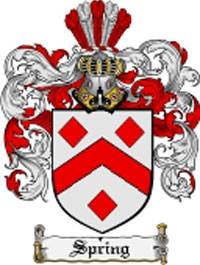
Arms of Sir William Spring, bart |
|
blank |
On 11 August 1641, Sir William Spring was created Baronet of Pakenham in the County of Suffolk, by King Charles I, in an attempt by the king to buy over parliamentarian gentry families in the lead up to the Civil War. Spring was the High Sheriff of Suffolk and later served as MP for Bury St Edmunds and Suffolk. This attempt to win the loyalty of Spring failed as he would become an active recruiter for the Parliamentarian army during the coming war.
All superstitious pictures and inscriptions in churches were ordered to be removed and defaced in 1641. There was another ordinance to this effect in 1643, but Suffolk did not necessarily suffer from this until 1644, following the appointment of William Dowsing. However, it does appear that in many places the local congregations supported Parliament's Puritan line, and where the local hierarchy were of a similar mind, the people themselves willingly carried out the Parliament's will.
In Ireland, 3000 Ulster Protestants were massacred by Catholics who had been disposessed by James I's Ulster Plantations Policy.
At some point before the war the corporation at Bury St Edmunds began to fear that their own parliamentary leanings may cause the crown to seize their assets. They seem to have devised a plan to vest the corporate assets in the Guildhall Feoffees to place them safe from the king.
|
|
1642
|
In January 1642 the House of Commons issued orders to disarm Royalists. Sir William Castleton, (the High Sheriff of Suffolk), Sir William Spring, and Maurice Barrow, esq., were ordered to search the Suffolk house of Lady Rivers, seize any arms they found, and put the arms into safe custody. This order referred to Melford Hall. Elizabeth Savage, who owned it, along with other property at St Osyth and on Tower Hill, had been made Countess Rivers by the King in the previous year.
Later in January, on the 25th, Hengrave Hall was also searched by the same gentlemen, and large quantities of arms removed by their 30 attendants. Hengrave was the home of Lady Penelope Gage, the sister of Elizabeth Savage, although the property belonged to Countess Rivers. Lady Penelope protested that the arms and armour had been in Catholic hands for 100 years, "and never yet hurt a finger of anybody", but to no avail. The Gages were prominent Catholics, and Lady Penelope wrote to Countess Rivers of being "daily threatened by the common sort of people".
Even before the war began, Bury St Edmunds was one of only 22 places in England to raise volunteers for the Parliament. Men like Thomas Chaplin, Bury Alderman and a linen draper would become active in the County Committee, as would Thomas Gibbs, a Bury Alderman, and Samuel Moody, another Bury Alderman and a cloth merchant. Such men would have recruited these volunteers.
In March, 1642, King Charles I was at Newmarket with his son, Prince Charles, (later Charles II). As usual, they were there with others of the court, to pursue sporting interests. While the royal party was at Newmarket, Parliament demanded that his father, the king, gave up the control of the army. Many of his private supporters had already been disarmed, and if the king agreed to this then his power would be at an end. He had no intention of complying. The young prince was only 12 years old, but he was already an expert horseman, a skill he would develop throughout his life. However, because of the events which followed, he would be unable to return to Newmarket for the next 24 years, until March 1666.
|
|
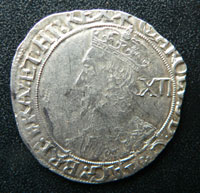
Charles I shilling |
|
blank |
On 10th August 1642, Parliament seized control of the main Mint in the Tower of London, hoping to cut off the flow of money to the King. At this time they had no intention of replacing the King, and so coins continued to be issued with the King's face at the Tower.
On August 22nd, 1642, the English Civil War officially began when the King raised his standard at Nottingham. This phase is also called the First civil War, and would last from 1642 to 1646. Charles I was so unpopular because of ship money, and other arbitrary taxes, that Suffolk gentry in general supported Parliament. When it came to fighting, most of the gentry in Suffolk seem to have done their best to remain neutral, but undoubtedly the activists in Suffolk were a mixture of the puritans and parliamentarians. Ipswich, Lavenham and Aldeburgh were strongly for Parliament. Ipswich fortified itself against the King's fleet.
Some families were divided over who to support. Sir William Soame of Little Thurlow was an active Parliamentarian, while his son, Stephen Soame sided with the King against Parliament. At Little Bradley, Sir George Le Hunt and his sons were Royalists, all except his son Richard, who who was a Major in the Parliamentarian Eastern Association.
Close neighbours also fell out. The Blagges of Little Horringer Hall were Royalists, and willing to fight for their cause. The Lucas Family of Horsecroft were equally strong in their support for Parliament.
Gordon Blackwood has shown that in East Suffolk there were twice as many gentry supporting Parliament as supported the King. However, in West Suffolk, their numbers were very even, with only a majority of two in favour of Parliament.
Neither did Catholics fully support the King. Gordon Blackwood showed that of 34 Suffolk Catholic families, only six supported Charles I. Of the 64 Royalist gentry families in Suffolk, these six Catholic families made up a mere nine percent.
In his book "Suffolk and the Great Rebellion 1640 - 1660" Alan Everitt wrote "Few English shires played a more decisive or distinctive role in the Civil War than Suffolk". The County was wealthy and well organised, run by London merchants like Sir Nathaniel Barnadiston who was energetic, efficient and wealthy, yet he was himself ruled by strict religious principles. Every week he could be seen in the markets at Haverhill and Clare and was widely admired in Suffolk. He was also the richest man in Suffolk having an income of £4,000 a year. In Suffolk less than 100 prominent men and their families were supporters of the King and any non-puritan way of religion. They would be in peril as tension mounted. Riots broke out along the Stour Valley on the Suffolk Essex border. There was much unemployment in the cloth trade at this time, and the anti-enclosure movement both contributed to such riots. Men stood around with time on their hands, and religious and political issues could cover up the desire for revenge and the need for plunder.
|
|
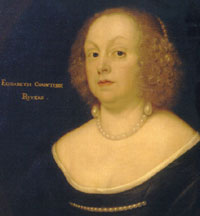
Elizabeth Savage, Countess Rivers |
|
blank |
One of the prominent families to suffer most from these uprisings were the Savages, who had houses at Melford Hall in Long Melford, Rocksavage in Cheshire and Lumley House on Tower Hill. Thomas, Viscount Savage had died in 1635. His widow Elizabeth Viscountess Savage, was born Elizabeth Darcy, and her mother Mary Darcy (nee Kitson), was heiress to the Kitsons of Hengrave Hall. Elizabeth inherited property at St Osyth's from her father, Baron Darcy of Chiche, the original name for St Osyth's. These were all aristocratic Catholic families.
In February 1641, Elizabeth's eldest son John became Earl Rivers, a title inherited from his grandfather. Meanwhile Elizabeth's mother, Mary Darcy, was also known as Countess Rivers.
In April 1641 King Charles I had created Elizabeth Savage Countess Rivers in her own right, with an annual pension of £20. As a female life peer, this was a very rare honour, and was most likely an attempt to protect her from the anti-Catholic moves of the House of Commons during 1641. But it seems that it would not protect her from the mob.
Elizabeth's son, John, Earl Rivers was an active Royalist. He spent the summer recruiting men in Cheshire for the King's army. On 11th July he was censured in the House of Commons for this work, and ordered to be "apprehended to answer for the same". Presumably he was widely known as an enemy of Parliament. Following a day of rioting in Colchester in late August, the crowds set off to march the nine miles to the Darcy family seat at St Osyth, home of Elizabeth, Countess Rivers, mother of the Earl Rivers.
Documents published in the Suffolk Records Society book, "Savage Fortune" include Elizabeth's account of the attacks on her property in the summer of 1642. On Monday 22nd August, 1642, the very day that the King raised his standard at Nottingham, Elizabeth was driven from her house at St Osyth's in fear of her life. On 29th August she had a petition prepared to send to the House of Lords, seeking help to regain her lost goods. The petition included the following account:
"Few hours passed before a rude multitude,(raised for the most part, in and around Colchester) who threatened her death, had broken in and ransacked her house, torn from thence, and despoiled her of all her furniture, hangings, plate, money, apparel, linen and other household stuff....driven away her cattle, carted and shipped away her goods and provision of corn, digged up and destroyed her gardens and other plantations,and laid that place (the seat of her family) wholly waste." The house at St Osyth was now uninhabitable.
Elizabeth had escaped to Melford Hall, but the mob pursued her. Two days later on Wednesday, 24th August, they arrived at Long Melford. Elizabeth was forced to make for Bury St Edmunds, looking to escape to her London house. The petition continued as follows:
"The relation of that outrage was scarce arrived at the petitioner, before the like seized upon her at her other house at Melford, near Sudbury in Suffolk, whither on Wednesday morning after, repaired a multitude of like disposed persons, threatening her death before she had fully escaped their sight, who entered her house, and have from thence also robbed and carried away all the remainder of what was hers. Insomuch as she doth in all faithfullness protest before your lordships, she hath not left unto her so much as a change of apparell, or ought else wherewith to sustain herself, having thus been rifled and lost to the value of £50,000. Besides the miserable destruction in her houses, which were beautiful, and the undoing of all her servants, whose very pockets were searched and they also rifled of all they had."
To make matters worse, her tenants were refusing to pay their rents because of intimidation in some cases, and opportunism in others. Countess Rivers was asking the Lords to give her the right to send servants searching for her goods, and to ask for local JP's , mayors, constables and other officers to seek out the offenders and search for her possessions, and to encourage her tenants to pay their dues. On 9th September such an order was issued by the Lords and Commons in Parliament.
Another account by one Peck confirms this story.
"many thousands swarmed to the pulling down of Long Melford House, a gallant seat belonging to the Countess of Rivers".
John Rous's diary has more detail about the destruction at Melford Hall, as follows:
"On Thursday August 25th late, at sunset or thereabout, came a warrant from Sir William Castleton, high sheriffe, for all trained soldiers in our town of (Santon) Downham, (and so for others in that hundred,) with other able men to appeere at Hargate Heath by Bury, the next day, for suppressing of a rebellious company of about 2,000 etc.. They appeered, and refusing to go with the sherife, or lay downe their armes for others, at length Mr North theire Captaine came, with whom they went, and on Friday apprehended some fewe of the company.
The Lady Savage's house was defaced; All glasse broken, all iron pulled out, all household stuffe gone, all seilings rent down or spoiled, all likely places digged where money might be hidden, the gardens defaced, beere and wine consumed and let out (to knee deep in the cellar), the deere killed and chased out etc.. The lady saith the losse is 40,000li."
Melford Hall was reduced to a ruin by this attack, and the Countess had no money to repair it. In 1649 Earl Rivers had to sell it to Robert Cordell, and in that year the Reverend Ralph Josselin wrote his observations as he travelled through Melford. "I saw a sad divided town, I saw the ruins of that great house plundered out, desolate without inhabitant."
At Stoke by Nayland, "Sir Francis Mannocke's house was pillaged of all goods; (and, as is said, not his writings spared, which he craved, but were torne, nor his dogs)". He was another well-off Catholic, but significantly the mob also soon plundered "as well protestants as papists."
"Also one Mr Martin's house pillaged. Doctor Warren's house was rifled for his Gods (goods?), and a great many set about the market crosse, termed young ministers. Him they huffed and shuffed about, but, (as is said) hurt not otherwise, though he say they tooke money from him. This insurrection scareth all the malignant party."
John Rous, author of the comments above, was born in Hessett in 1584, and appointed minister at Santon Downham in 1623, but resided at Weeting with his father who was rector there. In 1631 his father died and John moved to Brandon, but died in 1644, still "clerk and minister of Downham." His diary is more like a notebook, recording facts he wished to remember, and seems not to have particularly favoured any side in the Civil War. The diary was published by the Camden Society in 1856.
Doctor Warren was Rector at Long Melford, appointed in 1618 by Lady (later Countess) Rivers. He was high church and had supported Bishop Wren's attempts to suppress puritan preaching. As a JP he had used his position to be hard on the "godly sort" at Sudbury and surrounds, and was thus unpopular with the weavers and apprentices of the area. His tithe records and Manor Court rolls were destroyed by the mob in revenge for his past attitudes. Warren would later be evicted from his living and replaced by a string of Puritan ministers.
The corporation at Bury was strongly pro - parliament, but this was not universally the case in the town.
Even in Bury there remained influential men believed to favour the King. Henry Jermyn of Rushbrooke was a hard line cavalier, one of only a small number in Suffolk. The Crofts of West Stow Hall were also Royalists. John Crofts, a parson, even joined the royal army.
In August 1642, Parliamentary supporters in the area were worried that the Powder Magazine in this part of the County was in an inconvenient place and the Key in "untrustworthy hands".
Possibly they referred to Henry Jermyn, and also to Sir William Castleton, High Sheriff of Suffolk, and the Castleton family in general who lived at Bury St Edmunds. Appointed by the King, he was naturally under suspicion.
Parliament had therefore ordered a group of "reliable" Suffolk gentlemen to seize the County magazine at Bury when hostilities began. They probably operated as a committee as early as 28th July 1642 when Parliament issued an order authorising 39 Suffolk Gentry, the Bailiffs and portmen of Ipswich and four Townsmen of Bury St Edmunds to call together all such persons as they think fit within Suffolk to raise horse, men and arms, and receive subscriptions. From this group arose the Suffolk County Committee first referred to by this name in September 1642. This committee controlled the area up to 1666.
On September 21st, John Rous, Minister of Santon Downham, (not to be confused with Sir John Rouse of Henham) was in Bury St Edmunds according to his Diary. There he saw a book describing the siege at Portsmouth, and another describing a fight at Sherborne Castle. But he also witnessed:
"I saw there diverse horsemen to goe into Lincolnshire, who accompanied Sir Christopher Wrey from the White Heart out of towne, a little way towards London, by Hargate House etc, The lieutenant's colors were an armed arme holding up a sword, and this word about it, 'The warre is just that is necessary.'
(The White Hart was an inn in Southgate Street at Bury St Edmunds, although in 1741 it was called the Mitre, and so it may not be the same establishment. Hargate House seems to be Hardwick House.)
In fact the County Committee arose out of the meetings of Deputy Lord Liutenants and Justices of the Peace which had been going on since the 1590's in Suffolk. Before the war broke out they would meet at Stowmarket, where the County Musters were held. They split up between East and West, meeting then at Bury and Ipswich.
When hostilities began, the County Committee met only at Bury until 1648 to raise and equip troops for Parliament. They included Sir William Spring of Pakenham, but were soon led by Sir Nathaniel Barnardiston of Kedington, probably the richest man in the County at the time. Barnardiston died in 1653, but his committee collected over £50,000 a year from 1642 to 1648 for troops, horses and provisions for Parliament. From Haverhill, a prominent member would also be Thomas Cole.
Norman Scarfe has commented that Bury's role as a garrison town was developed at this time. There was no barracks in those days, so troops and their horses were billeted at various inns and hostelries. Establishments in Bury St Edmunds that were named in the records included The Christopher, The Wild Man, The Wrestlers, The Crosse Keyes and Goodwife Glovers'.
The Suffolk Committee divided themselves into small groups, each sitting for a week at Bury, then handing on to the next group. In this way they involved representatives from all over the county, while minimising the individual burdens.
By December 1642, a plan was devised to set up an association of the county committees, as a sort of regional government. The first was in the north, but soon came the Midlands, south east and Eastern groupings. Parliament passed the Eastern Association Ordinance giving authority to this new body of five counties. However, the Suffolk Committee wholeheartedly endorsed this arrangement. The Eastern Association met at Trinity College, Cambridge.
One local Royalist who was willing to fight was Colonel Thomas Blague of Horringer. In 1642 he fought for the king at Edgehill, and would fight in many battles.
During the Commonwealth Stephen Scandarett was to become Haverhill's most influential nonconformist preacher, and a great local opinion-leader.
|
|
1643
|
On 9th February the Suffolk Committee "freely and most willingly" signed up to join the Eastern Association, made up of Suffolk, Norfolk, Essex, Cambridgeshire, Hertfordshire, Isle of Ely and the County of the City of Norwich. Lincolnshire was added in September 1643. Cromwell's Huntingdonshire came in much later.
In March 1643 Lowestoft was occupied by 18 royalist gentry, mostly from Suffolk and Norfolk. They aimed to take it over for the king, hold it as a port to bring in foreign arms, and then attack the Eastern Association army. Lowestoft was possibly chosen because Great Yarmouth was wholly committed to Parliament. Cromwell marched from Cambridge with 1000 cavalrymen and took the town without a fight. This was called the siege of Lowestoft, but it only lasted an hour or so.
The estates of royalist sympathisers and Roman Catholics began to be sequestrated under an order of 27th March. Sequestration meant that the income from property was seized. From 1643 to 1649 this raised £40,917 in Suffolk, a surprisingly high amount, greater than London or Essex, Kent and Norfolk. This was despite the apparently low number of families involved and points to the high value of Suffolk farming at the time, coupled with an efficient administration of seized property.
By May the Eastern Association under Lord Grey, was in trouble. It had failed to pay its troops, and administration was in a mess. By the Summer, Lord Manchester was put in charge of the Eastern Association. For the next 18 months he would transform the Eastern Association into the main unit of Parliamentary control in the East. He was no General or politician, but he soon won over the County Committees, and was running the area by the Autumn. He was styled the Right Honourable, the Earl of Manchester, Major General of the Associated Counties. He took over the purchase of military supplies, and exercised a detailed personal control.
In July and August Suffolk was alarmed by reports of the Royalist army approaching Cambridge. The Earl of Newcastle had reached Gainsborough and Colonel Cromwell needed more troops to stop him.
|
|
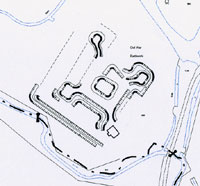
Icklingham Sconce
|
|
blank |
At some point a fortification was built at Icklingham, just over the River Lark by Farthing Bridge. This type of fort was an earthwork square, but with extended corners to give clear fields of fire, and is known as a sconce. Very little is known of this construction or when it was built.
In September Parliament took the Solemn League and Covenant. The intent was that everybody in the country would eventually have to swear an oath to accept the abolition of episcopacy and to reform the Church of England.
In September, Brandon was seized by the Parliamentary forces, and a garrison established there. By December the Suffolk Committee at Bury had to issue an order that banned soldiers from taking free board and lodgings in the town. Constables were told to arrest any soldiers demanding free board or commandeering horses without payment.
|
|

Rushbrook Hall in the 19th Century
|
|
blank |
Henry Jermyn of Rushbrooke, third son of Sir Thomas Jermyn, had been vice-chamberlain to the Queen in 1628, and Master of the Queens Horse in 1639. He was said to be indifferent to religion, and became Colonel of Queen Henrietta's Lifeguard Regiments of Horse and Foot in the civil war. In late 1643 he was wounded leading the royalist Lifeguard of Horse at Auburn Chase. In appreciation, King Charles I made him Baron Jermyn of St Edmundsbury shortly thereafter.
William Dowsing of Laxfield was appointed by Lord Manchester to be Parliamentary visitor for England in December 1643. He was to execute the ordinance of August 1643 for the defacement of superstitious images, pictures and inscriptions.
At Hengrave Hall Lady Penelope Rivers inherited Hengrave and the Suffolk property from her mother, Mary, the Countess of Rivers. Mary was the daughter of Sir Thomas Kytson II and Lady Kytson. Lady Penelope had three husbands, the first being Sir George Trenchard of Wolverton in Dorset. Sir George died childless, shortly after their marriage around 1610. In the following year Lady Penelope became married to her second husband, Sir John Gage of Firle in Sussex. They had four sons and five daughters. Sir John Gage died in 1633. The sons were called Thomas, John, Edward and Henry Gage. Edward Gage became a General in the King's army and was severely wounded in an engagement at Oxford.
Penelope eventually married her third husband in 1642, Sir William Hervey of Ickworth.
In 1648 she would settle Hengrave and Chevington on her third son, Edward Gage upon marriage. Hengrave would be associated with the Gage family now for another nine generations. Lackford and Fornham St Martin were eventually left to the eldest son, Thomas, who had already inherited his father's estates in Sussex.
|
|
1644
|
In January the Suffolk Committee formalised its working methods. It did not require all 40 members to attend every meeting, but divided them into groups each doing a week. There would now be six Chairmen, who would each do a month chairing the business. The Chairmen were Messrs Harvey, Cole, Nathaniel Bacon, Francis Bacon, Peeps and Read. There was no dominating member, although Sir Nathaniel and Thomas Barnardiston were deferred to by all.
William Dowsing of Laxfield was appointed Parliamentary visitor for Suffolk in December 1643. His job was to carry out the order to remove religious art from churches in the County. He appointed deputies and they each took troopers to every church.
|
|
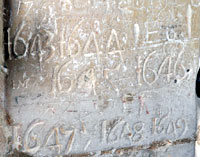
Dated inscriptions - Troston church
|
|
blank |
One such deputy was Captain Clement Gilley of Troston. At his home church in Troston he apparently left alone the inscriptions on the church bells which had prayers for Katherine and Mary Magdalene. Elsewhere it was his custom to remove any prayers to the Virgin Mary and the saints inscribed on church bells. Gilley may have been responsible for whitewashing over the wall paintings at Troston, which were discovered again in the 19th century, and restored in 2009. Inscriptions from this period can still be seen in the Troston church of St Mary.
Dowsing himself visited 150 churches in 50 days. From 20th December 1643 until 2nd January 1644 Dowsing began his work in Cambridge. He worked in Cambridgeshire until 5th January, 1644 (modern dating), but also on that day he moved to Withersfield. It was his fourth church on that day.
"At Withersfield, we brake down 3 crucifixes and 80 superstitious pictures."
Dowsing arrived in Clare on Saturday 6 January. One of his deputies was Thomas Westhropp, who lived at Hundon. They visited Hundon church that day.
Moving to Sudbury on January 9th, they dealt with three churches there.
"Sudbury, Suffolk. Peter’s parish. Jan. 9 1643. (ie modern 1644) We brake down a picture of God the Father, 2 crucifixes, & pictures of Christ, about an hundred in all; and gave order to take down a cross of[f] the steeple; and diverse angells, 20 at least, on the roof of the church.
40. Sudbury, Gregory parish. Jan. 9. We brake down 10 mighty great angels in glass, in all, 80.
41. Allhallows [All Saints], Jan. 9. We brake about 20 superstitious pictures; and took up 30 brazen superstitious inscriptions, Ora pro nobis, and Pray for the soul etc."
Dr Dowsing visited St Marys in Haverhill on January 6th, and, in his own words,
"We brake down about 100 superstitious pictures and seven friars hugging a nun; and a picture of God and Christ; and diverse others very superstitious; and 200 had been broke before I came. We took away two Popish inscriptions with "Ora pro nobis", and we beat down a great stoney cross on top of the Church".
However, it seems that 200 superstitious pictures had already been destroyed by Haverhill people before Dowsing arrived.
At Clare, also on January 6th,
"We brake down a 1000 pictures superstitious; and brake down 200, 3 of God the Father, and 3 of Christ, and the Holy Lamb, and 3 of the Holy Ghost like a dove with wings; and the 12 Apostles were carved in wood, on the top of the roof, which we gave order have taken down; and 20 cherubims to be taken down. And the sun and moon in the east window, by the King’s Arms, to be taken down."
On 5th February, after crossing Suffolk, he stayed in Bury St Edmunds, where it is suggested that he may have lodged with the Moody family, relatives of Thomas Westhropp. His journal notes that
"Bury St Edmunds, Feb. 5. Mary’s parish. Mr. Chaplin undertook to do down the steps and to take away the superstitious pictures.
James’s parish. Mr. Moody undertook for."
On February 6th he was returning to Cambridge, stopping at some churches en route.
"At Newmarket they promised to amend all", presumably without too much prompting from Dowsing.
Thus in some places he was welcomed by at least some of the people. At others he met some resistance. Dowsing collected a fee from each church for his work of destruction. At Great Cornard the churchwarden, John Pain, refused to pay, and was arrested. Dowsing also noted another reluctant payer:
"Thomas Umberfield of Stoke [Tendryng Hall chapel, Stoke by Nayland], refused to pay the 6s. 8d. A crucifix; and divers superstitious pictures. Feb. 2"
Dowsing continued to travel Cambridgeshire and Suffolk carrying out his mission until October.
By February Lord Manchester had established his Eastern Association to such an extent that he could issue Instructions to the Suffolk Committee as to how they should exercise their business, "answerable to my expectation." However, he also believed that in return, he was accountable to them for his actions.
Running a country at war was proving an expensive and difficult business. In February the Eastern Association wrote to the House of Commons to ask for consideration of certain money matters. Basically they were not getting enough money to meet their expenses. There was not enough money to pay the soldiers for 13 months service, but only for 12. There was no allowance for training, recruiting, for changes of garrisons, for occasional "allarums", amounting to £12,000 a month over and above the official assessment. Much of the money could not be collected by way of plundering by the enemy or depopulation, and much of what was had to be given to "superior powers." Furthermore the Association was in debt with no means of repaying it. The result of all this was soldiers short of pay, food and clothing, and some died at their posts.
In March Lord Manchester appointed a panel of ten men to examine all the ministers and schoolmasters in Suffolk who were defying the will of Parliament or were scandalous in their lives, or were "fomentors of this unnatural war". They also had to administer the Covenant passed in the previous year. Any five of them were authorised to act and certify them to Manchester.
Two committees for scandalous Ministers were thus appointed to remove anti-puritan clergy in East and West Suffolk. Royalists were referred to as 'malignants' and high churchmen were called 'scandalous'. About 100 Suffolk clergy were evicted, including Richard Hart, Rector of Hargrave, and Robert Goodrick, Rector of Horringer. At Barningham the rector Randolf Gilpin had held the living since 1629. He had various disputes with his flock over the tithe arrangements, and they disliked him. He seems to have been evicted as early as 1642, possibly because the local Squire was Maurice Barrow, a man so in tune with the Puritan line that he was appointed to the County Committee for Scandalous Ministers.
In May 1644, the Suffolk Committee tried to address the problem of wounded soldiers returning from conflicts with Royalist forces. If they went home and their families and friends could not support them they fell on to parish charities. Many parishes had refused to pay up and this had a bad effect upon military morale. So it was decided that all sick or maimed soldiers in Suffolk, could, with a certificate from their Captains, come to Bury St Edmunds for help. Jasper Shepherd was given an allowance to look after them, and Robert Goodrige, "cirurgion" would be paid to give medical attention.
At the Battle of Marston Moor the army of the Eastern Association fought for Parliament. It included Colonel Russell's regiment, mostly from Suffolk. Despite this victory by Parliament, Lord Manchester and the Eastern Association were worried by the way in which Oliver Cromwell was apparently threatening to bring down the whole of the established order. Cromwell was a winning soldier, but seemed to have no regard to administrative necessities or common courtesies. So when Cromwell advocated Sir William Waller's proposal for the New Model Army to be set up as a crusading force of committed puritans, led by professional soldiers, with no regard to established ranks of society, Lord Manchester was appalled. Cromwell in turn denounced Manchester in Parliament in November, accusing him of failing to press for a crushing defeat of the king.
The so-called Self Denying Ordinance was a bill passed by the House of Commons on 19 December 1644 stipulating that no member of the House of Commons or the House of Lords could hold any command in the army or navy. Since this meant that nobles were automatically debarred from military command (whereas members of the House of Commons could resign and retain their commands), the House of Lords hesitated, but people could see what was coming. It was a manoeuvre to remove Lord Manchester, The Earl of Essex and the Earl of Warwick from military command as they were thought to favour a settlement with the king. Oliver Cromwell was an MP, but was exempted from the Ordinance as he was thought indispensible to the cause.
Crowland had been in Parliamentary hands since April 1643, but in October 1644 it was regained by the Royalists. The Norfolk Committee had to appeal to the Association for more men and money. By December the Parliamentarians had regained it. Even so, Colonel Mildmay wrote to Lord Manchester from Cambridge urging him to leave Crowland and return to defend Cambridge which was then capable of being taken by only 500 horsemen. He was worried that Prince Rupert had 2,000 horsemen coming to Newark, and possibly beyond.
In Cornwall, Colonel Thomas Blague of Horringer was fighting on the Royalist side.
In December 1644, a parliamentary ordinance was passed to abolish the celebration of Christmas, the most popular church festival of the year. This law would be largely ignored until 1647 when a further order became necessary.
From 1644 to 1646 Matthew Hopkins of Manningtree, somehow appointed himself the Witchfinder General, and gained official acceptance of his work. He would charge a town twenty shillings to rid them of witchcraft, and would seize anyone suspected of this crime and put them to a test. This consisted of tying the left thumb to the right big toe, and the right thumb to the left toe, and throwing the suspect into a river or lake. if they could remain afloat, they were judged guilty. He would make his biggest haul in Bury St Edmunds in 1645.
|
|
1645
|
On 30th January 1645, a great conference met at Bury St Edmunds to discuss Oliver Cromwell's proposal for the New Model Army. The intention was to support Lord Manchester in opposing the establishment of this new force. The Suffolk Committee led the way by inviting representatives from all seven of the now enlarged Eastern Association County Committees to attend. They all agreed to oppose the New Model, preferring a defensive war only, and to continue with their established structures and methods. They wanted to control their own forces and pay their own men. They felt that their job was to defend the Eastern Counties, not to wage war across England. They also did not want to spend the £30,000 demanded from the Eastern Association to set up and run the New Model.
Shortly after this conference, on 15th February, Parliament exerted its authority and passed the Ordinance to establish the New Model Army. The House of Lords finally passed the bill on 3 April 1645, and the Eastern Counties association finally had to accept the idea of the New Model Army. Local Government was clearly over ruled by London and Lord Manchester was replaced by Sir Thomas Fairfax and Oliver Cromwell as army commanders.
Parliament now went on the offensive with its New Model Army and won a decisive victory at Naseby in June of 1645. The 13th Troop of Ironsides were raised in Suffolk by Ralph Margery a yeoman of Walsham-le-Willows, pretty much on his own initiative.
Men like Sir William Spring of Pakenham, although a puritan and a parliamentary activist, objected that Margery was not a gentleman, and should not be allowed to lead a Troop. His view was supported by the wealthy Maurice Barrow of Barningham.
Sir William Spring, Baronet of Pakenham, was elected in 1645 as a recruiter for the Long Parliament for Bury St Edmunds, and sat from 1646 to 1648, when he was secluded by Pride's Purge. Although there is no evidence that Sir William Spring engaged in armed combat on behalf of the cause of Parliament, he was a prominent member of the Bury St. Edmunds Committee of the Eastern Association, which recruited men for Cromwell's Ironsides. He was also a staunch friend of Sir Nicholas Barnardiston of Kedington, a more famous advocate of the Puritan cause. Spring sat in the First Protectorate Parliament for Suffolk in 1654 and died at the end of that year. He was buried on 19 December 1654 and his eldest son William succeeded him.
Spring was a close friend of John Winthrop and his priest was John Knewstub. He lived at Newe House, Pakenham.
To Cromwell, however, Ralph Margery was the ideal Puritan soldier. "I had rather have a plain russet coated captain that knows what he fights for, and loves what he knows, than that which you call a gentleman and is nothing else." wrote Cromwell about him in a letter to Spring in 1643.
After Naseby Cromwell's ideas were vindicated, and he became the new star of the Eastern Association, despite a rocky start. Cromwell began to dominate the Committee at Cambridge, which met daily up to 1646.
In August Parliament changed the structure of the Church of England from episcopacy to presbyterianism. They had already abolished episcopacy in 1643, and needed a replacement structure. Each Parish would now be run by a committee. Ministers were appointed and so were lay elders for each parish area.
A Presbytery consisted of the Minister, a number of elders, deacons and in some cases, widows. Each Parish had a Presbytery, the basic unit of church management. Once set up, their main job was to act as a church court for the area, and in due course, to appoint the minister.
In Suffolk the ministers of groups of 12 parishes combined together to consider common matters of government covering the grouping. Each group of 12 parishes was called a "classis". So by November Suffolk was divided into 14 classical presbyteries to replace deaneries and archdeaconries.
The Rector of Barrow, John Cradock, who had taken over Barrow from his father, Richard Cradock, was made an elder of Hundred of Thingoe. He was of the Puritan persuasion, but seems also to have been an amateur artist. His daughter Mary was born in 1633, and was brought up to appreciate art in the company of local artists such as Nathaniel Thach, Matthew Snelling, Robert Walker and Sir Peter Lely. Thach lived in Barrow and painted miniatures, while Snelling lived at Horringer, also working in miniatures. Walker was a favourite painter of Oliver Cromwell and his parliament, and Lely would later be Court painter to Charles II. Mary would become a famous portrait painter following her marriage to Charles Beale in 1652.
During the chaos of war, Matthew Hopkins, the self appointed Witchfinder General went about his business. He was born in Great Wenham in Suffolk, but at this time lived near Manningtree, where he became called the Hangman of Manningtree.
Matthew Hopkins, the self appointed Witchfinder General, was responsible for many trials of witches in various parts of the eastern counties. He played upon peoples fears and beliefs until the largest such trial in England at the time took place in Bury St Edmunds.
In August 1645 this notorious trial of witches took place in court at Shire Hall in Bury. Neighbours and self appointed searchers had dragged 124 old women and a few men to Bury Jail. Edmund Calamy had returned briefly to Bury to be one of the judges at the trials. One old man, John Lowes, aged 80, had been the vicar of Brandeston, and seems to have been accused on the grounds of his bad temper, and keeping a ginger cat called Tom. Confessions were wrung from these people by coercion. Lowes was tried with 17 others, found guilty, and hanged. At his trial he retracted his confession to no avail.
These trials were adjourned on news of the approach of Royalist troops from Peterborough, and over a hundred accused witches remained in jail. There is a report of 50 more hangings at Bury, but most, if not all, of the remaining accused seem to have been sent home. Accounts differ, with the numbers put on trial given as up to 200, and 18 definitely hanged in Bury during August 1645.
A woman called Binks was accused of witchcraft and examined by John Stern, the witch-hunter, and Samuel Fairclough, then vicar of Kedington, in Haverhill market place.
The Headmaster of Bury's Grammar School was a royalist sympathiser, Dr Stephens. He was finally sacked for his views as a "notorious malignant" in 1645. He set up his own school in another house, but so many of his old pupils followed him that the Grammar School ceased to be viable.
During 1645 the former Archbishop of Canterbury, William Laud, was executed as an alleged papist.
|
|

Pamphlet - Lanseter's Lance
|
|
1646
|
By this time there were a number of minority religions setting themselves up. Baptists, Ranters, Muggletonions, Quakers and Congregationalists all arose around this time. They were similar in many ways to Puritans so Oliver Cromwell mostly tolerated these religions as far as they did not interfere with public order.
Thomas Edwards (1593-1647) was the most outspoken and persistent Presbyterian opponent of these sects and of religious toleration. He wrote many pamphlets describing and attacking these "Errors, heresies, Blasphemies and pernicious practices", apparently with little regard for the truth of his allegations.
From February 1646 he published three parts of a work called "Gangraena" which included scandalous allegations and personal attacks on the senior figures of these new movements. One of those attacked was John Lanseter of Bury St Edmunds, a shopkeeper in Cook Row.
In Bury St Edmunds John Lanseter and seven others became founding members of a new movement who signed their Congregational Covenant on August 16th, 1646. Three of the signatories were women, a very unusual feature at the time. They were probably attracted by the teachings of Katherine Chidley. They were members of the puritan Presbyterian communion who currently controlled the two parish churches of St Edmundsbury. They were called Covenanters at first. Thus the New Independent Church was set up in Bury in 1646, later to be called the Congregational Church.
This church was set up with help from two London missionaries, Katherine Chidley and her son Samuel. They witnessed the Bury founding document or Covenant. They believed that the Church of England was evil and they intended to be fully separated from it.
After the Chidleys departed back to London, Lanseter remained the preacher of his new church.
John Lanseter replied to "Gangraena" by publishing his own "Lanseter's Lance to Edwardes' Gangraena",
which described how he had travelled to London to confront Edwards, and to describe to him in detail where his allegations were incorrect and to ask for an apology in print. Edwards refused to accept Lanseter's account, and so Lanster felt obliged to reply in print. Unfortunately in this encounter he described his friendship with the Chidleys and the help they had given him, and this enraged Edwards further, who hated the ides of a woman preacher. he also hated her principles, calling her an old Brownist, and in a further pamphlet accused Katherine Chidley of being the real author of Lanseter's Lance. Samuel Chidley was also associated with the Levellers, another group accused of subversion.
The works of John Edwards had done much to divide Presbyterians from the Independents in a way which only benefitted the Royalists, who revelled in the dissension among their opponents.
By the end of 1646 the First Civil War had come to an end. The battle of Stow on the Wold was the last defeat of the last Royalist army. The unpaid royalist army disintegrated and both sides wanted to go home. Royalists like Thomas Staunton of Horringer returned home after the war was over to find his reception hostile and his business ruined. He soon decided to apply himself to merchants affairs and settled in Spain, although he continued in his royalist sympathies. Despite his expressed hopes to give further service to the King, necessity forced him to his own affairs.
Despite a largely puritan population, about 50 well to do Suffolk families remained pro-royalist, notably the Jermyn family at Rushbrooke. Sir William Hervey of Ickworth even raised a regiment for Charles I in the civil war.
In the years from 1643 to 1646 about 129 Anglican clergy from Suffolk's total of 517 were hauled up before Committees and accused of being scandalous or malignant. They were evicted from their livings and four fifths of their property was "sequestered" or confiscated. Virtually anybody who had accepted the directions of Bishop Wren in the late 1830's was put on trial. Even being an inadequate preacher brought penalties.
Lands confiscated from the Bishops was sold off to raise money to pay for off some of Parliament's debt mountain from the war.
|
|
1647
|
As hostilities seemed to be ending, Dr Stephens was reinstated as Headmaster of the Grammar School at Bury. He had shown that without him the school could not survive, despite his royalist views. Bury School had "become much decayed" in the two years since Stephens had been dismissed, and the school governors had to beg him to return, which he did, bringing his private pupils back with him.
Public disquiet about Matthew Hopkins and his witch hunts were to force Hopkins to abandon them by 1647. Although he is sometimes said to have been executed himself, he probably died of Tuberculosis.
George Fox, a Leicestershire puritan from a weaving family began to preach about his "great experience" of God and his speeches sometimes caused a shaking or quaking in his audience. Thus began the Quaker movement or Religious Society of Friends, who would soon become significant in local history.
In May 1646 King Charles I had surrendered with his army to Scottish forces, but not until 30th January 1647, was he handed over to the English forces. On 15th March, 1647, the last outpost of Royalist sympathy, the castle of Harlech, surrendered to the New Model Army.
On 4th June King Charles I was taken to Newmarket as a prisoner of the New Model Army. Apparently he had been given a choice of locations to be held. He was allowed to hunt on the Newmarket Heath, and he held discussions with Oliver Cromwell while walking in the garden of his palace at Newmarket. Sir Thomas Fairfax also visited the king at Newmarket in this period. These were the king's last 12 days at Newmarket.
Parliament now tried to settle terms with the King and tried to pay off its army as funds had run out. In August the army marched into London to force Parliament to levy taxes to keep them in the field. At this time the Levellers were preaching religious freedom and condemning the Long Parliament for corruption and tyranny. The army tightened its grip. Parliament's presbyterian reforms seem to have failed by this time in Suffolk, as the system was not seen to be working.
|
|

Account of the riot
|
|
blank |
In 1644 Parliament had abolished Christmas, but in many places, this had been largely ignored. In June, 1647, a further Order in Parliament was passed as the Puritans tried to enforce this law. Christmas celebrations were banned and traders were ordered to open their shops as if it were a normal weekday. At Christmas this would result in a riot at Bury St Edmunds.
Some 150 Apprentices gathered on Christmas Day and were intent on enforcing shop closures and threatened to kill any traders that opened their doors.
They armed themselves with heavy clubs studded with nails. There was bloodshed reported in the Horse Market and at least two people were seriously injured. John Lansetter's shop in Cook Row was particularly targeted because of his well known position as an Independent and a pamphleteer.
Extreme Puritans viewed this riot as a "horrid plot and bloody conspiracy," as shown in the attached picture of a pamphlet issued at the time.
Perhaps the oddest thing about these riots is that the disputes were between what we would see as different degrees of Puritanism. The "established" version of Puritanism were the Presbyterians, while the rest were known as "Independents". One such Independent was John Lanseter or Lanceter of Cook Row in Bury St Edmunds. Lanseter was against Christmas as a pagan and Popish invention, and so he felt that he should continue to open his shop and trade as normal on Christmas Day. Royalist supporters, known as 'malignants' to the pamphlet author were happy to side with Prebyterians against Lanseter's stand and provoke a riot which threatened Lanseter's life and property.
Similar riots took place in Ipswich on Christmas Day as well. Both Bury and Ipswich were basically pro-parliament, and Ipswich had been a strong Puritan town for many years. Perhaps elsewhere this law was either accepted or quietly ignored.
In December the King managed to make an alliance with the Scots to re-open the issues over which he had lost the First Civil War.
|
|
1648
|
The years 1648 - 1649 are known as the Second Civil War. By the modern calender the uprisings were all in 1648, and Suffolk people participated in the troubles. This was a revolt of the provinces against centralisation and military rule. Although it is true to see it as another Royalist rising, it now included many moderate parliamentarians. It was fiercest in regions not paralysed by the effects of the first civil war, such as East Anglia, Kent, South Wales and Yorkshire. The revolts happened sporadically, one by one, and the army mostly was easily able to quell them.
At Stowmarket there was a "tumultuous assembly", and drums were beaten, but the authorities soon dispersed them.
At Bury St Edmunds a defiant crowd gathered on 12th May to protest about the Puritan restrictions on the old revels of May. Just as they were erecting a Maypole for the traditional , but long banned Maypole dancing, a troop of Lord Fairfax's cavalry rode into town. The rowdy crowd shouted out for "God and King Charles", and chased the no doubt bewildered cavalry out of town. Things escalated when the crowd decided to seize control of the powder magazine and put the town into a state of defence.
By now the crowd was said to number 600, with a further 100 mounted on horseback. Although this disturbance was called a Royalist rebellion, and indeed it was so, it was not a serious military threat. Parliament regained the town in two days on 15th May. The rioters are said to have "yielded to mercy". There does not seem to have been any organised leadership, and seems to have been a protest by working people.
There was an interesting side effect of this action at Bury. Although the local militia had quickly regained order in the town, a messenger had already been sent to fetch the army. When the army arrived, they assumed wrongly that the local militia were the royalist revolutionaries they had been sent to quell. Likewise the militia were called to arms as the approaching army seemed hostile. Both side wore similar uniforms, and it was lucky that a battle was avoided. Thereafter the Parliamentarian Army was ordered to wear red coats, and this was the basis of British army uniform for the next 250 years.
After this riot the Suffolk Committee moved its Headquarters from Bury to Stowmarket.
On 12th June 1648, Colchester was occupied by 5,600 soldiers of the Royalist side under the Earl of Norwich, George Goring. Clearly this was a serious declaration of war, not just a spontaneous workers riot.
At Linton in Cambridgeshire, perhaps inspired by the news from Colchester, about 500 men on horse and foot assembled from Newmarket, Exning and Lidgate to support the King. Some had come up from Audley End and Saffron Walden. Captain Sparrow of Wickhambrook defeated and dispersed them. This took place from June 13th to 16th 1648.
At Newmarket during June, the Royalists were said to have gathered on the pretence of attending the horse races. On June 15th three Royalist Colonels tried to raise volunteers for the King in the market place, but were quickly arrested, although there was some gunfire in the process. This incident was possibly an offshoot of the gathering at Linton.
Colchester was besieged by the Parliamentary army on 13th June, and finally surrendered after a two month siege. The parliament's New Model Army had Lord Thomas Fairfax as its Commander in Chief, and he led the siege. This was one of the bitterest engagements of the civil wars. In those two months until surrender on 28th August there was fierce fighting, heavy bombardments, and starvation of the town. Some 1500 people died, 186 houses were destroyed, and the garrison eat its 800 horses. The aftermath was a huge fine for the town, executions and exiles to the West Indies.
Sir Thomas Barnardiston of Kedington led one of the infantry regiments on Parliament's side in the siege. There were four Regiments of Foot and seven troops of horse from Suffolk fighting against the royalists. This made over 2000 men. Fairfax brought 4,200 from the New Model Army, and there were 2,600 Essex Militiamen. Probably over 9000 men attacked Colchester, well led by seasoned and motivated members of the gentry.
Only a few members of the Suffolk gentry seem to have been involved on the Royalist side in this second war. One of the few was Lieutenant Roger D'Ewes who fought at Colchester, defending the town for the king. He was the younger brother of Sir Simonds D'Ewes of Stowlangtoft.
Another Suffolk Royalist gentleman apparently prepared to fight was John Morden of Great Bradley. He was involved for the king in the rising at Linton in Cambridgeshire. However, Morden, along with Thomas Poulter, and Oliver and Edward Bridgeman of Exning pursued their accusers through the courts, saying that they had been arrested by the Royalists, and were actually Parliamentarians. They claimed to have been en route to take men and horses to Captain Sparrow at Lidgate. Losing their way, they lodged at Audley End and were arrested by the royalist Captain Winstanley. Their accusers were four men out to take revenge and make money from them. The Committee that examined the case in 1649 to 1650 accepted Morden's version of events.
Sequestration of Royalist incomes continued, but there was some room for evasion or compromise. Richard Gooding of Bury St Edmunds claimed his father's land was worth £50 a year, whereas the Lay subsidy roll of 1641 had put a value of three times that amount on it.
By December 1648 most of Parliament and the country wanted the King back in charge to restore peace and order. A few people, led by the leaders of the army wanted to remove him and install a totally new form of government.
In Pride's Purge of Parliament, on 6th December the army arrested 45 Members of Parliament, and ejected 186 more. Sir Simonds D'Ewes of Stowlangtoft was imprisoned, and was the only Suffolk MP thought to be so hostile to the extremists as to be put in jail. He was MP for Sudbury since 1640, and a prominent Puritan in Suffolk.
The ejected or secluded MP's included Sir William Spring of Pakenham, one of Bury's two MP's since 1645. Colonel Thomas Pride led this purge because he was determined to stop Parliament from discussing terms with the King. In protest two-thirds of the remainder boycotted the House. Among these abstainers were Sir Thomas Barnardiston of Kedington, MP for Bury St Edmunds since 1645, and Sir Nathaniel Barnardiston, one of the Suffolk's County MP's. Brampton Gurdon, one of Sudbury's two MP's, also absented himself.
The remaining hard liners in Parliament now decided to put the King on trial, but probably only about 17% of MPs were involved in the decision. They were called The Rump, and on 28th December issued a declaration to put the King on trial.
In 1648 Sir Edward Gage married Lady Mary Hervey. Edward was a royalist war hero, having fought for the king and been wounded in the process. His mother, Lady Penelope, had inherited Hengrave Hall and its manors from her mother, Mary, the Countess Rivers, who had been daughter to Sir Thomas Kytson II. Lady Penelope now settled Hengrave and the manor of Chevington on her third son, Sir Edward Gage, on the occasion of the marriage. Lady Penelope had deliberately settled lands on her third son "knowing and considering that my eldest son was plentifully provided for.... of a competent and considerable value, and having made convenient provisions for maintenance of my two other sons, John and Henry, an ernest desire to raise another branch of my family hath moved me to assure my manors and hereditaments upon my said son." By this action Hengrave would be associated with the Gage family for another nine generations.
Lady Penelope herself had married her third husband, Sir William Hervey of Ickworth, in 1642. The Lady Mary Hervy was one of Sir William's daughters by his former wife, Susan Jermyn, of the Rushbrooke Jermyns. Thus did the local families consolidate their positions and cement their relationships.
By December 1648, John Lanseter's Independent Congregation in Bury seems to have dwindled and a new Covenant was signed with only Lanseter and two others remaining as signatories from the 1646 Covenant. This church flourished and survives to the present day as the Congregational Church in Whiting Street, Bury St Edmunds.
Sugar replaced tobacco as the main crop on St Kitts, and the sugar owners became wealthy from supplying sugar to Europe.
|
|
1649
|
By January 1649, by modern reckoning, the Rump of Parliament had already decided to put the King, Charles I, on trial for his so-called crimes. His worst offence to extreme Puritans, was to re-open the fighting after his defeats in the First Civil War. They believed it was the Will of God that they had prevailed in 1646. Thus when the king began the second war in 1648 he was going against God's will, as they saw it.
|
|
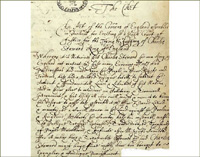
Indictment of the King
|
|
blank |
In January 1649 the King was tried for his life. An account of the trial of Charles I was written by John Phelps, a clerk of the court. This was the first and only time a king was put on trial for treason. It should be noted that at this time the official start of the year was on March 25th, with 1648 running from 25th March 1648 through to 24th March next, so Phelps would have dated this event to January, 1648. As far as possible, this chronicle uses the modern style of dating to minimise confusion as much as possible.
According to John Phelps' account, Charles was brought from Windsor Castle to St James's Palace on 19th January 1648, but 1649 in our reckoning. The next day he was led into Westminster Hall for his trial. There were no existing laws to deal with such a trial. In the end, Charles' accusers used an ancient Roman law that said a military group could try to overthrow a tyrant. The king refused to accept that the trial was legal and would not answer the charges made against him. However, the commissioners of the court found Charles guilty and sentenced him to death. The execution was carried out on the balcony of the Banqueting House, Whitehall, on 30th January. He showed a dignity and forbearance which aroused public sympathy when he was beheaded. In life he had been dishonourable and duplicitous.
Much of England, including many Puritans, were appalled by the King's execution. They had only wanted to get him to govern with Parliament, not to remove him. Even senior activists like Nathaniel Bacon of Ipswich were in despair.
Queen Henrietta Maria and her household left England to live in exile. Henry Jermyn of Rushbrook, Baron of St Edmundsbury, served in her court in exile as head of her household. His reward in 1660 would be to be made Earl of St Albans.
England now became a republic. In March the Monarchy and the House of Lords was officially abolished. The Anglican church was also abolished and people were no longer fined for not attending their local church. However, everyone was still expected to attend some form of religious worship on Sundays.
The Commonwealth was declared in June, and would last until 1660, an eleven year constitutional experiment. From 1649 to 1653 the remainder of MPs ruled as the Rump Parliament.
|
|
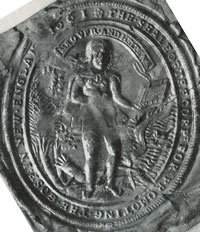
Seal of the New England Company after 1661
|
|
blank |
Despite these constitutional upheavals, Puritan religious zeal still prevailed. A new company was incorporated by the Parliament on 27th July, 1649 to be known as "The Society for the Propagating of the Gospel in New England," which soon became known as the New England Company. The purpose was initially to support formerly deprived clergymen of the Church of England who had emigrated to the American Colonies in order to pursue their puritan religion in the years before 1641. These would become paid missionaries, along with new recruits, to spread the gospel to native Americans. Oliver Cromwell directed that there should be a general collection throughout England and Wales, which raised nearly £12,000. Most of this was to be invested in land in England, and the rents and proceeds from the land would be used to support the company's missionaries.
(After the Restoration in 1660 all the Puritan Acts were revoked and the company's position could only be rectified by a Royal Charter, finally granted on 10th April, 1661. The company seal shown here dates to this time. The company motto "Come over and help us" is just visible on the seal.
In 1664 the Manor of Eriswell with Chamberlaynes, and associated lands in that parish were formally conveyed to the chartered New England Company.
The New England Company would own most of Eriswell and buy up more property in the area until 1869, when it sold the total of 6,665 acres to the Maharajah Duleep Singh.)
Oliver Cromwell had become Commander of the Army by 1649.
In April 1649 the lands seized by Parliament from the Cathedrals was sold off. The Bishops' land had already been sold off in 1646. In July 1649 the Crown lands were sold to raise money. The post civil war period was the greatest transfer of land since the Dissolution of the Monasteries. Men like Ralph Margery of Walsham le Willows came out of the war on the victorious side, and was able to buy crown land in Bedfordshire and Lincolnshire. Another Roundhead soldier, John Moody of Bury St Edmunds, also bought crown lands.
Other Suffolk men got land in Ireland, having invested in its re-conquest in an arrangement in 1642. Sir Thomas Barnardiston of Kedington got 2,221 acres. Samuel Moody, a cloth merchant in Bury St Edmunds got 888 acres in Ireland, and lesser areas went to Philip Sparrow of Wickhambrooke, and John Fiske of Rattlesden.
In 1642 the Countess Rivers, of a prominent Catholic Royalist family, had been hounded out of Melford Hall by a destructive mob. The house was reduced to a ruin.
In 1649 (see 1654) Earl Rivers had to sell the remains of Melford Hall to Robert Cordell, and in that year the Reverend Ralph Josselin wrote his observations as he travelled through Melford. "I saw a sad divided town, I saw the ruins of that great house plundered out, desolate without inhabitant."
In Scotland, however, Charles II was acclaimed as the new rightful king on February 5th. This would eventually lead to more conflict.
Their most famous member of the sect known as the Ranters was Laurence Clarkson or Claxton, who joined the Ranters after encountering them in 1649. Under the influence of the Ranters, Claxton published his 1650 tract called "A Single Eye" in which he espoused the dissenting group's ideals. Ranters were regarded as heretical by the established Church and seem to have been regarded by the government as a threat to social order. They denied the authority of churches, of scripture, of the current ministry and of services, instead calling on men to listen to the divine within them.
|
|
1650
|
Sir William Hervey of Ickworth had been a Royalist supporter, but in 1650 he was prepared to serve the new Commonwealth by becoming High Sheriff of Suffolk. He had not been active militarily, and it seems that in many places this post was still being given to ex-Royalists. There was still a feeling that men of a certain class were needed to hold such a post. For their part these men felt that good order under a republic was better than no order.
However, there were now opportunities for lesser gentry and even below that class, to become JP's. Gordon Blackwood has shown that there was a considerable increase in the magistracy filled from lesser gentry and even "plebeians" throughout the 1650's.
Gibson Lucas of Horringer was an active JP of Radical tendencies. Thomas Chaplin and John Clarke were assiduous JP's from Bury St Edmunds, of "plebeian" origins. Both were also Aldermen of Bury Corporation.
The Suffolk County Committee disappeared in 1650. There had been a County Assessment Committee since 1643 which assessed property taxes for Parliament, but it became more important after the demise of the County Committee.
In 1650 there was a failed conspiracy in Norfolk to restore the monarchy. One of the main participants was Colonel Thomas Blague of Horringer, a long time soldier on the Royalist side.
In July Cromwell marched into Scotland who had declared for Charles II. The period 1650 to 1651 might be called the Third Civil War.
|
|
1651
|
On August 5th King Charles II invaded England from his Scottish base. Cromwell had attacked Perth, but deliberately left the road to England open to stretch the King's supply lines and lure him out. On September 3rd Cromwell met the King's army and defeated him at Worcester.
Suffolk Royalists Colonel Thomas Blague of Horringer and Lord Francis Willoughby of Parham fought for Charles II at the Battle of Worcester.
In October Charles II escaped to France.
|
|
1652
|
In 1634 Sir Cornelius Vermuyden was employed by a company headed by Francis, Earl of Bedford to drain a large area of land now known as the Bedford Level. The work included the (Old) Bedford River and nine other major drains. By 1637 this work was completed.
In 1652 Sir Cornelius Vermuyden completed drainage works on the Great Ouse that he had worked on since 1649. This included the cutting of the New Bedford or Hundred Foot river parallel to the Old Bedford River.
The Denver Sluice was constructed at the head of the River Great Ouse. This construction isolated the Great Ouse and its tributaries from the tidal effects of the sea, and is thought to have contributed to the silting up of the Little Ouse and the River Lark. This, in turn, would lead to the need to improve the waterways for navigation after the needs of drainage had been catered for. In 1670 it would become necessary to improve navigation on the Great Ouse and the Little Ouse, or Brandon River, as it was also called.
At Euston Hall, Edward Rookwood, a Catholic recusant, had to compound his estate for £700 to pay his fines off. He had been in debt for some years, and these fines would finish him off financially.
One of the strange Puritan sects that arose at this time were the Muggletonians. Lodowick Muggleton, (1609 - 1698), was a Puritan religious leader and anti-Trinitarian heretic whose followers, known as Muggletonians, believed he was a prophet.
After claiming to have had spiritual revelations, beginning in 1651, Muggleton and his cousin John Reeve announced themselves as the two prophetic witnesses referred to in Revelations 11:3. Their book, "A Transcendent Spiritual Treatise upon Several Heavenly Doctrines", was published in 1652. Muggleton was imprisoned for blasphemy in 1653, and his own followers temporarily repudiated him in 1660 and again in 1670. His attack on the Quakers led their leader, William Penn, to write "The New Witnesses Proved Old Hereticks" (1672).
|
|
1653
|
Oliver Cromwell, Commander of the Army since 1649, now led a call for a godly reformation of the country, as he was by now fed up with the Rump Parliament. The Rump were seen as too conservative for the army, so Cromwell dissolved them in April. He could not call free elections because he feared defeat of his ideas, so he called an 'assembly of saints'. In reality he hand-picked 140 men with his own ideological and religious leanings and they became known as the Nominated or Barebones Parliament, and ruled from July.
No boroughs were summoned to this parliament, but some attempt was made to recognise population size, and Suffolk sent 5 MP's
After 5 months the Nominated Parliament collapsed and decided to hand over government to Oliver Cromwell to rule as Lord Protector and Head of State. The Commonwealth had ended. Under the Protectorate Cromwell would rule until September 1658 when he died.
A Royalist secret society called the Sealed Knot started in 1653. It had strong connections in East Anglia.
Sir Nathaniel Barnardiston of Kedington died. His son, Sir Thomas Barnardiston succeeded him. The family was just as influential in Suffolk now as it had been in the first days of the Suffolk Committee in 1640.
|
|
1654
|
In 1652 George Fox began his mission to bring his ideas about God to a wider audience. His followers were to become the Society of Friends, but were also to become referred to as Quakers, as a term of derision.
The Quakers had at first been a north of England movement, and in 1654 they sent a "mission to the south". Two quaker preachers duly arrived in Suffolk, and probably came to Haverhill. They were Richard Hubberthorne and George Whitehead, and although the east of England was "stony ground for Quakerism", they started a small group in Haverhill. Anthony Appleby was the most prominent of this small group.
On 6th July, 1654, John Lanseter, who had been a founding figure of the Independent movement in Bury St Edmunds and main signatory of the 1646 Covenant, was ejected from his own church for the sins of drunkenness and uncleanness. The record stated that "John Lanseter a member of this church, one of the foundation, for divers years an useful instrument for the good of the church, afterwards falling into the heinous and beastly sins of drunkenness and uncleanness was at length with great sorrow and lamentation when the whole church was met together, delivered over into the hands of Satan and cut off from the body about the 6th day of the fifth month commonly called July in the year of grace 1654."
Cromwell summoned his second Parliament in 1654, and now included the boroughs, but adjusted their representation to accord with population. Bury was allowed just one MP. King James I 's charter had allowed it two MP's in 1606, as it had been the practice to give all boroughs the same number. At the Restoration in 1660, this position would be resumed.
Robert Cordell was the son of a London merchant and a financial supporter of Parliament. In 1654 he bought Melford Hall for the sum of £28,959. (Check 1649/50)
In 1654 all horse racing was banned by Oliver Cromwell and many horses were requisitioned by the state. The King's palace in Newmarket had already been seized by Parliament and sold off. By 1654 it was falling into disrepair, and would be more or less destroyed over the next few years.
|
|
1655
|
The Quakers had several practices which offended the Establishment of the day. They believed that there was no need for priests and referred to church buildings as steeple-houses, reserving the word church to refer to the congregation, not to a building. They refused to bow or doff their hats to the gentry and even refused to use the names of some weekdays and months where these derived from the names of pagan gods. They were often prosecuted for abusing ministers of the church. In 1655 however, George Fox the Quaker leader alienated his movement from the mainstream even further when he refused to pay church tithes and the Poor Law rates. Quakers were thus not tolerated by Cromwell in the way that the quieter splinter religions like congregationalists were.
The Quaker missionary Francis Howgill wrote in July 1655 that he held meetings in Norwich, Ipswich and Edmundsbury. One of the little rebellions of Quakers was to refuse to use the word saint, so St Edmundsbury would be called only Edmundsbury. Whatever the name, this is the the first evidence of quakerism in Bury St Edmunds. Unlike the reception in 1654, Howgill wrote that "Many large and great meetings we had....and we kindled a fire in that country."
Some other Quakers were arrested at Bures and two men, George Whitehead and John Harwood, were imprisoned in Bury gaol.
At this time the gaol in Bury was opposite the Corn Exchange, on the site of today's MVC Music and Video store. Today it would be described as being on the corner of Woolhall Street and Cornhill. They described it as "a low dungeon-like place, under a market house, our poor lodging being upon rye-straw on a damp earthen floor." For protesting against the conditions they were moved into a deeper dungeon, about four yards deep underground reached by a ladder. It had "but a little compass at the bottom and in the midst thereof an iron grate, with bars above a foot distant from each other and under the same a pit or hole, we knew not how deep". This gaol was eventually pulled down in 1770.
Catholics were also suffering. The estate of Euston Hall passed out of the hands of Edward Rookwood, a recusant, to Gorge Fielding, the Earl of Desmond. Rookwood had spent a fortune on the Hall before the war, but had suffered heavy fines for recusancy. In the end he had to sell up.
Despite all this, Bury was regarded as a desirable place to live by the well to do. The Vicar of Coddenham, one Matthias Candler, is recorded as saying in 1655 that "many of the gentry buy or hire houses in Bury because of the pleasantness of the place." Writers would repeat such comments up to the present day.
The Lord Protector Oliver Cromwell now introduced the Rule of the Major Generals in August, giving up on Parliament. Each General was given one of the 12 districts to command, as Cromwell had become alarmed by the number of royalist plots being exposed.
|
|
1656
|
The Major Generals brought in the Decimation Tax to pay for local militias to keep order against Royalist plots. The idea was to tax Royalists to make them pay for their own plots! Royalists like Richard Everard of Hawkedon had to pay £10 for an estate valued at £100. He was lucky insofar as his true annual value was probably £250. Such taxes had already ruined Edward Rookwood of Euston, and would now ruin Richard Chapman of Livermere. Both these gentlemen seem to have been exceptional in being over-assessed. Chapman had to pay £50 on an income of £100.
Two Quaker preachers, George Harrison and Stephen Hubbersty had been "witnessing to the truth" in the streets of Bury St Edmunds in December 1656. The response was hostile and none of the inns or taverns would take them in, so they headed for the home of Anthony Appleby, a Quaker living in Haverhill, to pass the night. A mob soon assembled outside the house, shouting for the men to come out. Next day the mob reappeared, broke into Appleby's house and dragged out the two strangers, beating and kicking them to the end of the town.
The two men rode off to Kedington to lay complaints about their treatment to the local magistrate, Thomas Barnardiston. By now, Harrison was ill, partly from the beating no doubt, and partly from the winter weather and the long night ride to Haverhill. Barnardiston refused to hear their complaint because they would not pull off their hats to him and they departed for Coggeshall. Six weeks later George Harrison died and the record book of the Society of Friends recorded "whose blood will be charged upon thee, O Haverhill".
Sir Robert Drury of Hawstead and Hardwick, had made many plans to develop his Hardwick estate, acquired in 1610. However, he was to die in 1615, and Hardwick passed to his sister Frances. On her death, the estate passed to her son, Sir Christopher Wray. By 1656 the Wray family wished to sell the estate, and they found a wealthy prospect in Thomas Cullum.
|
|
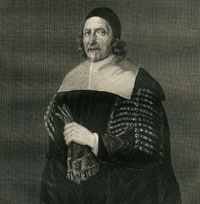
Thomas Cullum, created baronet in 1660
|
|
blank |
Thomas Cullum was a wealthy draper in London who had been Sheriff of London in 1646, and this portrait by Sir Peter Lely shows him in the robes of that office. By 1656 he was in his late 60's, and looking to retire from business. Thomas Cullum was the youngest son of John Cullum of Thorndon in Suffolk. Wishing now to become a country gentleman, he purchased the estates of Hardwick and Hawstead on the outskirts of Bury for £17,697. The Cullum family would retain a strong presence in the town and surrounds right up until 1921, when the last male heir died. The Cullum family presence remains however, with the Cullum collection of pictures, china, objet's d'art, and an extensive library, which were all left to the town of Bury St Edmunds.
Although Hawstead Place had last been improved in 1510 by Sir Robert Drury, Thomas Cullum chose it as his country seat, and moved in in 1657. Thomas Cullum was to be knighted in 1660 by King Charles II in recognition of his services to the Royalist cause.
A few horse races had taken place at Newmarket during the 1650s, and in 1656 these were banned by Oliver Cromwell as he believed they were a cover for royalist gatherings.
|
|
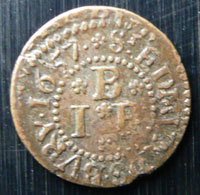
John Baythorne's token
|
|
1657
|
In 1644 the old farthings issued under a Royal Patent by Lord Harrington, and later known as Maltravers farthings, were demonetised. Although a new issue of royal small change was agreed, the Civil War scotched the plans. So there was a growing shortage of small change, which resulted in a few traders issuing their own tokens for one farthing. This started in a small way in 1648 and would build up to a peak between 1666 and 1670.
At Bury St Edmunds, John Baythorne issued this farthing, inscribed "John Baythorne of St Edmundsbury 1657", with the initials I P below a B. It became normal for issuers to include their wife's initials as well, so I stands for John, B for Baythorne, and P was probably his wife's initial.
You can see more 17th Century tokens, fronts and backs by clicking here: Seventeenth Century Tokens.
In January Oliver Cromwell ended the rule of the Major Generals and the Decimation Tax and recalled Parliament.
Borough and parish records were often concerned with public health, but there were no organised arrangements for helping the sick poor. In 1657 Dr Richard Child was thanked for giving free advice to the poor sick people of Bury St Edmunds, but presumably no medicines.
In Haverhill the local puritans continued to harass the Quakers. John Sewell, a local Quaker was put in the stocks. His brother Ambrose and John Hall were seen speaking to him, and were sent to Bury goal as punishment. Anthony Appleby had goods distrained for refusing to pay his £20 tithe to repair the parish church.
In Bury similar persecution of Quakers had also continued.
Following an appeal to Cromwell himself, the Lord Protector made an order to release all 'Friends' in prison at Bury St Edmunds, Colchester and Ipswich. In all, thirty-three Quakers were set free in Bury. They included men like George Whitehead, who seemed to have been held since the arrests of 1655, and even one man, William Burroughs, of 80 years of age.
George Whitehead left Bury but was arrested again shortly after release, and flogged at Nayland.
|
|
1658
|
Military action was still taking place abroad. In France at the Battle of the Dunes Colonel Thomas Blague of Horringer fought against the Ironsides. He was helping to defend Dunkirk, but the Commonwealth eventually captured it in June.
William Crofts of Little Saxham does not seem to have fought in any battles during the Civil War on the Royalist side. (There was, however, a namesake, Colonel Sir William Crofts of Herefordshire who had fought at Burton Bridge, Newbury and Shelford House.) Our Sir William was now in exile with the future Charles II. He had been sent by Charles to Poland and Lithuania to raise money for a Royalist revival, and was a trusted aide of the king. On 18th May 1658 he was made Baron Crofts of Saxham by the King in exile in Brussels, in the Netherlands. It would be two years before he could use the title freely in England. However, suitably ennobled, he was asked to take guardianship of the King's illegitimate son James by Lucy Walter, who had just died. James Croft, as he was now known, was about 9 years old at this time. After he returned to England in 1662 he was created First Duke of Monmouth in 1663, a name by which he would become well known in later years, first as a hero, then as a rebel.
Oliver Cromwell, the Lord Protector and Head of State died in September. There was no system for replacing him and his son Richard Cromwell became Head of State.
Roger Whitley, a Royalist plotter, drew up a list of Reliable Royalists in England and Wales. Thomas Blague was one local man on the list, not surprisingly. Another, Thomas Soame of Hundon had actually been neutral. Francis Bacon of Ipswich and Nicholas Bacon of Shrubland had switched sides from supporting Parliament in the 1640's to being reliable royalists by 1658.
By 1658 Mary Beale was beginning her career in a small part time way, as a society portrait painter in London. Her father had been the Puritan Rector of Barrow, and her husband was also from a Puritan family. Their puritan circle seem to have supported her artistic endeavours.
|
|
1659
|
Prior to this time Culford Hall had been the home of Nathaniel Bacon, the seventh son of Sir Nicholas Bacon, who built it in 1591. The Bacon family had acquired Ingham following the reformation in 1540, adding Timworth in 1553 and Culford in 1586.
In 1659, Jane, the widow of Sir Nathaniel Bacon, died and the manors of Culford, Ingham and Timworth passed to her son by her first marriage to Sir William Cornwallis. Thus began a long association of these lands, and Culford Hall in particular, with Sir Frederick Cornwallis and his descendants.
The Third Protectorate Parliament was called in January, but by April Richard Cromwell was forced to dissolve it by the Generals. The old Rump Parliament was now restored by the Council of Officers.
On May 24th 1659 Richard Cromwell resigned as head of state, when the Rump refused to recognise the Protectorate. There was a Royalist revolt in Cheshire in August which was put down by Major General Lambert. The Rump was then dissolved again in October by Lambert. General Monck sent a message from Scotland demanding the return of the Rump Parliament. Lambert marched to Scotland to confront him in November, and Monck crossed the border to set himself up at Coldstream in December. The army was clearly becoming divided over the country's future.
|
|
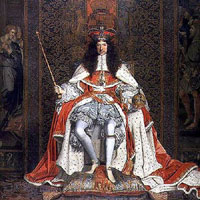
Monarchy restored May, 1660
|
|
1660
|
General George Monck had been stationed in Scotland for five years. He had been suspected of Royalist involvement but he refused to clarify his position until he marched for London on 1 January 1660, arriving on 3 February. On the way Lord Fairfax seized York and handed it over to Monck.
During his march in January he received petitions from many counties, including Suffolk, to allow the return of a "free and full Parliament." Monck was called "Your Countrie's Restorer" by those who signed the Suffolk petition at Ipswich dated 19th January 1660.
General Monck's march from Coldstream on the Scottish borders down to London finally brought down the Commonwealth.
On February 21st those surviving Members of Parliament who were excluded or "secluded" from the Long Parliament were readmitted.
At Bury St Edmunds "bonfires were lit in every street. Soldiers carrying off the fuel were stoned, and taunted that the citizens would soon be strong enough to declare for King Charles and end the rule of rogues like the soldiers."
The newly reinstated Long Parliament dissolved itself, calling for free elections. On April 25th the newly elected Convention Parliament assembled.
Even then, General Monck's intentions remained unclear until 1 May, when he recommended that Parliament should invite Charles II to return. This they did on May 8th and the Convention Parliament declared Charles II to have been King since 30th January 1649, and ordered the arrest of the regicides.
When the restored King landed at Dover on 25 May, Monck was the first to greet him as he came ashore.
Charles II was recalled unconditionally and he would rule until 1685. When Charles II was placed on the throne on 26th May 1660 this event became known as The Restoration of the Monarchy. This came as a surprise in many parts of the country.
His reign was deemed to have begun at the moment of his father's death. The law of the land as at 1649 was reinstated and all laws and transactions passed during the Commonwealth were now null and void. All lands were restored, but all fines and penalties paid were not returnable.
At Eriswell, most of the lands there had been sold to the New England Company in 1649, previously owned by the Catholic Royalist Sir Henry Bedingfield. His heir Colonel Thomas Bedingfield now claimed back all the rents and rights as Lord of the Manor. Sir Robert Boyle, a great supporter of the Company's Missionary work in New England, used his influence at Court to defend the Company's ownership of the Eriswell Estates. A Decree in Chancery confirmed the Company as rightful owner, confirmed by a Royal Charter on 10th April, 1661.
The king granted Colonel Bedingfield a baronetcy as some compensation, and Sir Robert Boyle became the Company's first President. The New England Company owned most of Eriswell for the next 200 years until it sold the estate to Duleep Singh in 1869.
The boroughs regained their old charters, and thus Bury resumed its right to return two MP's. The counties, like Suffolk, reverted to two MP's, likewise. The newly reconstituted body met as the Convention Parliament. Sir Henry Crofts of Little Saxham Hall now became one of the MPs for Bury St Edmunds, together with Sir John Duncombe. John Clark and Thomas Chaplin were replaced as candidates.
Sir Henry Crofts of Saxham had been closely connected with the courts of the first two Stuart kings, and he suffered financially during the troubles of the Civil War. He did not have to forfeit his property, although the records show that he did have to pay a sum of money to Parliament to fund the war against King Charles. His son William Crofts had been in exile with the future King Charles II, so Sir Henry must have been careful to have survived the Commonwealth period with his lands intact.
|
|

Henry Jermyn Earl of St Albans
|
|
blank |
The Baron Henry Jermyn of St Edmundsbury was rewarded by the king for his loyalty by being made Earl of St Albans. He was also made a privy councillor, ambassador to Paris, and joint Registrar of Chancery. William Crofts of Little Saxham could publicly use his title of Baron Crofts of Saxham, which he had received two years earlier from Charles II in exile. Local royalists like Gervase Elwes of Stoke by Clare and Edward Gage of Hengrave were made Baronets. They were now addressed as Sir Gervase or Sir Edward.
Some local Parliamentarians were also made Baronets to mark the new order. These included Sir Thomas Barnardiston of Kedington, his brother, Samuel Barnardiston, Robert Cordell of Long Melford, Thomas Cullum of Hawstead, and Thomas Darcy of Kentwell Hall. Thomas Blague was made a Groom of the Bedchamber.
The Barnardistons were so wealthy that Samuel moved to near Ipswich when he bought Brightwell Manor.
The Spring family of Pakenham were issued with a general pardon for their wartime activities against the Crown, particularly Sir William who had actively recruited soldiers for the Parliamentary campaign.
Along with rewards came some retribution. In Suffolk about 23 to 25 puritan clergy who had been intruded into their livings under the Parliamentary regime were evicted to reinstate the old incumbents. At Long Melford, the high churchman Robert Warren was reinstated to his living in May 1660, despite being 96. By November he voluntarily resigned his situation with a request that he be succeeded by Nathaniel Bisbie. Bisbie was probably also high church and thus immediately unpopular with a large section of his more "godly" congregation. He also attempted to reimpose all his tithes and dues of which the records had been destroyed by the mob in 1642. Bisbie was to leave behind him a considerable documentation of life and times for the parson at Long Melford in these years with the aim of protecting the rights of future holders of his office. Bisbie was himself to lose his living when he refused to swear allegiance to William of Orange in 1690.
Nationally about 13 people were executed following the Restoration, most of them for having signed Charles I's death warrant.
At Bury Grammar School, the Headmaster, Dr Stephens put the boys into a new Sunday uniform of scarlet cloaks to celebrate the Restoration.
The Convention Parliament passed an act in August 1660 ordering the disbandment of the entire New Model Army. As a special concession, Monck's regiment was scheduled to be the last to disband. Amongst other honours for his part in the Restoration, Monck was appointed Captain-General of the Army, Master of the King's Horse and created Duke of Albemarle.
We do not know when the West Front of the old St Edmunds Abbey Church, which quickly became ruined, was first adapted for people to live in it, but by this date there is evidence that at least some of it was by now converted into housing.
|
|
1661
|
On 14 February 1661, the last of the New Model Army regiments paraded on Tower Hill where the soldiers symbolically laid down their weapons — and with them their association with the New Model Army and the "Good Old Cause". They were immediately ordered to take up arms again as troops of King Charles II's new standing army. This last regiment was Monck's Regiment of Foot which would become known as the Coldstream Regiment of Foot Guards, from 1670, and later the Coldstream Guards.
The so-called Cavalier Parliament was elected in April 1661. They passed a series of laws called the Clarendon Code, starting with the Corporation Act, 1661. They wanted to rid the boroughs of those Puritans who had elected the old Parliament.
At Bury as everywhere else, the corporation were now required to take the Oath of Supremacy, acknowledging the reinstatement of the crown's power in the land, and agreeing to take communion and renounce the covenant. More than half of Bury's corporation refused to swear the oath and in 1661-2 the Crown removed 19 members of the Bury St Edmunds corporation. However, nothing could be done about the composition of the Feoffees, despite the fact that they were largely the same people. They refused to relinquish their interest in the corporate property, which had been vested in them as a ruse in 1630 before the civil war. This led to a lengthy case in chancery. The Feoffees also refused to spend any of what should have been the corporation's income on the stipends of any of the newly appointed clergy in the town. So the Corporation had to pay the clergy, while the Feoffees took all the income. This did not really get sorted out until 1668. A new Poor Law gave each Parish the responsibility for paupers either born in the Parish or apprenticed there, or worked there a year, or paid £10.00 in rates there.
Sir William Hervey had died, and been buried at Ickworth in 1660, and his wife, Lady Penelope, died a few months later in 1661. Lady Penelope had inherited Hengrave manor and other property as she had been born a Darcy, daughter of Countess Rivers. Penelope had married three times, but her children were all from her second marriage to Sir John Gage. She was buried in Hengrave church. In her will she confirmed that Lackford and Fornham St Martin would pass to her eldest son, Sir Thomas Gage, who had already inherited his father's title and estates in Firle in Sussex. Her third son, Edward Gage had already received Hengrave and Chevington in 1648. The manor of Stoneham and other East suffolk properties were left to her second son, John. Harleston was left to Henry Gage.
|
|
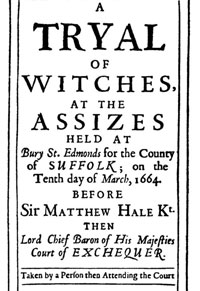
Account of witch trial
|
|
1662
|
Although the worst of the witch hunts ended in 1647, this superstition continued, and further executions resulted in 1662.
This event took place on 10 March 1662, when two elderly widows, Rose Cullender and Amy Denny (Deny / Duny), living in Lowestoft, were accused of witchcraft by their neighbours and faced 13 charges of the bewitching of several young children between the ages of a few months to 18 years old, resulting in one death. They may have been aware of each other, inhabiting a small town, but Cullender was from a property owning family, whilst Denny was the widow of a labourer. Their one other link was the fact that they had tried and failed to purchase Herrings from a Lowestoft merchant Samuel Pacy. His two daughters Elizabeth, and Deborah were "victims" of the accused and along with his sister Margaret gave evidence against the women. They were tried at the Assize held in Bury St. Edmunds under the provisions of the 1603 Witchcraft Act, by one of England's most eminent judges of the time, Sir Matthew Hale, Lord Chief Baron of the Exchequer. The jury found them guilty of the thirteen charges of using malevolent witchcraft, and the judge sentenced them to death. They were hanged in the town on 17 March 1662. Strangely enough an account of the trial published in 1682, called "A Tryal of Witches", gave the year as 1664, but this may have been an error based upon confusion over regnal years.
So called "Spectral Evidences" allowed in the Bury trials of 1645, and in this trial, were quoted as precedent in the Salem Witch Trials of 1692 in colonial America.
After the reign of Charles II (1660 to 1685) witches were still brought to trial, but were no longer executed. The witchcraft laws were not finally abolished until 1736.
Against the King's wishes, Parliament passed the Act of Uniformity which made the Church of England the official religion and all other denominations were forced underground. Puritans in the church were no longer tolerated.
The Church of England was restored along with its Bishops and Hierarchy. Having already evicted those clergy who had previously replaced evicted Anglican rectors, those puritan clergy who had always held their livings were now targetted. Some 56 ministers were evicted in Suffolk under this legislation, as well as the 23 or so, evicted in 1660.
The newly appointed Bishop of Norwich was Dr Edward Reynolds. He would be Bishop from 1661 until 1676, and had been a Presbyterian in the past. Although he followed the law in action against puritan ministers, he did not attempt to pursue them after eviction. Thus these dissenters were not persecuted as badly as they might have been.
As a result of the Uniformity Act, Stephen Scandarett, the fiery puritan preacher was ejected from his living at Haverhill. Scandarett was fervently anti-Quaker, even writing "An antidote against Quakerism". He had probably been behind incidents like the beating of the two Quaker preachers in 1656 in Haverhill. Scandarett may have continued to lead a clandestine congregation in the period from 1662 to 1672, when he would be licensed officially as a presbyterian preacher. This group represents the origins of the Old Independent Congregational Church, but the existing church of that name was not built until 1884. Following the same Act, old Samuel Fairclough, a Haverhill native, but now Vicar of Kedington, was also ejected from his living at the age of 68.
These evictions and the legislation behind them, is the reason for the division in the Protestant church in this country between Church and Chapel.
The Quakers refused to meet secretly and instead, met in public. They therefore took the brunt of official action against all non-conformists, and would suffer in this way for many years. However, by 1662, most Quakers had turned to pacifism, so avoiding the arrests for disorder that had characterised their early years.
The Guildhall Feoffees granted the Governors of the Grammar School in Bury twelve loads of timber towards building a new school in Northgate Street. This school was occupied in 1665 and today it survives as flats, known as St Michaels Close. The timber came from two farms owned by the Feoffees in Hepworth.
In 1662 Charles II introduced the Hearth or Chimney Tax at one shilling per hearth, payable on Michaelmas day and Lady Day. It lasted 27 years until abolished by William and Mary.
On 15th July, 1662, King Charles II made Edward Gage a baronet for his family's long term support of the crown. Sir Edward Gage had inherited Hengrave Hall and the manors of Hengrave and Chevington, despite only being a third son. Gage had risen to be a General during the civil war, despite his catholic religion, and had been made Governor of Oxford by Charles I. He had been shot at Cullum Bridge.
Also in July 1662, Baron William Crofts of Saxham returned to England together with his ward James Crofts. James Crofts was actually the illegitimate son of King Charles II. James had lived with his mother, Lucy Walter, in Holland until shortly before she died in 1658. James Walter, as he was then known, aged 9, was put in the charge of Baron Crofts, becoming called James Crofts. They had been living in Paris until July 1662, when the Baron and he returned from exile. By then James Crofts was just 13, but the King already had plans for his future.
|
|
1663
|
The St Edmundsbury town maces, still in use today on ceremonial occasions, were commissioned at a cost of £54. Five years later the bill was finally paid in March 1668 to a Mr John Clarke.
As the Corporation could not pay for the repairs needed to the Angel Hill, the Feoffees undertook the work. By now the Mustowe was called the Angel Hill, and this was the first record of the use of this new name.
After 1663 Turnpike Trusts could be set up in order to improve the state of the roads. They would improve the road and charge a toll to users for maintenance. The first such Trust did not arrive in Suffolk until 1711.
In 1663, James Crofts, the illegitimate son of Charles II by Lucy Walter, was created first Duke of Monmouth. He had been given the surname Crofts in 1658, after his mother died, and he was put into the guardianship of William Crofts, created Baron Crofts of Saxham for the purpose. Upon his marriage in 1663 to Lady Ann Scott, James, now Duke of Monmouth, adopted the surname of Scott, together with his titles. Lady Anne Scott, Countess of Buccleuch, was the wealthiest heiress in Britain, with an estate of £10,000 a year. They were married at Whitehall in April, 1663. At that time, Lady Anne was only 12, while James was 14.
|
|
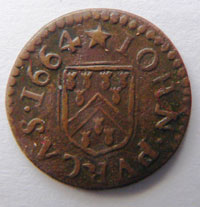
John Purcas of Bury
|
|
1664
|
The token shown here was issued by John Purcas of Bury St Edmunds in 1664. It shows the Grocers Arms, the small items shown representing sticks of cloves.
You can see more 17th Century tokens, fronts and backs by clicking here: Seventeenth Century Tokens.
In 1682 a report entitled "A Tryal of Witches", referred to the trial and execution of two Lowestoft women at Bury St Edmunds in March, 1664. More recent research has dated this trial to March, 1662, and in this Chronicle it is placed in that year.
At this time Maurice Barrow of Barningham had an annual income of £6,000 making him the richest man in Suffolk and one of the wealthiest landowners in England. He had been a Parliamentarian supporter.
|
|
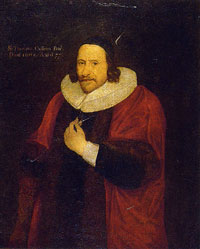
Sir Thomas Cullum, 1st baronet, d 1664
|
|
blank |
Another rich man, Sir Thomas Cullum of Hawstead and Hardwick, died in 1664, worth £43,805. He had bought the estates from Sir Christopher Wray in 1656, and he originally preferred to live at Hawstead Place, but his family would soon move to make their new home at Hardwick Hall, which was a lot newer, dating only from 1612. The great old house at Hawstead Place was gradually dismantled, used as a farmhouse and finally demolished in 1827.
The family estates now passed to his son, also called Sir Thomas Cullum, who was the second baronet of Hardwick. This Sir Thomas was to become known as a great gardener. He built a greenhouse measuring 58 feet long and 14 feet wide at the Hawstead property. Various descendants would continue this botanical heritage.
In 1664 Henry Jermyn, Earl of St Albans, and Baron of St Edmundsbury, obtained a grant of land in London near St James's Palace, where Jermyn Street preserves the memory of his name, and where he built the St Albans market on a site afterwards cleared for the construction of Regent Street and Waterloo Place. Jermyn's family home was at Rushbrook Hall.
Following the Restoration of the monarchy, horse racing again flourished under King Charles II. In 1664 the king instituted the Newmarket Town Plate, writing the rules himself, beginning as follows:
"Articles ordered by His Majestie to be observed by all persons that put in horses to ride for the Plate, the new round heat at Newmarket set out on the first day of October, 1664, in the 16th year of our Sovereign Lord King Charles II, which Plate is to be rid for yearly, the second Thursday in October for ever."
"The new round heat" referred to a new, roughly circular, race-course which was set out at Newmarket to replace the old Long Course of 8 miles length which had existed under Charles I. It also replaced the shorter Beacon Course recently run over the last four miles of the Long Course under Charles II.
At this time the king was also in the midst of building his new palace at Newmarket, having abandoned the ruined palace and stables of his father. The new palace extended from the High Street to today's Palace Street, and the King's racing yard stood on the opposite side of Palace street from the great house. A small part of Palace House survives today in Newmarket, and there are plans in 2010 to use it as part of the National Horse Racing Museum.
Depite all these developments sponsored by the King, there appears to be no evidence that the King actually attended any events at Newmarket until March 1666.
|
|
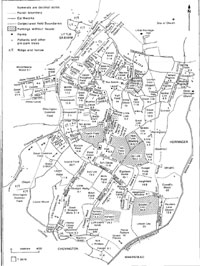
Ickworth in 1665
|
|
1665
|
In Proceedings of SIAH, volume XXXIX part 1, (1997), Mary Hesse discussed the early estate at Ickworth, intending to show Ickworth as it existed before the emparking undertaken in the early 1700s. One major source was a survey of 1665 by Thomas Cowell, made for John Hervey (1616-79), the first Earl's uncle, who
had inherited the property of Ickworth in 1660. A printed copy of this survey was published by yet
another John Hervey in 1893 (Hervey 1893, hereafter denoted by Survey). The original was formerly
accompanied by a map, which is now lost. Hesse attempted to reconstruct the layout of the estate as it must have been in 1665, using the 1665 survey of the estate together with reconstructions previously attempted in the late 1940s by John Hervey, by Phibbs and Gallagher in 1980, and by Gallagher and Owen in 1991. In 1665 the total of Hervey's estate within the parish of Ickworth consisted of about 445 acres
arable, 397 acres pasture and sixty-three acres wood. The population of Ickworth in 1665 was clearly very small, with only twelve households noted on
Hervey's estate, which then covered practically the whole parish.
Hesse noted that, "The Survey gives details of seventeen tenants of John Hervey within or immediately outside the later
Ickworth Pale. One of them, Edward Baythorne, was then living in the old Manor Hall or 'Mansion',
and had rights of sheepwalk over the common fields (when fallow) and the greens of the
Hervey estate.
There were twelve other substantial farmers, holding between 160 and twenty-nine
acres each, and four smallholdings (called 'tenements') of less than eight and a quarter acres.
Ten
of these held farm houses and other buildings from Hervey, and one of them (Robert Emyns) held
Ickworth Lodge, which appears to be on the site of the present Lodge. The Lodge and five other
tenanted houses stood near the Green about two-thirds of a mile north of the church.
In 1665 the
land tenanted by the farmers was generally in consolidated blocks, many of them behind the frontages
of their farms.
Three of them still had strips in Great and Little Common Fields.
By 1665, only these two common fields remain of what were probably extensive medieval open
fields."
|
|
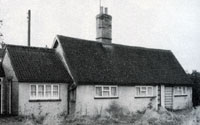
The Pest Houses
|
|
blank |
During 1665 the Great Plague broke out in London, and soon spread. Many villages around Bury were stricken. People leaving London who were already infected spread the disease to friends or relatives in the country.
At Bury St Edmunds, emergency measures were taken in the town. The Guildhall Feoffees built the Pest House as an isolation hospital in Great Sexton's Meadows, a fairly isolated location at the time. (Nowadays the site is located in the middle of housing off Boon Close.) In addition, movement restrictions were quickly put in place.
Thomas Bull, owner of the Angel, and a common carrier, was forbidden to take his usual waggon runs to London. A watch was posted at each town gate to keep out travellers, and it seems that these measures actually worked.
Despite the effective measures put in place in Bury against infection, in this plague year three Aldermen were elected in Bury one after the other, as each in turn refused to accept the office, because they would be tied to the town if plague should arrive. Fines of £35 and £50 were imposed for their refusal to accept, and only the fourth elected person, Samuel Hustler, accepted the office.
Prompt action at Bury St Edmunds meant that the new Pest Houses were not needed in 1665, as the Feoffees and the Council had succeeded in keeping plague out of Bury.
Other Suffolk towns were less successful in avoiding the disease, but where it did arrive, attempts were made to restrict further spread. One of the worst hit local places for plague was Needham Market. Chains were set up at either end of Needham and the inhabitants isolated themselves from the outside world. Food was delivered to the barriers in exchange for money left there by the inhabitants. Local tradition states that the dead were buried in two local fields. Normally the dead of Needham would be buried and registered at Barking, but during the plague this could not happen.
This isolation seems to have been fairly successful. Nearby Stowmarket escaped entirely, and there must have been an acceptance by Needham people that they would not try to leave their own village despite the death toll.
Ipswich also suffered from the Plague.
After this time the Plague seems to have died down. But by 1677 another deadly disease, the Smallpox, would terrify the inhabitants of Bury St Edmunds and district. The isolation facilities of the Pest House would continue to be needed, even if epidemics were sporadic. By the 19th century, the facilities were known as The Sanitary Hospital, Out Southgate, governed by the Infectious Disease (Notification) Act 1889.
|
|
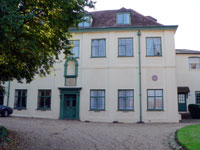
Former Grammar School
|
|
blank |
The Grammar School moved from its home in Eastgate Street, where it was probably first established in 1550, to newly built premises in 3 acres of grounds off Northgate Street. Today this site contains flats and is called St Michael's Close. It would remain here until 1883.
Until recently it was believed that the Haverhill fire destroyed most of the town in 1665. Nowadays we believe that this took place in 1667.
War with Holland had started in 1651. In June 1665 a battle off Lowestoft was won by the Duke of York who lost two ships but sunk or captured 32 Dutch ships.
|
|
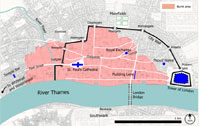
Area of London destroyed by fire
|
|
1666
|
On September 2nd, 1666, only a year after London had been gripped by the Great Plague, a good deal of the centre of that city was destroyed in a terrifying blaze that lasted for four days, until the 6th. It had burned to the ground eighty-seven churches and more than 13,000 houses by the time it was extinguished.
The Great Fire of London, as it was called, also burned down St Paul's Cathedral. The Dean of St Paul's was William Sancroft, a Suffolk man, educated at Bury Grammar School and Cambridge University. He worked with Sir Christopher Wren on its rebuilding and raised vast sums of money for the restoration work. Later he would become Archbishop of Canterbury and fall out with both James II and William III, the latter resulting in his downfall.
The non-conformist Quakers were still being arrested as they insisted upon meeting in public, but refused to attend Church of England services. For example, Edward Hall and his sister Ann were given 20 months imprisonment at Bury St Edmunds for not attending church. William Bennett had been released from Norwich Jail in 1665, but at Bury he was re-arrested and imprisoned for 8 years.
In March, 1666, King Charles II was entertained at Little Saxham Hall by Baron Crofts after spending just one night at Newmarket. William Crofts had supported the Royalist cause in the Civil War, and had been made Baron Crofts of Saxham on 18th May, 1658, in Brussels, during the exile of Charles. The two men were close, and the King would enjoy several visits to Saxham.
English sugar plantations were destroyed when the French invaded St Kitts and Antigua.
|
|
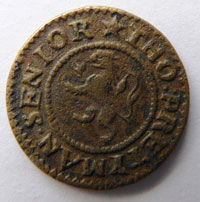
Thomas Prettyman of Bury
|
|
1667
|
The trade token illustrated here was issued by Thomas Prettyman Senior, of Bury St Edmunds. Presumably he had a son who also operated in the same trade as he felt the need to add Senior to his tokens. The lion may indicate an inn such as the White Lion in Brentgovel Street which may date back to this time. Inn keeping was a respectable and prestigious occupation at this time, and there would always be a need for a good supply of small change.
You can see more 17th Century tokens, fronts and backs by clicking here: Seventeenth Century Tokens.
Disaster was to befall the church and town of Haverhill on 14th June 1667, when a great fire started at the "Swan" and destroyed the centre of Haverhill, from Swan Lane to Duddery Hill. Parts of Queen Street and Camps Road were also affected and St Marys was gutted and with it all the parish records. For many years it was believed that this fire was in 1665, but it is now attributed to 1667. No doubt much evidence of its early history was lost at this time.
Buildings of note which are known to have been destroyed were Prenticehall, the Guildhall, Chauntry House, the Town House, and the Vicarage. These all stood around the Market Hill. Also destroyed were the Almshouses, the Daybell House and all the inns. The losses were dreadful, and Haverhill would not fully recover from the blow.
This was a disastrous episode and there was general hardship and distress. Although it was an exaggeration, it was said that "only one house and a pear tree remained". Begging letters were sent to all parts of the country in an effort to raise money to repair the damage. It was this event that robbed the town of its picturesque appearance, and with the shortage of money, the resultant rebuilding was of poor quality. A number of old houses at Hundon and elsewhere were taken down and re-erected at Haverhill to house the homeless. Many people are thought to have abandoned the town, leaving the ground to revert to the Lord of the Manor.
Today there seems to be only three buildings known to survive from Medieval times. These are the Rose and Crown, The Queens Head and Weavers in Hamlet Road. Ann of Cleves House seems the most notable, but mostly appears to date only from the early 17th century. However, its appearance has changed radically over the years, and parts are thought to date back to around 1480. After the great fire, even the vicar was made homeless, and the lord of the manor, Sir George Beaumont, gave the vicar permission to live in this house. The original parsonage, once the property of Anne of Cleves, is thus thought to be no more. In the 20th century the name Anne of Cleves was therefore mistakenly applied to the wrong vicarage.
Another incident of that momentous year involved a Haverhill mother and daughter, Mistress and Miss Boreham, who were hanged at Bury St Edmunds as witches.
Sir Henry Crofts, of Little Saxham Hall, died in March 1667 at the age of 77 and was buried at Little Saxham. Although closely associated with the royal court of James I, and his son William having gone into exile with the future Charles II, Sir Henry had managed to hold on to his estate, although he had paid fines to the Parliamentary government. William Crofts had been made Baron Crofts of Saxham during the exile in Brussels in 1658, returning to Saxham in 1662. He now inherited the estate, although in practice he probably ran the place from 1662 onwards.
On 5th June, King Charles II issued a charter which confirmed the Borough of Bury St Edmunds its earlier privileges, and gave the corporation the power to fine any member who refused to serve following his election, or who failed to appear if summoned to the Council.
A further provision was that no person could keep a shop in the Borough unless he was an admitted Freeman who had served a seven year apprenticeship. An exception was made for stalls at Markets and Fairs.
According to the anonymous Brief History of St Peter's Church at Fakenham Magna, the church has one bell dated 1500, a second from 1572 and another from 1667. According to Clouston and Pipe, (Bells and Bellringing in Suffolk), the last bells to be made in Bury had been dated from 1632, and were made by Thomas Cheese. However, the church at Fakenham Magna apparently contains a bell cast by Robert Gurney of Bury St Edmunds in 1667. It is a tenor bell of 31.437 inches, weighing 5cwt 84 lbs.
The church of St Andrews at Tostock has seven bells and the number four is a tenor, also cast by Robert Gurney of Bury St Edmunds, but dated to 1671. It has no dedication, but has an impressed pattern of coins around the rim. It is still used as part of a new peal of six bells rehung in 1999.
An earlier bell by Robert Gurney is recorded from St Andrews Church at Tottington, Norfolk, dated 1665. Its details are as follows:
Bell number 5; Weight 2tons-3cwt-26lbs; diameter 30"; pitched at the note of B; cast in 1665; Cast by - Robert Gurney, Bury St Edmunds
Tottington was the home village of Abbot Samson, but it became taken over by the army as part of the Stanford Battle Training Area, and in 1942 the church of St Andrew, Tottington, Norfolk was closed and the bells removed. This bell was inscribed "ROBARD [ GVRNEY MADE ME ] 1665", and along with the other bells from Tottington, it was re-cast in 1969 at the Whitechapel Foundry, and installed at St Alphege's church in Whitstable in Kent.
The Dutch wars continued and in July about 1000 Dutch soldiers landed at Felixstowe. They fought the Suffolk militia on the cliffs and attacked Landguard Fort. They withdrew that night.
|
|
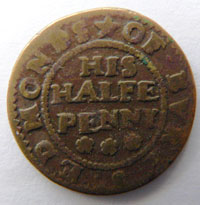
John Lucas of Bury
|
|
1668
|
From 1668 to 1670 the use of Trade Tokens was at its height. This token, issued by John Lucas, a Tobacco dealer or Tobacconist in Bury, is unlike most other Bury tokens. Most tokens refer to the town as St Edmundsbury, in various spellings. Lucas uses Bury St Edmonds as the town name. The reverse of the coin shows a Tobacco Bale as a symbol of his business, and many tokens have a reference to the Traders business in the motif chosen. You can see more 17th Century tokens, fronts and backs by clicking here: Seventeenth Century Tokens.
Another Quaker rebellion against established religion was their refusal to pay tithes. In 1668, John and Ann Fryer were imprisoned at Bury for this offence, despite having seven dependent children.
Following the lengthy lawsuit in Chancery, the Corporation of Bury St Edmunds was still trying to get back some of its assets from previous council members evicted by the crown after the Restoration of the Monarchy. Although they were legally removed from the corporation, they claimed ownership rights by virtue of the conveyance to Trustees made in 1630. In 1668 King Charles II visited the town, and to settle the matter beyond doubt, the corporation were
granted another Charter by the king which confirmed its title to the corporate estate, and to the markets and their tolls. They could now claim back everything which had previously been in council hands.
In the countryside, the Breckland area to the north-west of Bury, was suffering from constant erosion of the sandy soils by the wind. The great open treeless plains were by now well over-grazed by sheep and rabbits. This culminated in a great sandstorm in 1668, when masses of sand were blown from Lakenheath to Santon Downham, blocking the river between Brandon and Thetford, and partly burying the village. These sandblows took place between 1665 and 1670, and were described to the Royal Society in 1668 by Thomas Wright of Santon Downham Hall. Wright spent four or five years building furze hedges to hold back the sand, culminating in a bank 60 feet high. At other places in the village whole houses were either buried or collapsed by sand.
Later, John Evelyn, the noted diarist, wrote in 1677 of "….The Travelling Sands, about ten miles wide of Euston, that have so damaged the country, rolling from place to place, and like the sands in the deserts of Libya, quite overwhelmed some gentleman's whole estates….."
These events led to the story of the Breckland landowner who was asked in which county his estate was situated. The reply was said to be, " Either Norfolk or Suffolk, depending upon which way the wind is blowing." In 2001 and 2004 there were scientific papers published which examined the causes of this phenomenon, especially looking at the part played by the deteriorating climatic conditions of 1550 to 1850.
King Charles II was a regular visitor to the home of Baron William Crofts at Little Saxham Hall. One such visit was recorded in October, 1668. On this occasion Lord Arlington wrote to his secretary, "I could not speak to the king at Saxham, nor until today, by reason of the uncertainty of his motions." Drunkenness seems to have been an important part of any visit to Little Saxham at this period.
The diarist Samuel Pepys was also present since he recalls a few days later when "..the King was drunk at Saxam" and refers to "the night that my lord Arlington come thither, and would not give him audience or could not; which is true, for it was the night that I was there and saw the king go up to his chamber and was told the king had been drinking."
By 1668 the King's new palace at Newmarket was ready for his use. With his own apartments available at a moment's notice he would visit Newmarket every year of his reign after 1668. Prince Rupert also attended upon the king at Newmarket in 1668, having survived his part in the Civil War fighting for the Royalist cause. Prince Rupert was fond of sketching horses on the heath.
|
|
1669
|
At Bury, the 19 disaffected corporation members reconveyed the property to the alderman and burgesses. This had been a problem to the new corporation ever since the Restoration.
Markets and fairs were generally farmed out by Bury Corporation after this time - the lessee provided stalls, hurdles etc and collected tolls and dues, paying a fixed annual rent to the corporation.
It is not known exactly when the first dwellings were built into the ruins of the West Front of the abbey church, but this had happened by the 1660's.
|
|
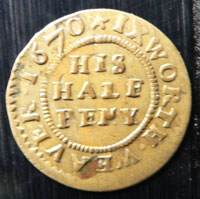
William Syer of Ixworth
|
|
1670
|
By 1670 the private production of farthing or halfpenny tokens, by traders for use as small change, was at its peak. No official coinage of this small denomination had been issued since 1644, and not until 1672 would a new issue be made. The half penny token illustrated here is in brass, made for William Syer, a weaver of Ixworth. Weavers' tokens are very common, but unlike Syer's, the word Weaver hardly ever appears on their tokens. Weavers like William Syer must have been reasonably well off at this time to need a supply of tokens for use by their customers.
King Charles II had a special relationship with Sir William Crofts of Little Saxham Hall. Sir William was known as 'Madcap' and, for a short period, was guardian of one of the King's natural sons, who was sometimes known as "Captain Crofts". This son, called James, had been made Duke of Monmouth in 1663, at the age of 13, and married off to Lady Ann Scott in April 1663, when he was 14, and she was 12. Monmouth would go on to fight his uncle James for the right to rule the country, only to be executed for his efforts in 1685.
Madcap Crofts had built a special apartment for entertaining the King when he visited, as he did in 1670. There was unbridled revelry and drinking. Sir Edward Gage of Chevington and Hengrave and a staunch Royalist, may well have attended.
The visit was recorded by the diarist Samuel Pepys, who also attended the visit in April 1670: "on the 16th the king was entertained at Lord Crofts', from whence he will go to Lord Arlington's (at Euston), and then he will pass his time in other parts till his return to Newmarket to see a race on the 27th, after which he will return to Whitehall."
The 16th April was a Saturday, since the following day King Charles II, probably somewhat the worse for wear, was treated to a lengthy sermon at Little Saxham Church. The sermon was given by George Seignior, Fellow of Trinity College, Cambridge. It is rumoured that Charles nodded off during the sermon and subsequently had to ask for it to be printed, so that he could have the chance of reading it.
Drainage works in the Fens had contributed to the silting up of the river systems inland. In 1670 Acts of Parliament were obtained for the the Improvement of the navigation on the Great Ouse and the Brandon River, or Little Ouse. An attempt to do the same for the River Lark was made in 1682.
|
|
1671
|
Euston Hall was expensively re - modelled by Sir Henry Bennett, later Earl of Arlington between 1666 and 1670. In 1671 Charles II held court there for 15 days. John Evelyn described the new restoration society there. Sir Henry Bennett's daughter Isabella married one of the King's illegitimate sons, Henry Fitzroy. Henry Fitzroy's mother was Barbara Villiers, and Henry was created first Duke of Grafton. Thus, when Sir Henry Bennett, Lord Arlington, died in 1685, Euston Hall passed to his daughter Isabella, and her husband, the Duke of Grafton. The Dukes of Grafton still reside at Euston Hall, and the Euston Estate remains intact to this day.
Charles II had been an expert horseman since he was a boy. He could ride without a saddle, was on familiar terms with jockeys and stable lads, and even entered races himself. In October 1671 he won the race for the Newmarket Town Plate, a feat he would repeat in 1675.
Sir Henry North of the Manor House at Mildenhall shot himself in the manor house in 1671 but, being lord of the manor, was buried in the parish church rather than in unconsecrated ground as was normal for suicides. The estate passed to Sir Thomas Hanmer, Henry North’s nephew, who became a famous speaker of the House of Commons. Sir Thomas extended the manor house and gave Mildenhall four almshouses and a workhouse, all in the churchyard. Hanmers owned Mildenhall manor until 1747.
|
|
1672
|
There was a brief period of toleration for non-conformists and Catholics when King Charles II issued a Declaration of Indulgence on 15th March. It became possible to apply for a license to worship in a private house. Thus quakers could avoid the obligation to attend public worship in the established church, and all the Quakers in prison were released.
Some 39 licences were issued to Presbyterian ministers in the South and West of Suffolk while the Congregationalists were more prevalent in the North-East around Lowestoft. At Bury a license was issued to Samuel Moody to hold meetings of a Presbyterian congregation at his house in Abbeygate Street. John Clarke's home at Bury was also licensed.
Stephen Scandarett, expelled from his Haverhill church living in 1662, was now allowed to get a license to become a presbyterian teacher. The house of Joseph Addy became the presbyterian meeting place in Haverhill. This congregation would become the Independent Congregational church in the next century.
Some time in the 1670s the Jesuits probably quietly moved into the Bishops Palace in the Abbey Grounds, and this became the base for their College of the Holy Apostles. Not all Catholics welcomed the presence of Jesuits. The Short family had always been Church Papists, willing to attend services of the established church while remaining Catholic. The Jesuits were the enemies of Church Papists, seeing this as an abandonment of their religion.
Parliament was aghast at the king's action on religious toleration, as was much of the population.
On May 28th, 1672, the Battle of Sole Bay was fought off Southwold. The English and French were allied against the Dutch, but the French soon abandoned the action by sailing away to the south. The battle began very early in the morning when the Dutch attacked the English fleet still lying at anchor. There were 82 English warships, with 23,00 men and 4,000 guns. The Dutch had around 60 ships. The battle was watched by large crowds on the shore, but the action was increasingly obscured by the smoke of battle. Firing only ceased as it became too dark to see. The English Admiral in charge was James, Duke of York, the future King James II. The final result was indecisive, with both sides claiming victory, but the Dutch had not captured any English ships, or landed foot on English soil.
In August 1672 the King issued a proclamation that all trade tokens were now forbidden to be made and used. It seems that this was not completely obeyed as another proclamation was issued in 1674.
|
|
1673
|
Despite the licenses available in 1672, at least 7 Quakers were arrested at Bury for avoiding church attendance.
King Charles was forced to withdraw his Declaration of Indulgence because of the outcry in Parliament against him. His brother became Catholic in 1669, and Parliament feared that the Indulgence opened the door to a Catholic monarch again.
"Britannia", a survey of Britain published by Richard Blome in 1673 described the only manufacture in Bury St Edmunds as spinning. Bury had lost its clothing manufacture as it had failed to adapt to the introduction of the new draperies over the last hundred years. Mildenhall had spinning while Newmarket was described as "Royal Patronage of racing and hunting: full of inns: spinning."
"In the southern track (of Suffolk) the great, but decaying trade is in broadcloth for beyond the sea, the western cloths having outstript."
Haverhill was noted by Blome for fustians, Clare for says, and Sudbury for says. Only Clare, Haverhill, Nayland and Sudbury had therefore adopted the "new draperies", as they were known. Lavenham was noted for clothing and Stowmarket for "tammeys and other Norwich stuffs." Lavenham "is a large clothing town enjoying a pretty good trade, having a good market on Tuesday, which is the more frequented by reason of a famous lecture there." As Bury had suffered, so had Ipswich grown to overtake it as the largest town in Suffolk. Norwich and Colchester were the dominant producers of the New Draperies in the region, based upon their Dutch Protestant Refugee populations started in the late 1560's.
Blome also noted that linen production was considerable in the Woodland and North East of Suffolk.
However, Blome also thought that at Bury the situation "of the town is exceedingly pleasant." He also commented that "the Air as much famed as any in England, which draws the gentry thither from several distant places."
|
|
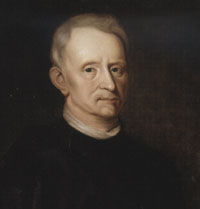
Robert Hooke by Mary Beale
|
|
1674
|
In 1674 Robert Hooke had been Curator of Experiments for the Royal Society since 1662. This portrait from 1674 has only recently been identified as a picture of Robert Hooke, although some authorities still refute this. It was painted by Mrs Mary Beale, who was born in Barrow, in Suffolk, but was now working in London. She was probably the first professional woman portrait painter. The Royal Society was founded in 1660, and Hooke had made his name by publishing his "Micrographia", a series of highly detailed drawings of micro-organisms, made with the aid of a microscope.
The Hearth Tax returns for 1674 survive as a complete record of every household in the country and the number of hearths in every home.
Hearth tax returns showed that Suffolk had 18 very large houses with over 30 hearths. The biggest was Hengrave Hall, home of the Gage family, with 51 hearths. Melford Hall was only slightly smaller, with 49 hearths.
At the other end of the scale, people were exempt from the hearth tax if they could not pay parish rates, or they owned less than £10 in goods or their house was worth less than £1 a year. In most villages about a quarter of properties would be wholly exempt.
Some people lost money when the King issued a new proclamation forbidding the issue and use of trade tokens. Traders all over the country including Suffolk, had needed to use their own tokens for small change because of a shortage of royal coinage. Since his proclamation of 1672 also forbidding tokens, the King had managed to get his own new small coins into circulation, and after 1674 the use of trade tokens rapidly died out as they became worthless.
In Haverhill Quaker Lane became so called when a Quaker burial ground and meeting house was established there. Quakers were fined and prosecuted throughout the 1660's and 1670's for their religious beliefs.
Thomas Milway became minister of the Bury Independent Church. He fostered Independent congregations in villages around Bury, particularly in Chevington, Rede and Hargrave.
|
|
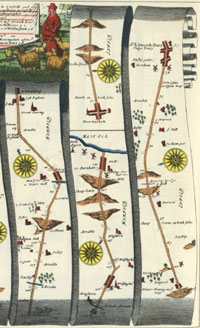
Ogilby's Strip Maps
|
|
1675
|
It seems that in 1675, John Ogilby was the first to compare Bury to Montpelier, well known as a health resort at the time. John Ogilby, (1600-1676) had started his career as a Dancing Master, then became a private tutor, and was a book translator by the time of the Fire of London. After losing his property in the fire, he moved to Whitefriars where he set up his business with a printing press, specialising in large and ambitious books, including lavish works of cartography. He was commissioned to produce three volumes of road maps of England but completed only one before his death in 1676. He aimed to describe the most significant of the designated post roads in a time before the turnpikes altered the whole picture.
In 1675 he published what was effectively the first road atlas of Britain in his book, "Britannia". This consisted of a series of 100 strip maps of the main roads in the country at a scale of 1 inch to a mile. They included instructions to travellers on how to find their way from London to the towns along the main routes. Strip maps, or itineraries, were the first method used for such route maps, and show only those villages, towns and notable features along a route, omitting all the surrounding countryside.
The illustration shows part of a strip-map by 'the King's cosmographer and geographic printer', John Ogilby. It shows the road from Newmarket to Wells, Norfolk, and Newmarket to Bury St Edmunds, one of the main roads in Britain at the time. These were the first set of road maps ever produced.
|
|
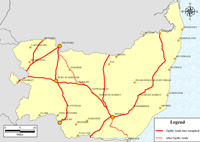
Suffolk roads in 1675
|
|
blank |
The route from London to Norwich showed the road from Cornhill, London to Puckeridge, then Barkway, Newmarket, Barton Mills, Thetford, Larlingford, Attleborough and Wyndham to the city of Norwich at 108 miles distance. Travellers to Bury would leave this road south of Barton Mills at Red house and make their way eastwards to Tuddenham, across the heath to Temple Bridge, Icklingham, and then via Flempton and Fornham All Saints to Bury St Edmunds.
Ogilby measured his distances in the Statute miles, as laid down in a Statute of 1593, which said that a mile was henceforth to be reckoned as 1,760 yards. However, there were local variations in the definition of a mile at this time. The old British mile had been reckoned as 2,428 yards and this continued to be used, particularly in the north, right through the 17th century.
You can view more pages from Ogilby's Britannia by clicking here:-
Ogilby's Roads through Suffolk
In 1674 John Ogilby had published a street map of Ipswich. Bury St Edmunds did not get a street plan produced until 1741, produced by Alexander Downing.
|
|
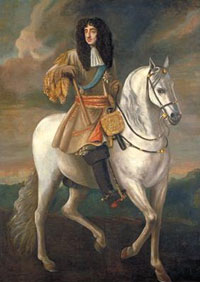
Charles II by Sir Peter Lely
|
|
blank |
Charles II continued to visit Newmarket at least once a year, as had been his practice since 1668, when his new palace first became available for occupation. In April, 1675 he entered a horse race for the Town Plate at Newmarket, and came first. It is possible that this event led him to commission Sir Peter Lely to paint his portrait showing him astride his horse set in a country landscape.
It was also in 1675 that we find the first record of Tregonwell Frampton at Newmarket. Henry Coventry, in a despatch dated March 1675, mentions a horse-racing match ‘wherein Mr. Frampton, a gentleman of some 120l. (£120) rent, is engaged 900l. deep.’ This meant that Frampton had bet £900, over seven times his annual income, on one horse. This was to be a feature of Frampton's whole life at Newmarket. He won this wager, and in the racing records of the time his name appears more frequently as a winner than a loser, the amounts at stake being higher than was usual.
Tregonwell Frampton was born in 1641 at Moreton, Dorset, the fifth son of William Frampton, lord of the manor of Moreton. He would become well known for his extravagant betting, his drab attire and mournful face, and his familiar manner with his betters. Eventually he became "keeper of the running horses" to William III, Queen Anne, George I and George II, and was referred to as the "father of the turf" in the 1791 engraving of him by John Wootton. When he was not horse racing, he was devoted to hawking, hare coursing, and cock-fighting, all of which were available in, or around, Newmarket.
|
|
1676
|
In 1676 a new register of recusants was drawn up. A register of Catholics who failed to attend a Protestant Church (ie recusants) was compiled in accordance with the 1606 'Act for the better discovering and repressing of popish recusants'. The churchwardens and constables of towns were required to bring to the Quarter Sessions all the recusants who had not attended a Church of England service for a month.
The Compton census of 1676 measured the sizes of the minority religious congregations. Wattisfield had 49 independents and Hepworth had 37. Bury had 167 dissenters and Clare had 300, Sudbury had 100, and Mildenhall had 66. The Bury non-conformists were divided across the existing parishes within the town. The parish of St James held 53 of the total number and St Mary's parish contained 114 of them.
As for Catholics, these tended to be clustered around local gentry families of that religion. There were 16 at Stanningfield, around the Rokewoods. There were 30 at Long Melford which had the Catholic gentry Martin, Harrison and Hinchlow families. Wetherden seems to have been the exception to this rule as this village had 18 Papists, with no local member of the gentry to protect them.
Bury had 40 Catholics, and despite being a Dissenters town, was the centre of Suffolk Catholicism. At some point over the next decade the East Anglian headquarters of the Jesuit College of the Holy Apostles was established in the Abbey Ruins in St Edmundsbury. The organisation had been set up in 1633 to provide for the needs of Roman Catholics in the eastern counties. It should be noted that both the catholic Rookwoods of Stanningfield and the Gages of Hengrave also had town houses in Bury, so their influence also reached well into the town.
In October 1676, in the fourth of King Charles II's recorded visits to Little Saxham Hall, Richard Gipps of Little Horringer Hall was knighted at Saxham. The King was entertained by William Crofts and his stays at Saxham were reported to be for the pursuit of pleasure. He would also use Saxham as a base for attending horse races at Newmarket.
In 1979 Dr John Patten estimated the population of Bury at 4,500 in 1603, and 6,200 by the 1670's. Bury was second in population size in Suffolk to Ipswich. Ipswich was 5,000 in 1603 and 7,900 by the 1670's. In 1603 Ipswich had been only 11% bigger than Bury, but was now 27% bigger.
|
|
1677
|
An outbreak of smallpox hit the area. According to the local historian Samuel Tymms, it would revisit the town in 1684 and 1718. In his book "West Suffolk Illustrated", Horace Barker wrote that it is said that the cavity in the base of the old boundary cross in Out Risbygate was filled with vinegar at this time. This was supposedly to allow the money taken to and from market to be disinfected against the spread of the disease. This stone has been called the Plague Stone for at least the whole of the 20th century. It has been moved at least twice (once in 1878, and once in the mid 20th century) and now stands in front of West Suffolk College.
|
|

Mrs Mary Beale
|
|
blank |
In London, the Barrow born artist, Mrs Mary Beale, was having her best ever year for commissions. She made £429 from 83 paintings in this year. Her clients were the Protestant clergy and landed gentry, who wanted portraits, as well as pictures of their children. Sometimes members of the nobility sought her out. She was by now a truly professional female artist, perhaps the first in Britain.
King Charles II was a well known womaniser who enjoyed the sporting life of Newmarket. But at night he worked on his dispatches in his bedroom, and he was well aware of the religious fervour around himself and the court. He was a practising Anglican, but was always suspected of harbouring Catholic sympathies. Charles knew that he had to support the protestant line if he was to retain his power. His brother James was much more open in his support for Catholicism, and had married the Catholic Mary of Modena, and himself converted to Catholicism, in 1673. Because the king had no legitimate heirs, his Catholic brother James thus became the heir apparent. James had a daughter called Mary, and to further establish his own Protestant credentials and those of the royal family, the King insisted upon a Protestant marriage for her. She was to marry the Protestant William of Orange. This marriage was arranged at the court in Newmarket, and without this arrangement the events which would follow in 1688 would never have happened.
Baron William Crofts of Little Saxham Hall, passed away childless on 11 September 1677 and was buried at St Nicholas Church, Little Saxham. His title became extinct and his estate at Little Saxham was inherited by his cousin, also called William Crofts.
The public postal service had begun during the 1630s. By 1677 the headquarters of the Postmaster General was in Bishopsgate in London, and this was the hub of the postal service. The mail for East Anglia would be sent out every Tuesday, Thursday and Saturday at a price for a one sheet letter of 2d for every 80 miles. A letter would be expected to cover 120 miles in 24 hours.
|
|
1678
|
This was the year of a fictitious Popish plot, fabricated by Titus Oates to discredit Catholics. This led to the years 1679 to 1681 when Catholics were severely persecuted. In December William Gage, the Catholic owner of Hengrave Hall took a retinue abroad to avoid trouble. So did Catholics Sir Roger Martin of Long Melford, and Ambrose Rookwood of Coldham Hall. A number of other Catholics were imprisoned for a short time, including Henry Jermyn of Rushbrooke.
Some Catholics blamed the uncompromising attitude of the Jesuits for the persecution. At Bury, Richard Short junior was one of their most prominent critics, and subscribed to the idea that Catholics ought to swear an Oath of Allegiance to the monarch. Jesuits refused this idea because the monarch claimed to be Head of the Church in England, ahead of the Pope.
Meanwhile, the Quakers in Bury continued to be prosecuted for refusing to attend the Anglican church. In 1678 Robert Prick of Bury was imprisoned for refusing to pay towards repairs to the parish church, and for not paying "Easter offerings". He served 14 months.
|
|
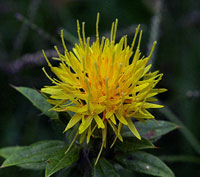
Safflower for dyestuffs
|
|
blank |
The Reverend Nathaniel Bisbie at Long Melford kept extensive records of the transactions of his church and his own income. He levied the usual tithes on crops of corn etc, and in 1678 he recorded that Henry Waddington at Cranfield farm was growing 40 acres of Safflower, from which red and yellow dyes could be extracted. These dyes were used locally in the woollen industry. (Another name for safflower is bastard saffron from the fact that its dried flowers can be passed off as true saffron.) Bisbie tythed the safflower crop the same as if it were corn. However, in a good year it was much more profitable than corn, but the flowers were more prone to disease, resulting in more poor years. Nowadays it is more likely to be grown in drier places like Turkey for its culinary use or for medicinal oils.
|
|
1679
|
The Habeas Corpus Act looked directly back to Clause 39 of the Magna Carta. "No free man shall be seized or imprisoned, or stripped of his rights or possessions or outlawed or exiled or deprived of his standing in any other way, nor will we proceed with force again him, or send others to do so, except by the lawful judgement of his equals or by the law of the land."
|
|
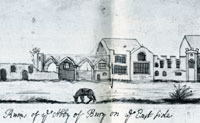
Abbot's palace in 1680
|
|
1680
|
Following the dissolution of the Abbey of St Edmund in 1539, the monastery precincts were now in private hands. The Jesuit College of Holy Apostles was established within the old Abbot's Palace. This view shows the Abbot's palace, looking from the river to the east side of the ruins. It was drawn in 1727 by Edmund Prideaux, showing how it looked in about 1680.
The free Burgesses of Bury asserted that the election of Sir Thomas Hervey and Thomas Jermyn as MP's for Bury was wrongly conducted. They said that as the major part of the free burgesses wanted Sir Thomas Cullum and John Rotherham, the Alderman was wrong to return Hervey and Jermyn. It was judged that the electorate was the Alderman, 12 capital burgesses and 24 burgesses of the common council. The Freemen of the town had no vote in the matter.
On the weather front, 1680 began a run of cold winters up to 1700.
|
|
1681
|
Thomas Baskerville described Bury as ' a very beautiful inland town, full of rich shops and tradesmen, the streets spacious and well built. Gentry do much frequent this town.'
From 1678 to 1681 was a period known as the Exclusion Crisis. The argument was over the position of the Duke of York, the future King James II. Politics split between those who were against him ever coming to the throne, who were called Whigs, and those in favour, called Tories.
These terms continued in use long after the crisis was over. Tories came to represent the landed interest, were High Church Anglican and supported hereditary divine rights.
Whigs became the monied classes, were Low Church Anglicans, tolerant of Dissenters, and supported a constitutional monarchy.
These groupings were to provide the beginnings of political parties in England.
In the period from 1681 to 1688 King Charles II, and from 1685, King James II really tried to impose an absolute monarchy on the country, on the continental model. Bullying of Parliament was followed by the bullying of local corporations.
At Hardwick, Sir Dudley Cullum, the third baronet, made great additions to Hardwick House. The statue of Hercules was moved there from Hawstead Place, along with a stone porch. Like Sir Robert Drury before him, he removed treasures from Hawstead Place to liven up Hardwick House.
Sir Dudley Cullum was a botanist of note, and would become High Sheriff of Suffolk in 1690, and MP for Suffolk in 1702. On his death in 1720, the estates would pass to a cousin, Jasper Cullum of Middlesex.
|
|
1682
|
Robert Davers was created a Baronet by Charles II. He had made a fortune in sugar in Barbados and could now afford to buy the Rougham estate. He died in 1685 leaving a son, Robert junior.
In 1682 the Society of Friends acquired a house for £50 in Long Brackland in Bury. It was probably not part of the site they still occupy today. Warren's map of 1748 shows the Quaker Meeting House in Long Brackland, but in the part still called Long Brackland today. In 1682 today's Long Brackland and today's St John's Street were one street called Long Brackland along its entire length. The modern street name of St John's Street did not arrive until the 19th century. Today's site in St Johns Street was acquired for the Quakers in 1752.
The River Lark was by now silted up and unsuitable for navigation by barge. In 1682 an Act of Parliament was sought to improve it, according to Mason and McClelland. However, it is thought that this probably refers erroneously to the Act of 1699/1700.
|
|
1683
|
In March, 1683, Newmarket suffered a great fire. This might have had the effect of saving the King, Charles II, from a plot to ambush and kill him. The King and the court were in Newmarket as usual at this time of year for the racing and other sporting activities. The royal party were expected to make their return journey to London on 1 April 1683, but as there was a major fire in Newmarket on 22 March, which destroyed half the town, the travel plans were changed. The races were cancelled, and the King and his brother, James, Duke of York, returned to London early. As a result, the planned attack at Rye House, near Hoddesdon, never took place.
The motive for the attack was the King's sympathy towards the Catholic religion, and his brother's known conversion to Catholicism in 1673.
The fire is said to have destroyed most of the north side of the High Street of Newmarket.
|
|
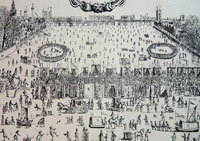
Frost Fair 1683-84
|
|
1684
|
The winter of 1683-84 was one of the coldest winters on record in England. One of the most celebrated Frost Fairs took place on the River Thames, although such events, less prolonged, had happened several times in the 16th and 17th centuries. This one lasted from 20th December, 1683 until 6th February, 1684 and the ice was up to 18 inches thick. One man, a Mr Croom, set up a printing press on the ice and sold printed cards personalised for the customer to vouch for their attendance. There were reports of trees cracking open with a noise like the explosions of fire-arms, as the sap froze and expanded. Fuel became so expensive that the poor needed emergency charitable relief.
The last Frost Fair was in 1814 and lasted just 4 days from 1st February.
Bury Quakers petitioned the King saying that 18 of their congregation had been held in Bury Gaol for 8 months, and that one, Joseph Chisnal, had died. We do not know the outcome of this petition.
In 1684 Charles II became fed up with those boroughs which were misguided enough to fail to send the "right sort" of MP's to Parliament. He wanted to pack the House with Tory voting Protestants, and so invented a new packaged charter which was imposed upon various towns including Bury.
On 3rd July 1684, this Charter, which reconstituted the corporation, came into effect.
The Corporation of Bury St Edmunds now became governed by this new Charter of Charles II which gave the crown the right to nominate Council members. The reason for this was to ensure that the King's policies on religion would be supported locally, and this control lasted until 1688. The numbers of members remained the same, but they now became called the Mayor, Alderman and Burgesses of Bury St Edmunds. There were to be 12 Aldermen and 24 Burgesses. This Charter gave the town the right to have a sword of state carried before the Mayor on formal occasions.
Sir John Hervey presented the Borough with a sword of state and a red velvet covered scabbard which is still in use today.
Samuel Tymms recorded a further outbreak of smallpox in Bury in 1684.
In October 1684 Charles II attended his final horse races at Newmarket.
|
|
1685
|
In 1685, King Charles II, also sometimes called the jockey king for his prowess on horseback, died suddenly on February 2nd, aged only 54. Although he had at least seven illegitimate children, his wife had suffered only miscarriages and stillbirths, and so he was succeeded by his brother James.
The Catholic James II came to the throne, and in his short three year reign he aimed to free Roman Catholics from the legal penalties imposed upon them by current laws. He had hoped that his presence on the throne would encourage the people to return to Catholicism of their own accord. But he had not understood how much the people were still suspicious of that religion and what it might mean for their future.
The anti-Catholic laws remained in place, but were unenforceable without incurring the new King's displeasure.
Emboldened by a Catholic sympathising king, the East Anglian headquarters of the Jesuit College of the Holy Apostles was more formally established in the Abbey Ruins in St Edmundsbury. The Abbot's Palace was probably purchased and new building work was carried out. These improvements were to be short lived, and destroyed by a mob in 1688. The College of Holy Apostles had been set up in 1633 to provide for the needs of Roman Catholics in the eastern counties. Sometimes clandestine, often peripatetic, it had very likely been in Bury St Edmunds since the 1870s.
For a brief period until 1688 the Town Corporation included Catholics, and Non Conformists as well as Anglicans. One such councillor was Dr Richard Short, who lived in Risbygate Street. The Shorts had always been "Church Papists", which meant that , although Catholic, they were prepared to attend the Church of England services, and thus avoid the penalties levied on recusants.
The Shorts came to Bury in the 1590s from Timworth, and there were several branches of the family. They were always Catholic, and usually followed the medical profession, having to qualify abroad because of their religion.
Because of their willingness to compromise over church attendance, the Shorts were opposed to the Jesuits presence in Bury St Edmunds. They opposed the new school and instead applied pressure on the Bury Grammar School to admit Catholics. Thomas and Richard Short served on the Bury Corporation, along with the new Catholic Mayor John Stafford, whose brother Nathaniel was a Jesuit.
Protestants were troubled by these changes, but were to become much more fearful after the news from France.
In 1685 the Catholic king of France, Louis XIV, revoked the Edict of Nantes which had guaranteed the religious and civil rights of Huguenots. These were French subjects, mainly living in Normandy and Picardy, who followed the Protestant faith. All now had to convert to Catholicism or face persecution. Eventually this change would lead about half a million Huguenots to flee from France. Some of these were silk weavers, and many of them moved to Spitalfields in London. At the time Spitalfields was outside the jurisdiction of the London guilds of weavers, and so the immigrants could set up weaving businesses comparatively unmolested. This industry would eventually move out to the Stour valley, founding the silk factories of Sudbury and Haverhill.
In 1685 the Earl of Arlington died, and his home, Euston Hall passed to his daughter. She was the wife of Henry Fitzroy, the 1st Duke of Grafton, and the Dukes of Grafton have lived here ever since.
|
|
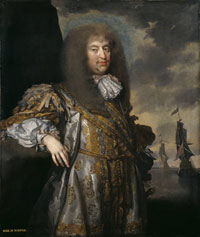
Suffolk Regiment origins
|
|
blank |
The Suffolk Regiment has a 274 year history, and was originally raised by the Duke of Norfolk in 1685, as the Duke of Norfolk's Regiment of Foot, to suppress the threatened Monmouth Rebellion. Their first stations were at Great Yarmouth and Landguard Fort in Felixstowe. Charles II's eldest son, the Duke of Monmouth, did lead a rebellion against James II, but was defeated at the Battle of Sedgemoor on 6 July 1685, captured and executed.
In 1686 the new Colonel was Edward Lee, Earl of Lichfield, and from this date the Regiment took the name of its Colonel at the time. In 1713, while in Minorca, the regiment was designated the "Twelfth Foot", and this name stuck with it as 'The Old Twelfth' or 'The Old Dozen', ever since. The name became the 12th (East Suffolk) Regiment in 1782, and the Suffolk Regiment in 1888.
|
|
1687
|
King James issued Declarations of Indulgence which freed both Catholics and Dissenters from religious persecution, giving them civil rights and freedom to worship.
By 1687 King James II had found that the population had not spontaneously returned to Catholicism under his rule. Parliament would never repeal the Test Acts and the penal laws against Catholics of its own volition. So James II followed Charles II's lead and continued to insist upon nominating members of town corporations himself. Because the crown had issued new charters in 1684, the King controlled the Boroughs and hence controlled who the Boroughs elected to Parliament. However this king wanted the opposite sort of men to Charles II. James wanted Catholic or Dissenting corporations who would send like minded MP's to oppose the Protestant Tory Parliament.
King James II also decided to increase the numbers of Catholic JP's. Some Anglicans were dismissed and Catholics appointed in their place. In Suffolk Ambrose Rookwood of Stanningfield and Edward Sulyard of Haughley, were two local Catholics made up to Justice of the Peace at this time.
Things were even worse in the Colonies. At Ipswich, Massachusetts, spiritual descendants of the Puritan Nathaniel Ward from Haverhill in Suffolk, were in uproar. Ipswich Mass. calls itself the Birthplace of American Independence because, in 1687, Ipswich citizens protested a tax that English Governor Sir Edmond Andros attempted to impose on the colony. Ipswich residents, under the leadership of Reverend John Wise, led the protest, arguing that as Englishmen they could not abide taxation without representation. The citizens were jailed and fined for their action.
|
|
1688
|
In April 1688 the King ordered his Second Declaration of Indulgence, granting freedom of worship, to be read out in Church pulpits. Seven Bishops were arrested for denouncing the Declaration. One of these was William Sancroft from Suffolk, who was currently the Archbishop of Canterbury.
On 29th June the courts acquitted all the bishops to tumultuous public acclaim. Clearly the King was getting nowhere with his religious toleration policies using current tactics.
By now King James II was starting to enforce his will on local corporations to force them to adopt Catholic MP's, or at least, anti - Tory MP's. Lord Dover, the King's agent in this matter, sent the St Edmundsbury corporation a royal instrument ordering that 16 named members would be replaced by Crown appointees.
Three separate Orders were sent to Bury by Lord Dover. These were on 16th March, 14th May, and 18th September 1688. The Lord Dover was Henry Jermyn, 3rd Baron Jermyn and 1st Baron Dover. Born about 1636, he was the second son of Sir Thomas Jermyn, of Rushbrooke, Suffolk, who died in 1659. Being a Roman Catholic, he enjoyed a position of influence with King James, who on his accession raised Jermyn to the Peerage as Baron Dover in 1685, and appointed him Lieutenant-General of the Royal Guard in 1686.
The Mayor of St Edmundsbury, Richard Pryme, was replaced by John Stafford, an elderly Catholic silk merchant. Stafford had the job of cajoling the rest to support the king, and if necessary, finding the replacements. Eventually the council passed a resolution to send the King the type of letter of loyalty which he had required. Even so, sixteen names were missing from it.
The point of all this was to select the "right" sort of MP's to send to London, and before this was achieved, another 13 Council members had to be replaced.
Bury now had four Catholic members as well as the Mayor. They were Ambrose Rookwood of Stanningfield, Dr Thomas Short, Dr Richard Short and Henry Audley, an Essex man with some land in Suffolk. Eight others were Dissenters, who the King found expedient to elevate as they might be expected to vote for religious toleration, including one Quaker. The rest, 23 in all, seem to have been Anglicans willing to support the king's policies, but details are unclear.
While this was happening, the King's second wife, Mary of Modena, had given birth to a son. The prospect of a Catholic dynasty spurred on Seven leading Whigs and Tories to issue an invitation to William of Orange on 30th June to defend English liberty and the Protestant religion.
By October, it was clear that the country would not put up with any more of this. William of Orange landed in the country at Torbay, on the 5th November supported by his 20,000 strong army and those Englishmen who wanted to ensure England remained protestant. James retreated back to London and then became unwell and lost his nerve and attempted to flee the country, trying as he goes to throw the great seal of England into the Thames. The Crown's nomination rights lapsed when James II finally fled the country on 23rd December, 1688.
This event was called the Glorious Revolution, but was actually an invasion by a foreign power, albeit with the support of most of the country. The old Charters were reinstated and at Bury it seems to have resulted in the reversion, once again, from Mayor and Aldermen to the old constitution of Alderman and Burgesses.
John Stafford the Catholic Mayor, was replaced by Martin Spensley, with the title of Alderman.
Crowds took to the streets to celebrate. Unfortunately the king had advanced the Catholic cause too hard, and there was now a backlash against Catholics. Riots ensued in London and various other places, including Bury St Edmunds, with Catholic chapels being the first targets.
In early December, 1688, the rabble of Bury St Edmunds joined the Cambridge mob in a march on Cheveley in Cambridgeshire. Here, Henry Jermyn, the First Baron of Dover and a great supporter of James II, had a Catholic chapel at his magnificent home in Chevely. The Catholic chapel was pulled down and the house was wrecked. The Bury mob went home and was quiet for a few days.
The Catholic Mayor of Bury, John Stafford, was now accused of trying to blow up the Guildhall. Such rumours were inflamed when another rumour that Irish soldiers were marching on the town was spread.
On 20th December the Bury mob went on the rampage again. The recently built Jesuit college, known as the Mass House, in the old Abbot's Palace in the Abbey grounds was their main target. Both Jesuit school and chapel were pulled down, stone by stone. The remains were set on fire until it was destroyed down to ground level.
One Catholic had been killed trying to defend the chapel and the houses of two Catholics were torn down by the mob before the local gentry halted the violence. The Jesuits fled to the house of Thomas Burton at Beyton and made no attempt to return to Bury.
The mob, who were described as the Mobile, ie vagrants and paupers, now roamed the streets of Bury looking for more targets.
The homes of several Catholic members of the old corporation were ransacked, including John Stafford's. However, newspaper reports at the time said that they also rifled both Papists and Protestants, Test Men and Anti-Test Men, without distinction.
Test Men were those who supported the Anti-Catholic Test Acts, and thus should have been immune in these riots.
About 10 people were said to have died in these riots in Bury before the Magistrates restored order, imprisoning those they could catch.
Roman Catholic worship did not come out in the open in Bury again until the Westgate Street chapel was built in 1760 - 1762.
At the Glorious Revolution, Henry Jermyn of Rushbook, the Lord Dover, adhered to the deposed King James, whom he followed abroad, and in July 1689 the exiled sovereign created him Baron Jermyn of Royston, Baron Ipswich, Viscount Cheveley and Earl of Dover in the Jacobite Peerage. Despite these new titles not being recognised by the English Government, Dover nevertheless became generally known as the Earl of Dover. He commanded a troop at the Battle of the Boyne; but shortly afterwards made his submission to King William III. He succeeded his brother Thomas as 3rd Baron Jermyn in 1703, and died in 1708. As he left no children by his wife, Judith, daughter of Sir Edmund Poley, of Badley, Suffolk, his titles became extinct at his death.
The hereditary Stewardship of the Liberty of St Edmund had been in the hands of the Howard family since at least 1536. In 1688 the post, and all its revenues, was sold by James Howard, the 3rd Earl of Suffolk, for £1,100. The buyer was Thomas Hervey, Lord Jermyn of Ickworth, and the post remained in the Hervey family until it was abolished, along with West Suffolk County Council, in 1974. Under a financial arrangement, Lord Jermyn let out half of the stewardship to Thomas Folkes of Rushbrooke, but the post remained in Lord Jermyn's name.
|
|
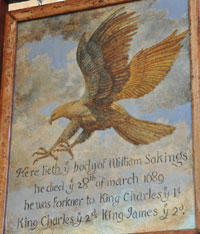
William Sakings, Great Livermere
|
|
1689
|
This sign used to be the reverse of the village sign for Great Livermere. It is now replaced by a new sign, but this one now hangs inside Great Livermere Church. The wording is taken from a gravestone which stands just outside the main porch. It suggests that William Sakings was a native of Great Livermere, who became so famous as a falconer that he was engaged by three different kings to look after and to fly the royal falcons. It is possible that he could have kept the birds in East Anglia as Newmarket Heath, and various Breckland estates, were favourite sporting venues for royalty. William Sakings died in March, 1689.
In the New Year, Sir Robert Davers and Sir Thomas Hervey were finally sent to London as Bury's MP's, and took part in the Parliamentary debate, after which William of Orange and his wife were invited to cross the Channel and rule the Country.
Their joint reign began in February 1689, when they were offered the throne by Parliament, replacing James II, who was "deemed to have fled" the country in the Glorious Revolution of 1688. Parliament offered them co-regency at the couple's behest.
They became known as William III and Mary II.
Sir Robert Davers (the second) was to be Bury's MP until 1701. He was re-elected in 1703 to 1705, after which he represented Suffolk until 1722. He had estates at Rougham and Rushbrook. Both Sir Robert Davers and Sir Thomas Hervey were Tory MP's.
Parliament passed the Bill of Rights in 1689 to lay down the principles by which they agreed to be ruled by the new Monarchs. It tried to avoid the type of arbitrary rule imposed by James II. Parliament was to be freely elected, and there could be no taxation or standing army without parliamentary approval. Roman Catholics were to be excluded from ever succeeding to the throne.
With the new royal family come permanent toleration for nonconformist Protestant religions, by way of the Toleration Act of 1689. Suffolk was a stronghold of nonconformity and its practitioners now became established and respectable. However, some clergy refused to swear allegiance to King William. They were called the non-jurors and about 23 Suffolk clergy were evicted for this offence. Three were in Long Melford, the rest spread across the county. The Melford evictions included Nathaniel Bisbie, who is known to us for his extensive documentation of the transactions of his living, and of local conditions. He died in 1695.
Nationally the Non-Jurors were Archbishop Sancroft and his six Bishops, and 400 lesser clergy, including the 23 in Suffolk.
William Sancroft was born in Fressingfield in Suffolk in 1617, but was educated at Bury St Edmunds Grammar School and at Cambridge university. He was a Royalist, and was Dean of St Pauls when it burnt down in 1666. He became Archbishop of Canterbury in 1678 and had resisted King James' Declaration of Indulgence in 1688, being imprisoned for it. But he felt it was wrong to de-throne a King in principle. He was suspended from office and evicted from Lambeth Palace. He returned to Fressingfield and lived like a hermit in a poor cottage until he died in 1693.
Other supporters of King James in exile were called Jacobites, and Norwich was a centre of East Anglian Jacobitism. Suffolk had few Jacobites apart from the religious Non-Jurors.
After the new king and queen were settled in, King William III spent 10 days at Newmarket without the Queen. He would refurbish the palace there and in the 1690s would have the gardens re-modelled by Henry Wise, the royal gardener. As there was no chapel in the palace, he attended services at the All Saints church. Although King William III would spend a total of 37 days at Newmarket from 1689 to 1702, this was a mere fraction of the time that Charles II had enjoyed there. The new King enjoyed sporting pursuits, but did not spend too much time on them, and by 1700 Newmarket was fading out of royal favour.
Most of the old Presbyterians had gone back to the official church after the Restoration, but a few had quietly kept to Presbyterian ideals. After the Toleration Act they started to build a Meeting House at the top of Churchgate Street. However, this is not the building which we see today, which came in 1711. They could do this provided they got a license from a JP.
The Toleration Act did not allow freedom of worship to Catholics, Jews or Unitarians. Neither did it allow Dissenters to hold public office or become MP's. They were still second class citizens. However, this amount of toleration was ahead of the continent, and was acceptable to the bulk of the population.
At Ipswich there was a mutiny by the Royal Scots Regiment of Foot, en route for Holland. They ran amok in Ipswich and declared support for King James II. They were tried for High Treason at Bury Assizes, but were given a Royal Pardon. This uprising resulted in the passing of the Mutiny Act of 1689.
By this time, Bury Fair was so well known that Thomas Shadwell named a play after it.
|
|
1690
|
The 12th Regiment of Foot stormed Carrickfergus Castle and were in the Battle of the Boyne on 6th July 1690. Gradually the links to Suffolk strengthened as more and more recruiting was done in this County.
The decade of the 1690s was to prove one of the coldest decades on record.
|
|
1691
|
Dr Francis Young has studied the Catholic congregation of Bury St Edmunds, and following the demise of the Jesuits in Bury, states that:- "the Shorts took advantage of the vacuum, and in 1691 they established a town mission led by a secular priest (meaning he belonged to no religious order) called Hugh Owen. Owen, who was born in the Isle of Man, remained in Bury until his death in 1741. In the early days, he may have ministered from the Short family home in Risbygate Street, but by the 1730s he was based at the Greyhound Inn on Cornhill, which later became the Suffolk Hotel and is now divided between Waterstone’s and Edinburgh Woollen Mill.
The Greyhound was owned by a Catholic landlord, William Adams. Owen sometimes also ministered at the Angel and at a coffeehouse called Hannibals."
Catholic worship thus continued in the town, but without a formal church or chapel.
|
|

Cupola House weather vane
|
|
1693
|
Thomas Macro built the Cupola House in the Traverse at Bury. This event was recorded upon its weathervane, and a similar weathervane still adorns the building in 2011. It says the letter 'M' above the letters 'T S' and under these the date 1693. 'T' stands for Thomas, and 'S' for Susan, his wife's initial, in the fashion of the time. Thomas Macro was an apothecary, and was rich enough to construct a building which rivalled the Market Cross in height.
This house would be noticed particularly by Celia Fiennes on her visit in 1698. She would comment that, "The Market Cross has a dyal and lanthorn on the top, and there being another house pretty close to it high built with such a tower and lanthorn also.........This high house is an apothecarys, at least 60 stepps up from the ground and gives a pleasing prospect of the whole town, that is compact severall streetes but no good buildings; except this the rest are great old houses of timber and mostly in the old forme of the country which are long peaked roofes of tileing; this house is the new mode of building four roomes of a floore pretty sizeable and high well furnish'd, a drawing room and chamber full of China and a Damaske bed embroyder'd, 2 other roomes, Camlet and Mohaire beds, a pretty deale of plaite in his wives chamber, parlours below and a large shop; he is estemed a very rich man; he shewed me a Curiosity of an Herball all written out with every sort of tree and herb dryed and cut out and pasted on the leaves - it was a Doctor of Physicks work that left it to him as a legacy at his death, it was a fine thing and would have delighted me several dayes but I was passant.............."
Henry Ashley, the proprietor of the Great Ouse Navigation, was turning his attention to the River Lark. The Lark had become silted up and was no longer suitable for barge traffic. Ashley had plans to canalise the Lark and to be able to run barges up to Bury St Edmunds, thus restoring the ancient trade links to Kings Lynn. He was already having discussions with landowners along the river. In March, 1693, he made an agreement with William Gage of Hengrave Estate to allow him an exemption from all canal tolls on the River Lark for coals, fuel, corn, fodder and materials for building or reparation work to be used in or about Hengrave Hall. His River Lark Navigation Bill was already pending in Parliament.
|
|
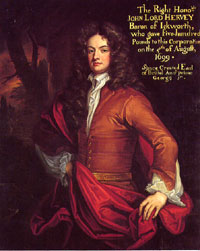
Lord John Hervey
|
|
1694
|
John Hervey took over his father's seat as one of Bury's MP's. Unlike his father and Sir Robert Davers, John was a Whig. It was said that his life revolved around family, Ickworth and the corporation of Bury. He was a local boy, educated at Bury Grammar School and knowing all the local hierarchy, he tried to keep in with everybody. This portrait was prominently displayed when the Manor House was a museum at Honey Hill, Bury St Edmunds.
The other MP, Sir Robert Davers had been brought up to run a sugar plantation in the West Indies, and as a result, he lacked classroom teaching, and he was said to read and write worse than a seven year old.
The last witch trial in Bury St Edmunds was in 1694 when Lord Chief Justice Sir John Holt, "who did more than any other man in English history to end the prosecution of witches", forced the acquittal of Mother Munnings' of Hartis (Hartest) on charges of prognostications causing death. The main charge was of Maleficia: casting a spell on her landlord causing his death. The second charge was of having a familiar imp in form of a polecat, and having two black and white imps. The chief charge was 17-years-old, the second brought by a man on his way home from an alehouse. The black and white imps were believed to have been two balls of wool. Sir John "so well directed the jury that she was acquitted". Sir John Holt bought Redgrave Hall in 1702, and he died in 1710, and was buried in Redgrave church.
Queen Mary II died in 1694 and William III now ruled alone.
|
|
1695
|
It is thought that in around 1695 Tregonwell Frampton was first appointed to the duties of the position ascribed to him on his tombstone of ‘keeper of the running horses to their sacred majesties William III, Queen Anne, George I and George II.’ In October of 1695 he won with the king's horse the town plate at Newmarket, and in the accounts of the master of the horse for the same year there is mention of a payment to him ‘for settling the establishment of racehorses at the Green Cloth and Avery, and for a plate at Newmarket.’
Frampton had been well known for being an avid follower of hawking in his home county of Dorset. He pursued this hobby at Newmarket after he arrived around 1675. He quickly became notorious for his heavy gambling on horse races, hawking, hare coursing, and cock-fighting. He was particularly successful with his cocks, and his taste was largely shared by William III, who, during his visits to Newmarket, spent afternoons watching his trainer's cocks fight. The Newmarket Cockpit was located conveniently at the top of Palace Lane. Parts of the building survive as an Italian restaurant today.
In 1695 the House of Commons refused to renew the Licensing Act of 1662, which had aimed to control the production of printed matter by way of licensing all printing presses. After this date it became viable for new printing presses to be set up in provincial towns. This opened the way for provincial newspapers to be introduced. It also led to the pirating of existing books and pamphlets by local printers, who could print them at a cheaper rate than the established presses. The first known newspaper in East Anglia was the Norwich Post, which may have had its first issue around 1701. It is only known from a surviving copy dated 1st May 1708, but numbered 348.
|
|
1696
|
A plot was discovered to overthrow the new King and restore a catholic supremacy. One of the men involved was the Catholic Ambrose Rookwood of Stanningfield, who had, for a short time in 1688, been an Alderman on Bury Corporation. He had been one of James II's replacement corporation members. Along with some others he was executed at Tyburn for Treason.
Following the plot to assassinate King William III and return James II to the throne, an Association was formed to demonstrate the extent of public support for William. The Association drew up an Oath of Allegiance to King and the new Constitution and aimed to circulate it around the country gathering signatures. This Association Oath Roll shows that 70,000 people in Suffolk signed up to it. In Norfolk only 48,000 signed, despite having 210,000 people to Suffolk's 153,000.
|
|
1697
|
In 1697 a law was passed to require local authorities to erect signposts on highways to assist travellers in finding their way along the King's Highways. However, the roads were in a very bad state, relying totally upon the underlying local geology and the state of the weather for their useability. Where the soil was clay, a rainy day would render the roads impassable. In a hot summer large cracks would appear. For this reason, despite the availability of wheeled carts and carriages, most goods were still moved by strings of pack horses or donkeys, and people travelled mostly on horseback.
Other problems for travellers included the definition of distances. In the north a mile was still defined as 2,428 yards despite the introduction of the statute mile of 1,760 yards in 1593. Celia Fiennes and other travellers at this time noted that miles grew longer as one travelled northwards. Celia reckoned her own measurements as "long miles."
|
|

Celia Fiennes 1698 journey
|
|
1698
|
Celia Fiennes visited Bury St Edmunds in 1698, as part of a great circular tour of England from London up to Newcastle and Carlisle, and down to Cornwall, thence returning to London. She travelled the country between 1685 and 1710 and always recorded the trips in her journal. Celia Fiennes was born in 1662 in Newton Toney near Salisbury. Her father was Colonel Nathaniel Fiennes who had fought for Oliver Cromwell during the Civil War, and her grandfather was Lord Saye and Sele. Her mother was strongly non conformist and Celia inherited the family outlook on religion and whiggish politics. Her journal was written partly for her own record, and possibly with an eye to publication. However, although parts of it were published in 1812, the full account was not seen in print until 1888. An improved and corrected edition was published in 1947 by the historian Christopher Morris, and re-published by him in 1982.
Her stop at Bury was thus just one more small town on her grand tour. She thought 'the prospect was wonderful pleasant,' and 'there are a great deal of Gentry which lives in the town.' She also noted that there were many dissenters in the town, with 4 meeting places including those for the Quakers and Anabaptists.
Celia Fiennes entered East Anglia via Bishops Stortford, Dunmow and on to Colchester. She noted that Dunmow relied on spinning and preparing bays, and that it was 22 miles to Colchester, "mostly clay deep way." Colchester, she wrote, "formerly there was 16 churches, tho' now much of it is ruinated." This refers to the destruction left by the siege of 1648, still evident after 50 years. Again she noted that "the whole town is employed in spinning weaving washing drying and dressing their Bayes." Teasels were used in frames to comb and dress these materials. She noted that Colchester was remarkable for "exceeding good oysters, but its a dear place." She meant that prices were high here.
From Colchester she went to Dedham and on to Ipswich. "This is a very clean town and much bigger than Colchester is now." "There is but 3 or 4 good houses in the town, indeed the town looks a little disregarded, and by enquiry found it to be thro' pride and sloth." Miss Fiennes noted that the quayside could take ships of up to 300 'tun', but she felt that the locals had failed to set up any manufacturing to take advantage of this fact, so that "the ships that bring their coales, go light away." "This town has many dessenters in it."
From Ipswich she rode to Woodbridge and then Saxmundham. "The wayes are pretty deep, mostly lanes very little commons." On to Blyford and Beccles, "which in all is 36 miles from Ipswitch - but exceeding long miles- they do own they are 41 measured miles."
As Beccles was low lying it was subject to flooding, "so that the roade lay under water which is very unsafe for strangers to pass, by reason of the holes and quicksand and loose bottom. The people of Suffolk and Norfolk knitt much and spin, ... others at their wheeles out in the streete and lanes as one passes." "The miles here are as long again as about London, and pretty deep way especially after raines, these miles are much longer than most miles in Yorkshire."
Norwich "is walled round full of towers, except on the river side...they seeme the best in repair of any walled city I know." "A rich thriving industrious place." "Boys, girls and old people ..spin yarn, as does the whole town besides for the Crapes, Callimanco and Damaskes which is the whole business of the place. ... They are all employed in spinning knitting weaving dying scouring fulling or bleaching their stuffs."
From Norwich Miss Fiennes passed to Wymondham, which she sensibly spelled Windham. Here she rode along a Causeway or Causey, and had to pay a penny a horse to repair it, as it was only passable in dry summer. On to Attleborough "then over an open down like Salisbery plaine still finding the country full of spinners and knitters."
"Thence to Thetford which was formerly a large place but now much decay'd and the ruins only shows its dimentions...... Next day I went to Euston Hall." ..... "At the back gate I crossed over the river Waveny, and pass'd over perfect downs champion country just like Salisbery Plaine, and the winds have a pretty power here and blows strongly in the winter not well to be endured."
|
|
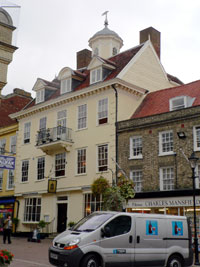
Apothecary's House
Now called Cupola House
|
|
blank |
"So to St Edmunds-bury; I pass'd by two or three little villages and there is the town of St Edmunds Bury which appeares standing on a great hill; the towers and buildings look so compact and well together with the trees and gardens thick aboutit the prospect was wonderfully pleasant. A mile off by a little village I descended a hill which made the prospect of the town still in view and much to advantage. The Market Cross has a dial and lanthorn on the top, and there being another house pretty close to it high built with such a tower and lanthorn also, with the two churches towers and some other buildings pretty good made it appear nobly at a distance. This high house is an apothecarys, at least 60 stepps up from the ground and gives a pleasing prospect of the whole town, that is compact and severall streetes but no good buildings. Except this the rest are great old houses of timber and mostly in the old form of the country which are long peaked roofes of tileing. This house is the new mode of building four roomes of a floore pretty sizeable and high.......parlours below and a large shop. He is estemed a very rich man. ........."
"There was two streets were broad and very long out of which run across 5 or 6 streetes more, which are as good as in most country towns, they were well pitch'd with small stones; there are many Descentors in the town 4 Meeteing places with the Quakers and Anabaptiss, there is only the ruines of the Abby walls and the fine gate at the entrance that remaines stone well carv'd; it seemes to be a thriving industrious town 4 gates in it.
There are a great deale of Gentry which lives in the town tho there are no good houses but what are old rambling ones, they are in that they call the Green, a space by the Churches which are pretty near together, they are pretty large but nothing curious in them, stone buildings, no monuments worth notice; they keep them very clean and neate and have a moveable scaffold to clean the roofe and windows and walls; its a very dear place so much company living in the town makes provision scarce and dear, however its a good excuse to raise the reckoning on strangers."
Celia now moved on to Chippenham Park. "It stands 3 miles from New Market you ride in sight of New Market heath where the races are, its good road."......."From thence I went 8 mile to Ely which were as long as the 12 I came from St Edmundsbery, the ways being very deep its mostly lanes and low moorish ground, for 4 miles together I passed over a low ground on each side deffended by the fendiks which are deep ditches with draines. The Fens are full of water and mudd. These also encompass their grounds, each mans part 10 or a dozen acres a piece or more, so these dicks are the fences, on each side they plant willows so there is 2 rows of trees runns round the ground which looks very finely to see a flatt of many miles so planted, but it must be ill to live there; all this while Ely minster is in ones view at a mile distant you would think, but it is a long 4 miles. I descended from a steep hill and and so cross a bridge over water which enters into the Isleand of Ely, and so you pass a flatt on a gravel Causey which way the Bishop is at a charge to repair else there would be no passing in the summer; this is secured by some dikes which surrounds more grounds as the former, full of rows of trees, willows round them which makes Ely look finely through those trees, and that stands very high."
"In the winter this Caussey is overflowed and they have no way but boates to pass in; they cut peat out of some of these grounds; the raines now had fallen so as in some places near the city the Caussey was covered and a remarkable deliverance I had, for my horse earnest to drinke ran to get more depth of water than the Caussey had, was on the brinke of one of those diks but by a special providence which I desire never to forget and allwayes be thankfull for, escaped; that bridge was over the River Linn [The Ouse - ed.] which comes from Norfolk and does almost encompass the Island of Ely."
"........the dirtyest place I ever saw, not a bit of pitching in the streetes so its a perfect quagmire the whole Citty.......for want of pitching it seems only a harbour to breed and nest vermin in , of which there is plenty enough, so that tho my chamber was near 20 stepps up I had froggs and slow worms and snaules in my room. ......There is no tradeing in the town, their main buisiness and dependence is on draining and fencing their grounds and breeding and graseing cattle."
In 1698 King William III spent 13 days at Newmarket. This was a big public event as he had only visited there twice before, in 1689 and 1695. It was at this visit to Newmarket that he received the French Ambassadors to discuss the terms for ending the Nine Years War with Louis XIV of France. He also wanted to discuss the future of Spain, as its King was near to death. The Ambassador was well treated by the King, who took him to the cockfighting, hare coursing and the horse races.
|
|
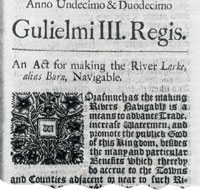
Lark Navigation Act
|
|
1699
|
In the 11th and 12th year of William III's reign was enacted "An Act for making the River Larke, alias Burn, Navigable." This Act has been dated in modern times as either 1699 or 1700. The general preamble stated that "the making of rivers navigable is a means to advance trade, increase Watermen, and promote the public good of this kingdom, besides the many and particular benefits which thereby do accrue to the towns and counties adjacent or near to such rivers."
You can read the full text of this Act by clicking here: River Lark Act of 1699 (Use your browser's 'back' button to return here.)
Henry Ashley, his heirs and successors, were empowered to make the River Lark navigable from Long Common, which was just below Mildenhall Mill, to Eastgate Bridge in Bury St Edmunds. At this time the river was still navigable from Kings Lynn up to Long Common in Mildenhall.
|
|
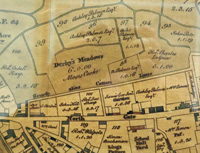
Ashley Palmer - Warren's map of 1791
|
|
blank |
At first the Corporation supported the work. In August 1699 they agreed to help scour the bed of the river at Bury. Ashley explained that his plan was for wharfage to be built from the Northgate towards the Eastgate along the river. In Warren's map of 1791, showing land ownerships within Bury St Edmunds, we can see a block of land holdings in the name of Ashley Palmer. By 1791, the Lark Navigation and all its assets had been inherited by Palmer. This block of holdings was undoubtedly originally acquired by Henry Ashley for the purpose of building his wharfage here, with access to both Cotton Lane and Northgate Street.
Local traders objected to these plans, despite the fact that Ashley intended private traders to be able to construct their own wharfs alongside his own. In the end he offered to withdraw from any interest in wharfage at Bury, but for some reason the plans continued to be rejected. His navigation had to be terminated outside the Borough boundary, which crossed the river at the location of Tollgate Bridge. The nearest available land was on the northern side of the Priory Estate, adjacent to today's Somerfield supermarket store.
It would take until 1715 for the works to be completed.
You can see a full history and geography of the River Lark Navigation by clicking here: Story of the Lark Navigation
The River Lark had clearly acquired its name by this time, but was alternatively known as the Burn, or the Bourne. There is a theory that the River Lark was named after Lackford, as the village name implied that it was a ford for the Lack or Lark in earlier times.
Mary Beale died in 1699. She was born at Barrow, just outside Bury St Edmunds, in 1633, the daughter of the Rector of Barrow, John Cradock. She married Charles Beale and moved to London where she set up a studio as possibly the first professional woman artist. She made a living by painting portraits and was highly rated by her contemporaries. A collection of her pictures was on display in the Manor House museum in Bury St Edmunds, following a bequest by Richard Jeffree in 1993. Her paintings were moved into Moyse's Hall Museum in 2007.
In 1699 King William IV passed 9 days at the palace in Newmarket, but this was to be his final visit before his death in 1702.
|
|
Quick links on this page
Top of Page 1539
Kett's Rebellion 1549
Haverhill's two churches 1551
Lady Jane & Queen Mary 1553
England Catholic again 1555
England Protestant again 1559
Suffolk has own Sheriff 1576
Royal Progress to Norwich 1578
Spanish Armada 1588
Suffolk's Puritan clergy 1597
Gunpowder Plot 1605
Bury's first Charter 1606
Bury gets two MP's 1614
Hard times in Bury 1622
Laud attacks Puritans 1633
First Civil War 1642
Second Civil War 1648
King Charles I executed 1649
Restoration of Charles II 1660
Euston Hall society 1671
King now runs Corporation 1684
Glorious Revolution 1688
Celia Fiennes Tour 1698
|
|
1700
|
To follow events into the
18th century please click here.
|
Originally prepared for the St Edmundsbury
website
by David Addy, June 1998 - August 2003
Mapping by Chris Williams
Photography of Museum exhibits and pictures by Graham Portlock
Books consulted
"The History and Antiquities of Hawstead and Hardwick" by The Revd. Sir John Cullum Bart FRS, FSA, Second Edition 1813
"The History and Antiquities of Hengrave in Suffolk", by John Gage esq., FSA, 1822
"The Diary of John Rous 1625-1644" edited by M A Everett Green, Camden Society, 1856
"Suffolk" by Lilian Redstone, 1930
"The Book of Bury St Edmunds"
by Margaret Statham.
"Yesterdays Town" by Margaret Statham
Borough of St Edmundsbury Official Guide
1976 edition.
"Jankyn Smyth and the Guildhall Feoffees"
by Margaret Statham.
"Chevington" by Frank Cooper, 1984
"Ketts Rebellion 1549" by Matthew Champion.
"Bloody Mary and the Suffolk Martyrs" by Jenny Webb and St Mary's School, Hadleigh.
"A History of Suffolk" by David Dymond and Peter Northeast.
"The History of Eriswell" by W H Donnan, 1956
"Suffolk and the Great Rebellion 1640-1660" by Alan Everitt 1960
"The Suffolk Regiment" by Guthrie Moir, 1969
"A Short History of Glemsford" by Rev Kenneth W. Glass 1962 available at Foxearth and District Local History Society
"John Donne and his World" by Derek Parker, 1975
"The illustrated Journeys of Celia Fiennes" editor Christopher Morris, 1982
"Lavenham - Industrial Town" by A Betterton and D Dymond, Second edition 1989
"The Bury Stirs Revisited," by J S Craig, in the Proceedings of SIAH Vol 37, part 3, 1991
"Background to Breckland", by H Mason and A McClelland, 1994.
"An Elizabethan Progress" by Zillah Dovey 1996
Proceedings of SIAH, volume XXXIX part 1, (1997), Mary Hesse on 1665 Ickworth
"The Lark Valley", by the Lark Valley Association c1999
"Newmarket from James I to the Present Day", by Laura Thompson, 2000
"Long Melford- the last 2,000 years." Edited by Elizabeth Wigmore for Long Melford Historical and Archaeological Society. 2000 & 2003
"Tudor and Stuart Suffolk" by Gordon Blackwood, 2001
"Savage Fortune", edited by Lynn Boothman and Sir Richard Hyde Parker for the Suffolk Records Society, 2006
"London The Illustrated History", by Cathy Ross and John Clark for the Museum of London, 2008
http://www.uoregon.edu/~rbear/kemp.html for Will Kemp's own account of Nine Daies Wonder
"The Mammals of Suffolk" by Simone Bullion, for the Suffolk Wildlife Trust and Suffolk Naturalist's Society, 2009
"Lost Country Houses of Suffolk" by W M Roberts, 2010
Lectures on Newmarket of James I to Queen Ann by John Sutton at Sutton Hoo
"Catholics in Bury St Edmunds, 1660–1789" - lecture by Dr Francis Young, 2015
Online at Catholics in Bury St Edmunds
|






































































































